| Kevin Ayers: "Whatevershebringswesing"
(EMI/Harvest, Jan. 1972) |
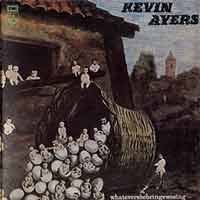 Der
ehemalige Softmachine Sänger/Bassist hatte in den 70ern eine
mehr oder weniger erfolgreiche Solokarriere gestartet. Hier kam wieder
das "psychedelische Element" stärker zum Tragen, das bei
Softmachine zugunsten einer ernsthaften Jazzrock-Ausrichtung geopfert
wurde. Als Gast wirkt sein ehemaliger Bandkollege Robert Wyatt
mit (der auch bald Softmachine verlassen wird). Der auffälligste
Name in der Besetzungsliste ist allerdings der damals noch recht junge
Mike Oldfield als Gitarrist und Bassist, kurz vor seinem Durchbruch
zu Weltruhm mit dieser unsäglichen "Tubular Bells"-Platte.
Insgesamt ein versponnenes, sympathisches Album. Der
ehemalige Softmachine Sänger/Bassist hatte in den 70ern eine
mehr oder weniger erfolgreiche Solokarriere gestartet. Hier kam wieder
das "psychedelische Element" stärker zum Tragen, das bei
Softmachine zugunsten einer ernsthaften Jazzrock-Ausrichtung geopfert
wurde. Als Gast wirkt sein ehemaliger Bandkollege Robert Wyatt
mit (der auch bald Softmachine verlassen wird). Der auffälligste
Name in der Besetzungsliste ist allerdings der damals noch recht junge
Mike Oldfield als Gitarrist und Bassist, kurz vor seinem Durchbruch
zu Weltruhm mit dieser unsäglichen "Tubular Bells"-Platte.
Insgesamt ein versponnenes, sympathisches Album. |
| J.J. Cale: "Naturally" (Mercury/Shelter,
Jan. 1972) |
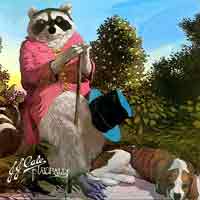 Nachdem
Eric Clapton mit "After Midnight" erfolgreich war, bekam
J.J. seine eigene Chance und nutzte sie. Neben "After Midnight"
seien erwähnt: "Call Me The Breeze" und "Magnolia". Nachdem
Eric Clapton mit "After Midnight" erfolgreich war, bekam
J.J. seine eigene Chance und nutzte sie. Neben "After Midnight"
seien erwähnt: "Call Me The Breeze" und "Magnolia". |
| Jerry Garcia: "Garcia
(The Wheel)" (Warner Bros., Jan. 1972) |
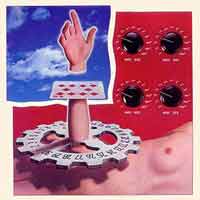 Diese
Platte hat Jerry (fast) alleine aufgenommen, er wurde nur vom Dead-Trommler
Bill Kreutzmann unterstützt. Enthält neben einigen Soundexperimenten
ein paar tolle Songs, die schnell den Weg in das Bühnenrepertoire
der Dead fanden: "Deal", "Birdsong", "Sugaree",
"Loser", "To Lay Me Down" und "The Wheel". Diese
Platte hat Jerry (fast) alleine aufgenommen, er wurde nur vom Dead-Trommler
Bill Kreutzmann unterstützt. Enthält neben einigen Soundexperimenten
ein paar tolle Songs, die schnell den Weg in das Bühnenrepertoire
der Dead fanden: "Deal", "Birdsong", "Sugaree",
"Loser", "To Lay Me Down" und "The Wheel".

 Mehr ...
Mehr ...
This disc was a happy byproduct of the Grateful Dead resigning
with Warner Bros. It was mutually beneficial for Bob Weir (guitar/vocals)
as well as Mickey Hart (percussion), and his criminally overlooked debut
long player Rolling Thunder (1972). Jerry Garcia's (acoustic guitar, electric
guitar, pedal steel guitar, bass, piano, organ, samples, vocals) simply
titled Garcia (1972) is arguably the most solo of all these projects, as
only he and the Grateful Dead's Billy Kreutzmann (percussion) contribute
instrumentally. That said, Robert Hunter's lyrics should not be underestimated
as all six of his co-compositions became staples in the Dead's live songbook
for the remainder of their concert career. The infusion of new material
can be attributed to the lack of any Dead-related releases since Workingman's
Dead (1970), over 14 months earlier. Although Garcia is the primary musician
on the ten tracks, he has given each arrangement a wholly unique persona.
These range from straight-ahead blues-based rock 'n' roll ("Sugaree")
to the avant-garde ("Late For Supper"). Within those extremes
are discerning renditions and solid performances of stone gems such as the
noir folkie "Loser," as well as the lilting balladry of "Bird
Song" and the cyclical psychedelia of "The Wheel"; the latter
of which features some of the finest pedal steel guitar work to have come
from Garcia's brief infatuation with the twangy instrument. He brings an
intimacy to the affective love song "To Lay Me Down" that was
rarely equalled by the Grateful Dead. His prowess as an emotive pianist
can be heard throughout not only that cut, but also on the trippy medley
consisting of the previously mentioned "Late for Supper," "Spidergawd,"
and "Eep Hour." Ever the self-effacing artist, at the time of
release the guitarist overtly downplayed the album as "overindulgent."
Time has rendered that assessment utterly false, as Garcia is nothing short
of a full-bodied artistic expression from one of rock & roll's most
multi-faceted musicians. Both initiated Deadheads as well as enthusiasts
of the burgeoning early-'70s singer/songwriter movement will find much to
cherish on this recording as Jerry Garcia redefines his immense talents
and seemingly undiluted musical potential.
(Lindsay Planer, www.allmusic.com) |
| Rolling Stones: "Exile On
Main Street" (Rolling Stones, Jan. 1972) |
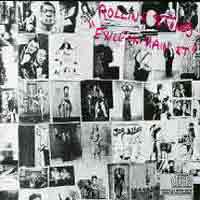 Das Meisterwerk der Stones.
Das Meisterwerk der Stones.

 Mehr ...
Mehr ...
"A dirty whirl of blues and boogie, the Rolling Stones'
1972 double LP "was the first grunge record," guitarist Keith
Richards crowed proudly last year. But inside the deliberately dense squall
-- Richards' and Mick Taylor's dogfight riffing, the lusty jump of the Bill
Wyman/Charlie Watts rhythm engine, Mick Jagger's caged-animal bark and burned-soul
croon -- is the Stones' greatest album and Jagger and Richards' definitive
songwriting statement of outlaw pride and dedication to grit. In the existential
shuffle "Tumbling Dice," the exhausted country beauty "Torn
and Frayed" and the whiskey-soaked church of "Shine a Light,"
you literally hear the Stones in exile: working at Richards' villa in the
south of France, on the run from media censure, British drug police (Jagger
and Richards already knew the view from behind bars) and the country's onerous
tax code. The music rattles like battle but also swings with clear purpose
-- unconditional survival -- in "Rocks Off" and "All Down
the Line." As Richards explained, "The Stones don't have a home
anymore -- hence the Exile -- but they can still keep it together. Whatever
people throw at us, we can still duck, improvise, overcome." Great
example: Richards recorded his jubilant romp "Happy" with just
producer Jimmy Miller on drums and saxman Bobby Keys -- while waiting for
the other Stones to turn up for work. Exile on Main Street is the Stones
at their fighting best, armed with the blues, playing to win.
Total album sales: 1 million" (Rolling Stone) |
|
| Brinsley Schwarz: "Silver
Pistol" (United Artists, Feb. 1972) |
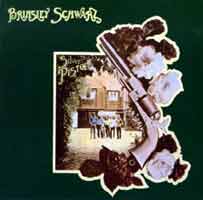 Nach
dem gescheiterten Versuch ihres Managements, die Band mit ihrem Debüt
1970 in New York als das "Next Big Thing" zu etablieren,
machte die Band um Nick Lowe
(voc, bg, Songwriter), Bob Andrews (keyb), Namensgeber Brinsley
Schwarz (g), Drummer Billy Rankin und Neuzugang Ian Gomm
(voc,g) eine Wendung um 180°, um fortan in den englischen Kneipen
zu spielen: der "Pubrock" war geboren. Die Musik auf "Silver
Pistol" ist extrem laidback und sehr amerikanisch ausgereichtet.
Nick Lowe, der als Solist und Produzent später sehr erfolgreich wurde,
bezeichnete ihre Musik mal als den Versuch, "Rag Mama Rag" von
"The Band" neu zu erfinden (m. E. kein schlechtes, wenn auch
ein sehr hohes Ziel!). Neben den Songs von Lowe (und auch Gomm) sei besonders
auf den Rock'n'Roll-Klassiker "Juju Man" hingewiesen, den später
Dave Edmunds zum Hit machte und den ich mit meiner Band Rusty
Nails in den 80ern auch sehr gerne live gespielt habe. Nach
dem gescheiterten Versuch ihres Managements, die Band mit ihrem Debüt
1970 in New York als das "Next Big Thing" zu etablieren,
machte die Band um Nick Lowe
(voc, bg, Songwriter), Bob Andrews (keyb), Namensgeber Brinsley
Schwarz (g), Drummer Billy Rankin und Neuzugang Ian Gomm
(voc,g) eine Wendung um 180°, um fortan in den englischen Kneipen
zu spielen: der "Pubrock" war geboren. Die Musik auf "Silver
Pistol" ist extrem laidback und sehr amerikanisch ausgereichtet.
Nick Lowe, der als Solist und Produzent später sehr erfolgreich wurde,
bezeichnete ihre Musik mal als den Versuch, "Rag Mama Rag" von
"The Band" neu zu erfinden (m. E. kein schlechtes, wenn auch
ein sehr hohes Ziel!). Neben den Songs von Lowe (und auch Gomm) sei besonders
auf den Rock'n'Roll-Klassiker "Juju Man" hingewiesen, den später
Dave Edmunds zum Hit machte und den ich mit meiner Band Rusty
Nails in den 80ern auch sehr gerne live gespielt habe. |
| Al Green: "Let's Stay
Together" (Hi, Feb. 1972) |
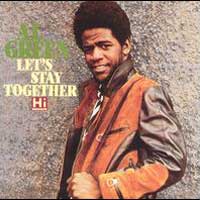 Ich kann zwar nicht behaupten, dass ich mich besonders gut mit Soulmusik
auskenne - Al Green aus Memphis vom legendären Label Hi-Records gehörte
in den 70ern sicherlich zu den großen schwarzen Stimmen: vielleicht nur
vergleichbar mit Marvin Gaye. Oder Otis Redding, wenn dieser
nicht zu früh verstorben wäre. Später wurde er zum Priester
in Memphis (mit eigener Kirche, wie z.B. auch Solomon Burke), zog
sich ganz aus "weltlicher Musik" zurück, nur gelegentlich
von kurzen Ausflügen in die Popmusik unterbrochen. In den 80ern war
er eigentlich nur durch Tina Turners Coverversion vom Titelstück
des Albums im Gespräch. In den 90ern gab's einen witzigen Gastauftritt
bei Ally MacBeal. Im Jahr 2003 kehrt er nun mit einem neuen Album
"I Can't Stop" zurück, das so klingt als hätte es
diese 30 Jahre Unterbrechung zwischen den beiden Alben nicht gegeben!
Ich kann zwar nicht behaupten, dass ich mich besonders gut mit Soulmusik
auskenne - Al Green aus Memphis vom legendären Label Hi-Records gehörte
in den 70ern sicherlich zu den großen schwarzen Stimmen: vielleicht nur
vergleichbar mit Marvin Gaye. Oder Otis Redding, wenn dieser
nicht zu früh verstorben wäre. Später wurde er zum Priester
in Memphis (mit eigener Kirche, wie z.B. auch Solomon Burke), zog
sich ganz aus "weltlicher Musik" zurück, nur gelegentlich
von kurzen Ausflügen in die Popmusik unterbrochen. In den 80ern war
er eigentlich nur durch Tina Turners Coverversion vom Titelstück
des Albums im Gespräch. In den 90ern gab's einen witzigen Gastauftritt
bei Ally MacBeal. Im Jahr 2003 kehrt er nun mit einem neuen Album
"I Can't Stop" zurück, das so klingt als hätte es
diese 30 Jahre Unterbrechung zwischen den beiden Alben nicht gegeben!
(15.12.2003)

 Mehr ...
Mehr ...
| "Prior to this album, Al Green never had a number one
song. The title track, "Let's Stay Together," achieved that status
and held it for nine consecutive weeks. Green's ingenuity produced one of
the all-time classics, which has the bounce of a dance cut and the passion
of a ballad. The dynamic soul singer's whispers, animated cries, and riffing
enhance his already stirring delivery. This album was sold on the strength
of the title track as there were no other selections to grace the Billboard
charts. However, this album includes the timeless gem "How Can You
Mend a Broken Heart" and lesser-known beauties like the exulting "Judy,"
the cookin' testimonial "I Never Found a Girl," and the soothing
blues effort "It Ain't No Fun to Me." The Arkansas native and
his creative partner Willie Mitchell season these selections with lucid
rhythm arrangements complemented by the faint strums of a guitar and brawn,
unchiding horns." (Craig Lytle, All Music Guide) |
|
| Ian Matthews: "Tigers Will
Survive" (Vertigo, Feb. 1972) |
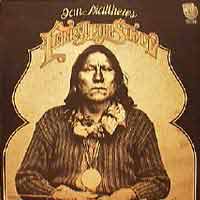 Eines
der frühen, sehr schönen Soloalben von Matthews nach seiner
Zeit bei Fairport Convention und Matthews Southern Comfort.
In der Begleitband spielte u. a. Andy Roberts,
mit dem er kurz danach Plainsong gründete.
Es wurden für Matthews Verhältnisse relativ viele Eigenkompositionen
aufgenommen, von denen aber keine bekannt geworden ist. Unter den Fremdkompositionen
sind der alte Ronettes-Hit "Da Doo Run Run" und Songs von Eric
Anderson und Richard Farina zu vermelden. Eines
der frühen, sehr schönen Soloalben von Matthews nach seiner
Zeit bei Fairport Convention und Matthews Southern Comfort.
In der Begleitband spielte u. a. Andy Roberts,
mit dem er kurz danach Plainsong gründete.
Es wurden für Matthews Verhältnisse relativ viele Eigenkompositionen
aufgenommen, von denen aber keine bekannt geworden ist. Unter den Fremdkompositionen
sind der alte Ronettes-Hit "Da Doo Run Run" und Songs von Eric
Anderson und Richard Farina zu vermelden. |
| "Neu!" (Metronome/Brain,
Feb. 1972) |

Der Schlagzeuger Klaus Dinger und der Gitarrist Michael Rother
kreierten mit dem Tonmeister Conny Plank diese merkwürdige
Instrumentalmusik, die vor allem in England Kultstatus hat. (Leider)
Eine der wenigen deutschen Platten in dieser Liste!
"Das erste Neu!-Album entstand in sage und schreibe
4 Nächten. Warum Nächte? Nun, aus dem einfachen Grund, weil
die Miete für ein Studio nachts erheblich billiger und Geld auch
schon damals ein Problem für Musiker mit Visionen und ohne Konventionen
war. Unter der Regie von Conny Plank, den die beiden aus Kraftwerk-Tagen
als Produzenten kannten, entstand 1972 das selbstbetitelte Debut. Wie
der Band- beziehungsweise der Plattentitel verkündete, war hier
etwas ganz Neues am Start. Aber nicht in dem Sinne, dass komplizierteste
Techniken und verzwickte Arrangements vorgetragen, sondern dass die
Musik auf den Kern reduziert wurde. Kleine, unscheinbare Melodien, lockere
Rhythmen, die damals zur Verfügung stehenden technischen Mittel
und eine große Portion Improvisation erschufen Musik, die im Neu!-Kosmos
wie die Elfe im Märchenland schwebt"
|
| Neil Young: "Harvest"
(Reprise, Feb. 1972) |
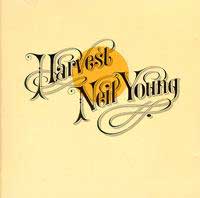 Neils
bekannteste und erfolgreichste Platte mit seinem Hit "Heart Of Gold"
und (trotzdem) eine tolle Platte! Neils
bekannteste und erfolgreichste Platte mit seinem Hit "Heart Of Gold"
und (trotzdem) eine tolle Platte! |
| Nick Drake: "Pink Moon" (Island, Feb. 1972) |
|
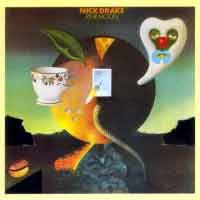 Die dritte, letzte und depressivste Platte von Nick Drake. Ganz alleine
mit Gitarre und Stimme (und einer kleinen Klaviermelodie im Titelsong)
ist diese Platte gleichzeitig beängstigend und betörend. Wie
es der Titelsong dann vor einigen Jahren in die VW-Reklame schaffen
konnte, ist mir allerdinx ein Rätsel. Hier noch ein Tipp: kauft
euch die Box "Fruit Tree", auf der das nur 29-minütige
"Pink Moon" um 4 Songs erweitert wurde, die Drake 1974 kurz
vor seinem Tod aufnahm. Diese Songs sind der absolute Oberhammer ("Black
Eyed Dog" und "Voice From The Mountain")
Die dritte, letzte und depressivste Platte von Nick Drake. Ganz alleine
mit Gitarre und Stimme (und einer kleinen Klaviermelodie im Titelsong)
ist diese Platte gleichzeitig beängstigend und betörend. Wie
es der Titelsong dann vor einigen Jahren in die VW-Reklame schaffen
konnte, ist mir allerdinx ein Rätsel. Hier noch ein Tipp: kauft
euch die Box "Fruit Tree", auf der das nur 29-minütige
"Pink Moon" um 4 Songs erweitert wurde, die Drake 1974 kurz
vor seinem Tod aufnahm. Diese Songs sind der absolute Oberhammer ("Black
Eyed Dog" und "Voice From The Mountain")
(ca. 2000)
Oder kauft Euch "Time Of No Reply",
die Raritätensammlung auf Hanibal von 1987 oder "Made
To Love Magic" von 2004.
(10.10.2009)

 Mehr ...
Mehr ...
"Kein anderer Singer/Songwriter hat seinen Glauben an zeitlose Schönheit und gleichzeitig seine Todesahnungen in bedrückendere Lieder umzusetzen vermocht als Nick Drake. Ein kompletteres Meisterwerk hat niemand vorzuweisen. In ihrem schwindelerregend hohen Reflexionsniveau stehen diese Songs den besten eines Bob Dylan, Van Morrison oder Randy Newman in nichts nach, und mit ihrer poetischen Qualität haben sie Maßstäbe gesetzt. Hier kann man - im Fall von 'Pink moon' weit mehr noch als bei der von Simply Vinyl veröffentlichten LP - aufs Schönste nachvollziehen, warum auch manche Musiker-Kollegen diese Joe-Boyd-Produktion zu den besten Analogaufnahmen aller Zeiten zählen"
(Stereo).
After two albums of tastefully orchestrated folk-pop, albeit some of the least demonstrative and most affecting around, Drake chose a radical change for what turned out to be his final album. Not even half-an-hour long, with 11 short songs and no more -- he famously remarked at the time that he simply had no more to record -- Pink Moon more than anything else is the record that made Drake the cult figure he remains. Specifically, Pink Moon is the bleakest of them all; that the likes of Belle and Sebastian are fans of Drake may be clear enough, but it's doubtful they could ever achieve the calm, focused anguish of this album, as harrowing as it is attractive. No side musicians or outside performers help this time around -- it's simply Drake and Drake alone on vocals, acoustic guitar, and a bit of piano, recorded by regular producer Joe Boyd but otherwise untouched by anyone else. The lead-off title track was eventually used in a Volkswagen commercial nearly 30 years later, giving him another renewed burst of appreciation -- one of life's many ironies, in that such an affecting song, Drake's softly keened singing and gentle strumming, could turn up in such a strange context. The remainder of the album follows the same general path, with Drake's elegant melancholia avoiding sounding pretentious in the least thanks to his continued embrace of simple, tender vocalizing. Meanwhile, the sheer majesty of his guitar playing -- consider the opening notes of "Road" or "Parasite" -- makes for a breathless wonder to behold. If anyone needs confirmation as to why artists like Mark Eitzel, Elliot Smith, Lou Barlow, or Robert Smith hold Drake close to their hearts, it's all here, still as beautiful as the day it was released.
(by Ned Raggett, All Music Guide)
|
| Jackson Browne: "Jackson
Browne (Saturate Before Using)" (Asylum, März 1972) |
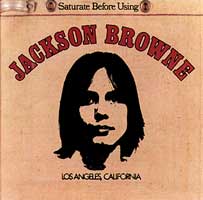 Sein Debüt, dass eigentlich unbetitelt ist, aber wegen des Schriftzugs
auf dem Wassersack vom Cover von Designer Gary Burden und Photograph
Henry Diltz nur unter dem Namen "Saturate Before Using"
bekannt, entstand mit tatkräftiger Unterstützung von David
Crosby, nachdem vorher bereits mehrere seiner Lieder von anderen Künstlern
gesungen wurden (z.B. "These Days" von Nico
und "Doctor My Eyes" von den Jackson Five!) und er 17jährig
in New York Nico's Begleitgitarrist war.
Sein Debüt, dass eigentlich unbetitelt ist, aber wegen des Schriftzugs
auf dem Wassersack vom Cover von Designer Gary Burden und Photograph
Henry Diltz nur unter dem Namen "Saturate Before Using"
bekannt, entstand mit tatkräftiger Unterstützung von David
Crosby, nachdem vorher bereits mehrere seiner Lieder von anderen Künstlern
gesungen wurden (z.B. "These Days" von Nico
und "Doctor My Eyes" von den Jackson Five!) und er 17jährig
in New York Nico's Begleitgitarrist war.

 Mehr ...
Mehr ...
|
An auspicious debut that doesn't sound like a debut: although only 23,
Jackson Browne had kicked around the music business for several years
and developed an unusual use of language, studiedly casual yet full of
striking imagery, and a post-apocalyptic viewpoint to go with it. He sang
with a calm certainty over spare, discretely placed backup that highlighted
the songs and always seemed about to disappear. In song after song, Browne
described the world as a desert in need of moisture: in "Doctor My
Eyes," the album's most propulsive song and a Top Ten hit, he sang,
"Doctor, my eyes/Cannot see the sky/Is this the prize/For having
learned how not to cry?" If Browne's outlook was cautious, its expression
was original. His conditional optimism seemed to reflect hard experience,
and in the early '70s, a lot of his listeners shared that perspective.
Like any great artist, Browne articulated the tenor of his times. But
the album has long since come to seem a timeless collection of reflective
ballads touching on still-difficult subjects -- suicide (explicitly),
depression and drug use (probably), spiritual uncertainty and desperate
hope -- all in calm, reasoned tones, and all with an amazingly eloquent
sense of language. Jackson Browne's greater triumph is that, having perfectly
expressed its times, it transcended them as well.
(by William Ruhlmann, All
Music Guide)
|
|
| Chick Corea: "Return
To Forever" (ECM, März 1972) |
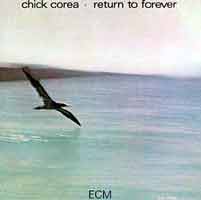 Auf dieser Platte brachte Corea die USA und Brasilien zusammen: sein eigenes
wunderbares Fender-Rhodes-Piano, Stanley Clark am Kontrabass und
Joe Farrell mit Flöte und Sopransaxofon, kombiniert mit Airto
Moreiras Schlagzeugspiel (normalerweise spielt er Perkussion) und
dem Gesang von Flora Purim. Die Songs
(z.T. mit Texten von Neville Potter) wurden Klassiker des Latin-Jazz:
"Crystal Silence", "La Fiesta", "What Game Shall
We Play Today" und "Sometime Ago".
Auf dieser Platte brachte Corea die USA und Brasilien zusammen: sein eigenes
wunderbares Fender-Rhodes-Piano, Stanley Clark am Kontrabass und
Joe Farrell mit Flöte und Sopransaxofon, kombiniert mit Airto
Moreiras Schlagzeugspiel (normalerweise spielt er Perkussion) und
dem Gesang von Flora Purim. Die Songs
(z.T. mit Texten von Neville Potter) wurden Klassiker des Latin-Jazz:
"Crystal Silence", "La Fiesta", "What Game Shall
We Play Today" und "Sometime Ago".

 Mehr ...
Mehr ...
|
The legendary first lineup of Chick Corea's fusion band Return to Forever
debuted on this classic album (titled after the group but credited to
Corea), featuring Joe Farrell on soprano sax and flute, the Brazilian
team of vocalist Flora Purim and drummer/percussionist Airto Moreira,
and electric bass whiz Stanley Clarke. It wasn't actually released in
the U.S. until 1975, which was why the group's second album, Light as
a Feather, initially made the Return to Forever name. Nonetheless, Return
to Forever is every bit as classic, using a similar blend of spacy electric-piano
fusion and Brazilian and Latin rhythms. It's all very warm, light, and
airy, like a soft breeze on a tropical beach -- hardly the sort of firebrand
approach to fusion that Miles Davis, Tony Williams, and the Mahavishnu
Orchestra were exploring, and far less rooted in funk or rock. Corea also
bathes the album in an undertone of trippy mysticism, not only in the
(admittedly dated) lyrics, but in his cosmic keyboard wanderings, which
remain melodic and accessible through most of the record. There's one
genuine pop song in the groovy samba "What Game Shall We Play Today,"
and while "Sometime Ago" has similar elements, it's part of
an ambitious side-long medley that features a stream-of-consciousness
intro and a jubilant, Spanish/Mexican-style closing section called "La
Fiesta," complete with castanets and flamenco modes. The title track
is another multi-sectioned work, featuring Corea and Purim in wordless
unison on two different, catchy themes, plus breezy work from Farrell
and lots of Brazilian-flavored rhythmic interplay. And the dreamy, meditative
"Crystal Silence" is an underrated gem waiting to be rediscovered.
Certainly, this edition of Return to Forever wasn't inclined toward high-voltage
jazz-rock (as the next one was), but this group's two albums still stand
as some of the most imaginative and distinctive early fusion recordings.
(by Steve Huey, All
Music Guide)
|
|
| Heads Hands & Feet: "Tracks"
(Island, März 1972) |
 Auch bei ihrer zweiten Platte gelang der Truppe um Tony Colton,
Albert Lee und Chas Hodges ("Chas & Dave")
mit ihrem virtuosen Countryrock leider nicht der Durchbruch beim großen
Publikum! Trotzdem eine tolle Platte.
Auch bei ihrer zweiten Platte gelang der Truppe um Tony Colton,
Albert Lee und Chas Hodges ("Chas & Dave")
mit ihrem virtuosen Countryrock leider nicht der Durchbruch beim großen
Publikum! Trotzdem eine tolle Platte.

 Mehr ...
Mehr ...
|
Although the core personnel had been together in a variety of incarnations since the mid-'60s, most notable of which was the brilliant and criminally short-lived Poet & the One Man Band, Tracks (1972) was only the second long player from Heads Hands & Feet. The U.K. quintet of Pete Gavin (drums/vocals), Albert Lee (guitar/keyboards/vocals), Ray Smith (bass/guitar/vocals), Charles "Chas" Hodges (bass/guitar/violin/vocals), and front man Tony Colton (vocals) had gained significant notice stateside during a week-long residency at the Troubadour in Los Angeles after the release of their self-titled double-LP debut Heads Hands & Feet (1971). For their second outing, Tracks, they continue their quest for exceptionally crafted country-flavored material. They waste precious little time, as the fiery "Let's Get This Show on the Road" is a high-energy, good-time ode to the rigors and foibles of live performing and concert touring as exemplified in the chorus "Maybe I'll see Margo/Down in Chicago/And I've got a dancer down in New Orleans." Lee's multi-tasking musicianship is particularly noteworthy as his rollicking keyboard work on both acoustic piano and Hammond organ, coupled with the catchy, if not slightly twangy lead electric guitar lines, rhythmically tie the verses to the chorus. "Roadshow" demonstrates quite a different side to the band, examining Lee's capacity for emotive singer/songwriter balladry. His temperate vocals and melodic piano runs recall that of Jackson Browne or early folksy Tom Waits. Further demonstrating Heads Hands & Feet's wide-ranging musicality is "Hot Property." Remarkably, the combo fuses an energetic bluegrass-inspired instrumental introduction to a funk-driven melody that would not have been too out of place coming from southern rockers Lynyrd Skynyrd. Of equal (if not arguably greater) prowess is the downhome, organic "Jack Daniels," which returns the sound to a loose groove mirroring the Band's rural rockers "Up on Cripple Creek" or "Life Is a Carnival." Tracks...Plus (1996) reissues both the original ten-song platter with a pair of additional non-LP sides, "Silver Mine" and "Warming Up the Band."
(by Lindsay Planer, All Music Guide)
|
|
| Hot Tuna: "Burgers"
(RCA/Grunt, März 1972) |
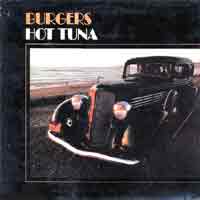 Das Album war nach einer akustischen und einer elektrischen Liveplatte
ihr erstes Studiowerk. Zu dem Zeitpunkt hatte die Band ihre eigene Identität
erarbeitet und wurde nicht mehr als „Urlaub von Jefferson Airplane“
gesehen. Ende des Jahres erschien dann noch das Airplane-Album "Long
John Silver", danach wurde Hot Tuna sogar zum Hauptbetätigungsfeld
von Jorma Kaukonen und Jack Casady. Kaukonen schrieb einige
exzellente Songs zwischen Folkblues-Picking (sehr gelungen: der "Water
Song") und Acid-Rock, Casady und Sammy Piazza waren eine gut
geölte Rhythmusgruppe und für Extra-Spannung sorgte der damals
bereits 55jährige Papa John Creach an der Violine. Bei einer
Nummer gibt es sogar gesangliche Unterstützung von David Crosby.
„Burgers“, die Platte mit dem schönen alten Auto vorne
auf dem Cover drauf, war sicher ihr bestes Studioalbum.
Das Album war nach einer akustischen und einer elektrischen Liveplatte
ihr erstes Studiowerk. Zu dem Zeitpunkt hatte die Band ihre eigene Identität
erarbeitet und wurde nicht mehr als „Urlaub von Jefferson Airplane“
gesehen. Ende des Jahres erschien dann noch das Airplane-Album "Long
John Silver", danach wurde Hot Tuna sogar zum Hauptbetätigungsfeld
von Jorma Kaukonen und Jack Casady. Kaukonen schrieb einige
exzellente Songs zwischen Folkblues-Picking (sehr gelungen: der "Water
Song") und Acid-Rock, Casady und Sammy Piazza waren eine gut
geölte Rhythmusgruppe und für Extra-Spannung sorgte der damals
bereits 55jährige Papa John Creach an der Violine. Bei einer
Nummer gibt es sogar gesangliche Unterstützung von David Crosby.
„Burgers“, die Platte mit dem schönen alten Auto vorne
auf dem Cover drauf, war sicher ihr bestes Studioalbum. |
| Jimmie Dale Gilmore &
The Flatlanders (Sun, März 1972) |
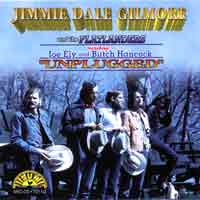 Die "Supergroup" des frühen texanischen Singer/Songwritermusik.
Neben Jimmie Dale Gilmore als "Gleicher unter Gleichen"
darf man da natürlich Joe Ely und
Butch Hancock nicht vergessen. Der Spruch
"Unplugged" auf dem Cover ist natürlich dem Zeitgeist der
CD-Wiederveröffentlichung in den 90ern geschuldet und in etwa so
sinnvoll, wie der Hinweis, dass Heavy Metal elektrisch wäre.
Die "Supergroup" des frühen texanischen Singer/Songwritermusik.
Neben Jimmie Dale Gilmore als "Gleicher unter Gleichen"
darf man da natürlich Joe Ely und
Butch Hancock nicht vergessen. Der Spruch
"Unplugged" auf dem Cover ist natürlich dem Zeitgeist der
CD-Wiederveröffentlichung in den 90ern geschuldet und in etwa so
sinnvoll, wie der Hinweis, dass Heavy Metal elektrisch wäre.

 Mehr ...
Mehr ...
"Lubbock, Texas, 14. Strasse in den frühen Siebzigern.
Drei junge Gitarristen, Songwriter und Sänger bilden eine äußerst
kreative Wohngemeinschaft, die als The Flatlanders zwar nur ein Album einspielten,
welches aber ohne Zögern zu den Klassikern der Texas Music gezählt
werden muß. Die drei Burschen waren Jimmie Dale Gilmore, Joe Ely und
Butch Hancock, die allesamt später als Solokünstler mehr oder
weniger Bedeutung und Ruhm erringen sollten.
1972 in Nashville eingespielt, gelang ihnen ein zeitloses Dokument zwischen
Country und Texas-Songwriting, welches in Würde gealtert ist und noch
heute so frisch wie damals daherkommt. Das liegt sicher zum Großteil
daran, daß sich unsere Lieblingstexaner die damaligen Produktions-Gimmicks
und Arrangements-Abartigkeiten völlig verbaten. Ihr damaliges Label
veröffentlichte eine Promo-Single und das Album kam etwas später
nur als 8-Track-Cassette (das war dieses seltsame dicke Cassettenformat
in den USA) heraus, verschwand aber schnell wieder. So blieb es lange ein
begehrtes Sammlerstück, bis Rounder sich 1990 der Sache annahm und
die Aufnahmen wiederveröffentlichte.
Geprägt wird das Album durch die hohe Stimme von Jimmie Dale Gilmore,
der praktisch alle Stücke singt, den brummeligen Harmonien von Butch
und Joe, der erstaunlichen Gitarren/Dobro-Arbeit von Joe Ely, sowie der
von Steve Wesson gespielten Säge, die immer wieder für beinahe
psychedelische Zwischentöne verantwortlich ist.
Mit Dallas und Tonight I´m Gonna Go Downtown finden sich hier bereits
zwei Gilmore-Klassiker, die später immer wieder im Lubbock-Umfeld auftauchen
sollten. Der unermüdliche und einzigartige Butch Hancock steuert vier
seiner windgegerbten Dust Blown Tractor Tunes bei (man schaue sich nur die
Bookletfotos an, Texas Plains so weit das Auge reicht) und der Rest der
dreizehn Tracks stammt aus den Federn von Al und Angela Strehli, Ed Vizard,
Louis Driver und Willie Nelson.
Die Tatsache, daß das Material für Jahre von der Bildfläche
verschwand, trug sicher zur Legendenbildung der Band bei (deshalb der Albumtitel),
aber es ist wirklich erstaunlich wie zeitlos und monumental dieses Album
auch heute noch ist. Die alte Magie entsteht auch heute noch, wenn sich
die Flatlanders zu seltenen Reunion-Gigs zusammenfinden. Da ist der charismatische
Jimmie Dale, der sympathisch-verrückte Butch und der knochentrockene
Ely und wenn Steve Wesson dann den Bogen über die Säge streicht
und der Stahl zittert, dann springt der Funke direkt über." |
|
| Ash Ra Tempel: "Schwingungen"
(Ohr, April 1972) |
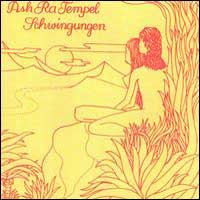 Solche "Kiffermusik" habe ich damals wenig gehört: ich
war ja auch noch ein unschuldiger Teenie. Auch Manuel Göttschings
Band lief ziemlich an mir vorbei. Aber irgendwie mag ich das jetzt doch!
Sehr entspannende Musik, die man auch ohne Drogenkonsum gut hören
kann.
Solche "Kiffermusik" habe ich damals wenig gehört: ich
war ja auch noch ein unschuldiger Teenie. Auch Manuel Göttschings
Band lief ziemlich an mir vorbei. Aber irgendwie mag ich das jetzt doch!
Sehr entspannende Musik, die man auch ohne Drogenkonsum gut hören
kann.
(28.07.2009)

 Mehr ...
Mehr ...
Die Geschichte von ASHRA / ASHRA TEMPEL begann bereits Ende der 60er. Damals brachte das Triumvirat Klaus Schulze (dr), Hartmut Enke (b) und Manuel Göttsching (keyb) den "electronic spirit" mit frei fließenden Improvisationen und instrumentalen Exkursionen in die Krautrock-Szene ein. Nach dem Weggang von Klaus Schulze wurde ASHRA das Medium von Mastermind Manuel Göttsching, der 1981 mit dem ersten technoiden Album "E2-E4" einen Trance-Klassiker schuf. Auch wenn es in diesem Jahrzehnt ruhig wurde um dieses Projekt - die Releases stammen allesamt aus den 70ern & 80ern -, so war ihre Musik der Zeit meist einen Schritt voraus. Ob New Age, electronic psychedelic Impetus oder Techno, immer verstanden es Göttsching & Co. mit substanzhaltigen Vorläufern diese Stile vorwegzunehmen. Und nun, nach fast zehn Jahren Abstinenz, ein weiteres Meisterwerk: live während der '97er-Japan-Tour eingespielt, bietet "@shra" Trance-Grooves vom Feinsten. Die sorgsam aufgebauten Sounds der drei 20-Minuten-Stücke verbinden ambiente Passagen mit träumerischen melodischen Beats, eingewebt in das Spiel der Twin-Guitars von Göttsching und Ex-AGITATION FREE Lutz Ulbrich. Intelligence Techno mit Feeling.
(Joachym Ettel, © Intro - Musik & so)
Ash Ra Tempel's second album featured the first of several personnel changes, Klaus Schulze having departed for other realms and replaced as a result by Wolfgang Muller. A few guest players surfaced here and there as well, with one John L. taking the lead vocals — another difference from the self-titled debut, which was entirely instrumental. The general principle of side-long efforts continued, though the first half was split into two related songs, "Light" and "Darkness." "Light" itself sounded halfway between the zoned-out exploration of "Traummaschine" and bluesy jamming, a weird if not totally discordant combination that still manages to sound more out there than most bands of the time. Gottsching's fried solo, in particular, is great, sending the rest of the song out to silence that leads into "Darkness." Said song initially takes a far more minimal approach that bears even more resemblance to "Traummaschine," fading out almost entirely by the third minute before a full band performance (including Uli Popp on bongos and Matthais Wehler's sudden alto sax bursts) slowly builds into a frenetic jam. John L.'s vocals become echoed screams and yelps not far off from Damo Suzuki's approach in Can, and the overall performance is a perfect slice of Krautrock insanity, sudden swirls of flanging and even more on-the-edge solos from Gottsching and Wehler sending it over the top. "Suche & Liebe" takes up the entire second side, the performers this time around concentrating on the quiet but unsettling approach, Gottsching's massive soloing kept low in the mix but not so much that it doesn't freak out listeners. The song concludes on an almost conventionally pretty band jam, something that could almost be Meddle-era Pink Floyd, only with even a more haunting, alien air thanks to the wordless vocal keening.
(by Ned Raggett, All Music Guide)
'Beware of Schwingungen!' That should be the large sticker on the front of all copies of this record. For it is dangerous to be casually introduced to something that is life-changing, as I found out to my cost when first listening to this record. It all starts fairly simply and without any cause for alarm – 'Look at Your Sun' begins with a Doorsy lone groover guitar begins a pedestrian blues, beautiful. Then the most crushed voice, a cross between Johnny Rotten and Tiny Tim, preaches its way into the proceeds. God, it is beautiful – John L. repeats over and over, 'We are all one, we are all one,' until a howling fuzztone solo guitar blows the whole one chord 'Signed D.C.' ringing-cymbals torture to an end. And then the most far out track of all begins. This is called 'Flower Must Die' and it is a free-rock giant that transcends everything else in its field (there are no contenders.) As I've written before, PIL sounds like this. John L. was John Lydon in a previous incarnation. After a slow weird build, a frantic streamlined one-chord mantra kicks in and it's like the Stooges' Funhouse period but in a Righteous Vision Zone that fucks them right off. Phasing tears at the whole tracks as this Holy Racket crosses into hyper-space and everything gets all hyphenated just-for-the-sake-of-it. 'Flowers Must Die', man, it's fucked up. Over on side two, the title-track ('Vibrations') begins poetically enough with Wolfgang Muller's epic and hugely reverbed vibraphone. Organ fades in and FX guitars, and time passes by. Finally, tom-toms roll and the developing pace is built upon until that great eternal chord sequence finally materializes – this is the one that Göttsching and Enke believed was the sound of heaven. They may have been right. And Schwingungen was a gift from the Gods."
(Julian Cope's review on Schwingungen in Krautrocksampler,Head Heritage, 1995)
|
| Big Star: "#1 Record"
(Stax/Ardent, April 1972) |
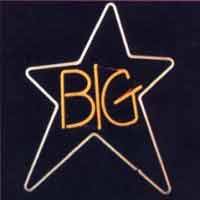 Ohne damals wirklich erfolgreich gewesen zu sein, gelten Alex Chiltons
drei Big Star-Platten, von denen hier beispielhaft die erste vorgestellt
wird, heute zu Recht als Kult. Mit dabei hier auch Chris
Bell als zweiter Sänger und Gitarrist.
Ohne damals wirklich erfolgreich gewesen zu sein, gelten Alex Chiltons
drei Big Star-Platten, von denen hier beispielhaft die erste vorgestellt
wird, heute zu Recht als Kult. Mit dabei hier auch Chris
Bell als zweiter Sänger und Gitarrist.

 Mehr ...
Mehr ...
| Sometimes it's good not knowing something about a band.
Oh, I know who Alex Chilton is, I know he used to be in a group called 'The
Box Tops' and I know about the legacy of Big Star. Power pop, but in the
case of Big Star, a particular fusion of The Beatles, The Byrds and a few
other, more hard rocking groups. Big Star of '#1 Record' vintage alternately
switch between gorgeous folk rock songs and harder rocking songs that feature
guitar solos. The latter type of song seems a lot more seventies than the
prime evocation of 1966 that the other other type of song demonstrates.
Still, Big Star arrived. Nobody noticed, due to terrible distribution -
and '#1 Record' seemingly sunk without a trace. Fast forward in time to
the UK music scene of the mid nineties, more accurately, the scottish music
scene of the mid nineties. It seemed that every new guitar band had a Big
Star influence in there somewhere. So clearly, somebody through the years
paid close attention to the sounds and songs Big Star create here. Led by
a song-writing team comprising of Alex Chilton and Chris Bell, Big Star
produce two songs in particular that really reach deep into my soul. The
first is the song the original Byrds line-up should have created or recorded
to open their early seventies 'comeback' album. 'The Ballad Of El Goodo'
is a perfect mesh of Byrds sensibilites and more strongly pronounced pop
sensibilites than even The Byrds ever demonstrated. "There aint no
one going, to turn me round..." then the harmonies kick in. The guitars
have ample chime and ring about them - and the song is so beautiful. Imagine
this as the 1973 Byrds comeback single. It would have gone to number one
everywhere in the world. As it was, Big Star themselves didn't even see
fit to release this song as single.
The other song here that gets deeply into my soul is the acoustic, folky
and absolutely gorgeously heart-wrenching romance of 'Thirteen'. A song
so good Scottish indie group Teenage Fanclub saw fit to name an entire
album after it. Elsewhere however, elsewhere. Well, we've got the charming
sixties hippy evocation that is 'The India Song' - pure nonsense, but
Big Star DO create, or re-create, the appropriate atmosphere and it still
sounds fresh. The songs 'inbetween' are more rocking, guitar solos, etc.
More strained, gritty vocals - but the opening 'Feel' and third song 'In
The Street' still manage to remind this listener of the very best Byrds
songs. But, with an added something. I mean, 'In The Street' has those
ringing guitars but it also has a groovy bass line and rock guitars. Proper
rock guitars. It's got a bit of everything, damn fine construction and
actual song-writing too. The team of Chilton and Bell clearly had something
going for themselves. 'Give Me Another Chance' is pure singer/songwriter,
a little Lennon, or at least, a little Harrison. Definitely Beatles. Another
good song on an album full of them. You won't find a single track here
even slightly below par in either writing of performance. Everything is
full of feeling. Big Star seemingly don't invent anything, all the elements
of their sound were tried and trusted elements very famous groups had
used before. But.... Big Star melded those elements. Nobody else did -
so Big Star are still hugely influential. They are still Big Star, long
after ceasing to exist. The template for the Big Star sound, the classic
Big Star sound, is here, on '#1 Record'.
(Adrian Denning)
|
|
| Mellow Candle: "Swaddling
Songs" (Decca/Deram, April 1972) |
 Lost & Found
Lost & Found
(25.05.2008) |
| Buddy Guy & Junior Wells: "Play The Blues" (Atlantic, April 1972) |
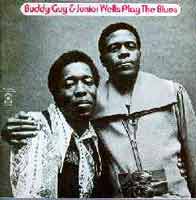
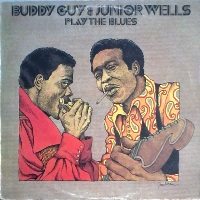 Atlantics erste Produzenten-Riege (Tom Dowd, Ahmet Ertegun,
Michael Cuscuna) versuchte, zusammen mit Eric Clapton, auch
Buddy Guy und Junior Wells an dem damaligen Bluesboom partizipieren zu
lassen. Heraus kam eine unspektakuläre, aber schöne Platte,
auf der Clapton sogar uneigennützig nur Rhythmusgitarre spielt und
auf einem Titel auch die damaligen Atlantic-Shooting Stars J.Geils
Band dabei sind.
Atlantics erste Produzenten-Riege (Tom Dowd, Ahmet Ertegun,
Michael Cuscuna) versuchte, zusammen mit Eric Clapton, auch
Buddy Guy und Junior Wells an dem damaligen Bluesboom partizipieren zu
lassen. Heraus kam eine unspektakuläre, aber schöne Platte,
auf der Clapton sogar uneigennützig nur Rhythmusgitarre spielt und
auf einem Titel auch die damaligen Atlantic-Shooting Stars J.Geils
Band dabei sind. |
| Help Yourself: "Strange
Affair" (United Artists, April 1972) |
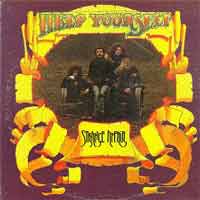 Ein etwas skurrile Truppe aus den frühen Tagen des britischen Pubrocks,
ein wenig an die Waliser Kollegen von Man erinnernd. Bei deren
Weihnachtskonzert "Christmas At The
Patti" traten sie dann mit dem zu diesem Zeitpunkt ehemaligen
Man-Sänger/Gitarristen Deke Leonard auf und begleiteten ihn
auch auf dessen Soloalbum "Iceberg".
Der Sänger und Gitarrist Malcolm Morley war dann nach dem
Ende von Help Yourself als Keyboarder auf Man's 74er Album "Rhinos,
Winos & Lunatics" dabei. Insgesamt hat es für die Band
höchstens für eine kleine Fußnote in der britischen Rockgeschichte
gereicht. Allein Schlagzeuger Dave Charles ist heutzutage noch
als Musiker (Dave Edmunds Band), Toningenieur (in den berühmten Waliser
Rockfield-Studios) und Produzent (z.B. bei Man's Comebackalbum "Endangered
Species" von 2000) im Geschäft.
Ein etwas skurrile Truppe aus den frühen Tagen des britischen Pubrocks,
ein wenig an die Waliser Kollegen von Man erinnernd. Bei deren
Weihnachtskonzert "Christmas At The
Patti" traten sie dann mit dem zu diesem Zeitpunkt ehemaligen
Man-Sänger/Gitarristen Deke Leonard auf und begleiteten ihn
auch auf dessen Soloalbum "Iceberg".
Der Sänger und Gitarrist Malcolm Morley war dann nach dem
Ende von Help Yourself als Keyboarder auf Man's 74er Album "Rhinos,
Winos & Lunatics" dabei. Insgesamt hat es für die Band
höchstens für eine kleine Fußnote in der britischen Rockgeschichte
gereicht. Allein Schlagzeuger Dave Charles ist heutzutage noch
als Musiker (Dave Edmunds Band), Toningenieur (in den berühmten Waliser
Rockfield-Studios) und Produzent (z.B. bei Man's Comebackalbum "Endangered
Species" von 2000) im Geschäft.

 Mehr ...
Mehr ...
An excellent second album from a band that, familial comparisons to Man notwithstanding, was always closer to the British pub rock ideal than many of the movement's better-feted icons ever could be. And that despite the best of Help Yourself's bluesy barroom rock predating any but the earliest birds of the beer and sawdust circuit — departing guitarist Ken Whalley's Ducks Deluxe included. Opening with the hefty chimes of the title track, Strange Affair moves on through a kaleidoscope of moves and movements, ranging from the gently and certainly Beatles-ish "Deanna, Call & Scotty," and onto a clutch of songs that would not have sounded out of place on the American West Coast — a touchstone that, again, would soon become a pub rock ideal. The album's peak, however, has to be the nine-minute "The All Electric Fur Trapper," a lush and lovely epic that conjures images of a faintly country-flavored Pink Floyd as it moves through a series of distinct phases that climax with a semi-funky, deeply fuzzy burst of JoJo Glemser guitar savagery. Accompanied by a wryly flowery essay from Ducks Deluxe frontman Sean Tyla, "The All Electric Fur Trapper" stands not only among Help Yourself's greatest achievements, but also among the highlights of the entire early-'70s British underground.
(by Dave Thompson, All Music Guide)
|
| Hölderlin: "Hölderlins
Traum" (Pilz, April 1972) |
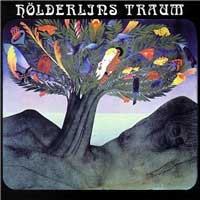 Wunderbares
Debütalbum einer der besten deutschen "Krautrockbands"
der damaligen Zeit, noch sehr folkloristisch, kaum elektrische Instrumente
(ein wenig E-Bass, Mellotron und Orgel), viel Geige, Cello, Akustikgitarre
und Flöten und der charmante Gesang von Nanny de Ruig mit
süßem holländischen Akzent. Da ich die Band erst drei
Jahre später mit ihrem zweitem titellosen Album entdeckt habe und
dieses Debüt damals nicht mehr zu bekommen war, konnte ich es erst
vor wenigen Jahren dank der CD-Wiederveröffentlichung vom Billiglabel
ZYX ergattern. Wunderbares
Debütalbum einer der besten deutschen "Krautrockbands"
der damaligen Zeit, noch sehr folkloristisch, kaum elektrische Instrumente
(ein wenig E-Bass, Mellotron und Orgel), viel Geige, Cello, Akustikgitarre
und Flöten und der charmante Gesang von Nanny de Ruig mit
süßem holländischen Akzent. Da ich die Band erst drei
Jahre später mit ihrem zweitem titellosen Album entdeckt habe und
dieses Debüt damals nicht mehr zu bekommen war, konnte ich es erst
vor wenigen Jahren dank der CD-Wiederveröffentlichung vom Billiglabel
ZYX ergattern.
(Januar 2008) |
| Matching Mole (Columbia,
April 1972) |
 Im Oktober 1971 formierte Schlagzeuger und Sänger Robert Wyatt
eine Gruppe aus Mitgliedern diverser Canterbury Bands: Keyboarder Dave
Sinclair hatte Caravan nach "In
The Land Of Grey And Pink" verlassen, Bassist Bill MacCormick
spielte mit Roxy Musics Phil Manzanera bei Quiet Sun und Gitarrist
Phil Miller spielte mit seinem tastenspielenden Bruder Steve
Miller, welcher wiederum Sinclair auf "Waterloo
Lily" bei Caravan ersetzt hatte, bei Delivery). Wyatt
benannte die Band als kleinen Scherz auf Soft Machine, wo er gerade
ausgestiegen war (lautmalerisch für die französische übersetzung
von "soft machine": "machine mole". Auf dem Cover
sind auch 2 Maulwürfe zu sehen).
Im Oktober 1971 formierte Schlagzeuger und Sänger Robert Wyatt
eine Gruppe aus Mitgliedern diverser Canterbury Bands: Keyboarder Dave
Sinclair hatte Caravan nach "In
The Land Of Grey And Pink" verlassen, Bassist Bill MacCormick
spielte mit Roxy Musics Phil Manzanera bei Quiet Sun und Gitarrist
Phil Miller spielte mit seinem tastenspielenden Bruder Steve
Miller, welcher wiederum Sinclair auf "Waterloo
Lily" bei Caravan ersetzt hatte, bei Delivery). Wyatt
benannte die Band als kleinen Scherz auf Soft Machine, wo er gerade
ausgestiegen war (lautmalerisch für die französische übersetzung
von "soft machine": "machine mole". Auf dem Cover
sind auch 2 Maulwürfe zu sehen).
Wyatts Musik zu dieser Zeit, begonnen mit seiner ersten Solo-LP "The
End of an Ear", war eine Art Free-Jazz-Rock: ausgedehnte, recht komplexe
Jams, in denen die Solisten ihr Können zeigten und der Leader seine
dadaistischen Klang- und Stimmimprovisationen einflocht. Wer also Jazz
und Freejazz schätzt, sollte mit "Matching Mole" weniger
Probleme haben (im Gegenteil!). Der erste Titel "O Caroline"
ist ein wunderschönes Liebeslied an WYATTs damalige Flamme Caroline
Coon gerichtet, auf dem er sich selbst auf dem Mellotron begleitet. Danach
kommen vor allem lange Jamsessions, die den Rest der Platte einnehmen,
immer wieder bereichert durch WYATTs bizarre Vokals und eigenwillige Keyboardeinlagen,
die schon einen Vorgeschmack auf sein späteres Schaffen geben, bei
denen er sich, wie z.B. auf "Dondestan" meist nur selbst auf
Keyboards und Perkussionsinstrumenten begleitet (seit 1973 sitzt Wyatt
nach einem Unfall hüftabwärts gelähmt im Rollstuhl und
kann das Schlagzeug im herkömmlichen Sinne (d.h. mit den Füssen)
nicht mehr spielen) |
| Mellow Candle: "Swaddling Songs" (Decca/Deram,
April 1972) |
 "Lost And Found"!
"Lost And Found"! |
| The Moody Blues: "Seventh
Sojourn" (Threshold, April 1972) |
 Dieses Album hatte ich fast vergessen! Auf jeden Fall habe ich es jahrelang
nicht mehr gehört. Es ist das siebte Album dieser klassischen Besetzung
der Moodies, die mit "Days Of Future
Passed" 1967 begonnen hatte und in der die Band zu einem der
größten damaligen Liveacts heranreifte. Es stellt aber auch das Ende dieser
Phase dar. Aus den Interviews mit den Mitgliedern, abgedruckt im Beiheft
zur Reissue-CD, geht deutlich hervor, wie schwierig die Aufnahmesessions
damals waren. Bekanntlich gab's danach ja eine lange Pause bis zur eher mäßigen
Comebackplatte "Octave" von 1978 und noch weiteren Alben bis
in die heutige Zeit, die ich mir aber gar nicht erst angehört habe.
Auf jeden Fall gehören diese 7 Platten zum Feinsten, was es an Rockmusik
der Fraktion "Schönklang/Klassik/Bombast" aus jener Zeit
gibt. Neben den beiden 1969er Werken "On
The Threshold Of A Dream" und "To
Our Children's Children's Children" gehörten "Seventh
Sojourn" auf jeden Fall zu meinen Lieblingsplatten aus jenen Tagen.
Dieses Album hatte ich fast vergessen! Auf jeden Fall habe ich es jahrelang
nicht mehr gehört. Es ist das siebte Album dieser klassischen Besetzung
der Moodies, die mit "Days Of Future
Passed" 1967 begonnen hatte und in der die Band zu einem der
größten damaligen Liveacts heranreifte. Es stellt aber auch das Ende dieser
Phase dar. Aus den Interviews mit den Mitgliedern, abgedruckt im Beiheft
zur Reissue-CD, geht deutlich hervor, wie schwierig die Aufnahmesessions
damals waren. Bekanntlich gab's danach ja eine lange Pause bis zur eher mäßigen
Comebackplatte "Octave" von 1978 und noch weiteren Alben bis
in die heutige Zeit, die ich mir aber gar nicht erst angehört habe.
Auf jeden Fall gehören diese 7 Platten zum Feinsten, was es an Rockmusik
der Fraktion "Schönklang/Klassik/Bombast" aus jener Zeit
gibt. Neben den beiden 1969er Werken "On
The Threshold Of A Dream" und "To
Our Children's Children's Children" gehörten "Seventh
Sojourn" auf jeden Fall zu meinen Lieblingsplatten aus jenen Tagen.
(28.02.2004)

 Mehr ...
Mehr ...

"Als die Moody Blues dieses Album aufnahmen, waren sie seit Jahren in unveränderter Besetzung zusammen und gehörten zu den zehn erfolgreichsten Bands der Welt. Die Gruppe besaß sogar eine eigene Boeing 707, mit der sie und einige wenige Begleiter bei ihren Tourneen um die Erde reisten. "Eines Tages musste ich im Flugzeug von ganz vorne nach ganz hinten zur Toilette. Als ich durch die Maschine ging, merkte ich auf einmal, dass da niemand anders außer mir war, und das war ein sehr leeres Gefühl. Es war der Exzess des Rock and Roll", erinnert sich John Logde 25 Jahre später im Booklet zur remasterten CD-Ausgabe von "Seventh Sojourn". Stress und Isolation des Rockstar-Lebens hatten deutliche Spuren hinterlassen.
Durchaus passend zur damaligen Stimmung in der Band zeigt das Artwork von Phil Travers eine völlig ausgestorbene Landschaft und gehört, wie so viele Plattencovers der Moody Blues, zu den beeindruckendsten der Rockgeschichte. Wer das Glück hat, noch die alten 30x30-cm-LPs zu besitzen, wird das vielleicht bestätigen können.
Keyboarder Mike Pinder, zu jener Zeit in einer schwierigen persönlichen Phase und auf der Suche nach dem Sinn des Lebens, eröffnete das siebte Album der Moody Blues mit dem meisterhaft düsteren 'Lost in a lost World' und den Worten "I woke up today, I was crying / Lost in a lost world". Es folgt eine Auseinandersetzung mit Aggression, Gleichgültigkeit und Egoismus, die in ihrer Gesamtaussage erschreckend aktuell geblieben ist: "Verloren in einer verlorenen Welt".
Justin Haywards unglaubliches 'New Horizons' kommt musikalisch nicht viel heiterer daher, zeigt aber textlich zumindest ein wenig mehr Optimismus. Seine beiden Gitarrensoli scheinen geradezu himmelwärts zu streben und sind einfach zum Heulen schön.
Man könnte Ray Thomas' 'For my Lady' als puren Kitsch bezeichnen, doch für mich ist es mit seiner nahezu volksliedhaften Einfachheit eines der innigsten Liebeslieder aller Zeiten. Es wurde häufig bei den Auftritten der Moody Blues gespielt und befindet sich auch auf dem schönen Album 'Live At Red Rocks'.
Genau wie "Isn't Life strange" von John Lodge, das trotz sechs Minuten Länge eine der erfolgreichsten Singles der Gruppe wurde. Legendär das seltsam länglich dahingesungene "Isn't life stra - ha - ha - ha - hange" und das sich wiederholende, quälend lange Warten auf den dann geradezu ekstatisch explodierenden Refrain.
Mit 'You and me' folgt der wohl straighteste Song der Platte, während 'The Land of Make-Believe' ein unerkannter Klassiker von Justin Hayward ist. Toll seine Gitarrenarbeit, geradezu magisch schön der Refrain: "So fly little bird / Up into the clear blue sky / And carry the word / Love's the only reason why ...".
Mike Pinders 'When you're a free Man" ist wiederum sehr melancholisch und entfaltet seine ganze Wirkung, wenn man es schön laut hört. Das Mellotron unterstreicht perfekt die dunkle und traurige Stimmung dieser Nummer, die von der Sehnsucht nach einem sehr guten Freund erzählt, der ins Ausland gegangen ist, um dort seinen Seelenfrieden zu finden. Auf mich wirkt der Text aber eigentlich wie ein Gespräch mit Pinders eigenem Ich.
Das Album endet mit dem Hit "I'm just a Singer (in a Rock and Roll Band)", den fast jeder Rockfan schon einmal gehört haben dürfte. Herrlicher Satzgesang von allen fünf Moodies und ein unwiderstehlicher Rhythmus, bei dem man einfach mit muss.
Nach dieser Platte und einer anschließenden, mörderisch langen Welttournee trennten sich The Moody Blues, um erst Jahre später wieder zusammenzukommen. 'Seventh Sojourn' aber ist, wie alle ihre Alben zwischen 1967 und 1972, ein progressiver Meilenstein der Rockgeschichte, und nicht ohne Grund hat ihre Musik zahllose andere Bands beeinflusst. Dafür nur ein, ganz konkretes, Beispiel: Die Gruppe Pendragon verwendet in ihrem Song 'The last Man on Earth' von 1993 gleich zwei Mal die Melodie und den Satz "But I'm never gonna lose your precious gift" aus dem oben erwähnten Moody-Blues-Titel 'New Horizons'. Zwar änderten Pendragon das Wort "gift" (Geschenk) in das Wort "heart", aber davon abgesehen bleibt es ein vollkommenes Zitat.
(Amazon-Kundenrezension)
Despite the presence of a pair of ballads -- one of them ("New Horizons") by Justin Hayward the latter's most romantic number since "Nights in White Satin" -- Seventh Sojourn was notable at the time of its release for showing the hardest-rocking sound this band had ever produced on record. It's all relative, of course, compared to their prior work, but the music is comparatively stripped down here, and on a lot of it Graeme Edge's drumming and John Lodge's bass work comprise a more forceful and assertive rhythm section than they had on earlier records, on numbers such as "Lost in a Lost World," "You and Me," and "I'm Just a Singer (In a Rock & Roll Band)." The latter, authored by Lodge, was -- along with Lodge's "Isn't Life Strange" -- one of two AM radio hits that helped drive the sales of this album, issued in early November of 1972, past all previous levels. Indeed, it was with the release of this album that the Moodies achieved their great commercial success in America and around the world, with a "Grand Tour" that kept them on the road for much of the year that followed. The irony was that it was all about to end for them, for years to come, and the signs of it were all over this record -- Seventh Sojourn took a long time to record, and a lot of the early work on it had to be junked ("Isn't Life Strange" was one of the few early songs to get completed); it was clear to all concerned except the fans that, after six years of hard work in their present configuration, they all needed to stop working with each other for a time, and this was clear in the songs -- many have a downbeat, pensive edge to them, and if they reflected a questioning attitude that had come out on recent albums, the tone of the questioning on songs like "Lost in a Lost World," "You and Me," and "When You're a Free Man" had a darker, more desperate tone. Perhaps the group's mostly youthful, collegiate audience didn't notice at the time because it fit the mood of the times -- the album hit the stores in America the day before Richard Nixon's landslide presidential re-election victory (the culmination of events behind the scenes that would subsequently drive him from office). But the members were not working well together, and this would be the last wholly successful record -- difficult as it was to deliver -- that this lineup of the band would record, as well as the last new work by the group for over five years. And oddly enough, even amid the difficulties in getting it finished, Seventh Sojourn would offer something new in the way of sounds from the group -- Michael Pinder, in particular, introduced a successor to the Mellotron, with which he'd been amazing audiences for six years, in the form of the Chamberlin, which is all over this album.
(by Bruce Eder, All Music Guide)
|
| Wishbone Ash: "Argus" (MCA, April 1972) |
 Die Band habe ich mir sicherlich mehr als 25 Jahre nicht mehr angehört.
Damals war einer meiner besten Freunde beinharter Wishbone Ash-Fan, während
Hawkwind meine Fraktion war. Trotzdem habe auch ich mir die Band damals
sehr gerne angehört. Als es dann bei uns Mitte der 70er selber mit
Musikmachen losging und alle Bands dann das zweistimmige Gitarrenspiel
von Andy Powell und Ted Turner versucht haben zu imitieren,
habe ich sehr schnell die Lust auch auf das Original verloren (das ging
mir übrigenz in den späten 70ern/frühen 80ern mit Z.Z.Top
genauso, die von all den Bluesbands in unserer Gegend zu Tode gecovert
wurden).
Die Band habe ich mir sicherlich mehr als 25 Jahre nicht mehr angehört.
Damals war einer meiner besten Freunde beinharter Wishbone Ash-Fan, während
Hawkwind meine Fraktion war. Trotzdem habe auch ich mir die Band damals
sehr gerne angehört. Als es dann bei uns Mitte der 70er selber mit
Musikmachen losging und alle Bands dann das zweistimmige Gitarrenspiel
von Andy Powell und Ted Turner versucht haben zu imitieren,
habe ich sehr schnell die Lust auch auf das Original verloren (das ging
mir übrigenz in den späten 70ern/frühen 80ern mit Z.Z.Top
genauso, die von all den Bluesbands in unserer Gegend zu Tode gecovert
wurden).
Jetzt also nach so langer Zeit sitze ich bei einem anderen guten Freund
und was läuft da: "Argus - Remastered & Revisted",
die Wiederveröffentlichung zum 30jährigen Jubiläum, und
ich muss sagen: immer noch eine klasse Platte. Ich konnte sogar alle Songs
mehr oder weniger textsicher mitsingen. Nur auf das zweistimmige Sologitarrenspiel
werde ich auch zukünftig in meiner eigenen Kapelle verzichten.
(16.12.2002) |
| Caravan: "Waterloo Lily" (Decca/Deram, Mai 1972) |
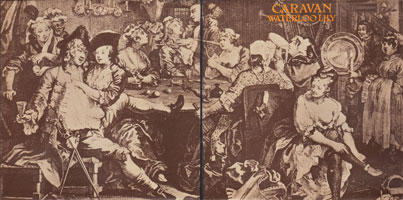 In
den frühen 70ern hatte die Band aus Canterbury eine richtig gute
Phase. Dabei entstanden ein paar schöne Alben wie dieses hier. Heutzutage
gilt so was ja als "Prog-Rock" (Yes, frühe Genesis,
etc.). In diesen Topf solltet ihr diese Band aber nicht werfen, wäre
zu schade. In
den frühen 70ern hatte die Band aus Canterbury eine richtig gute
Phase. Dabei entstanden ein paar schöne Alben wie dieses hier. Heutzutage
gilt so was ja als "Prog-Rock" (Yes, frühe Genesis,
etc.). In diesen Topf solltet ihr diese Band aber nicht werfen, wäre
zu schade. |
| Elton John: "Honky Chateau" (DJM, Mai 1971) |
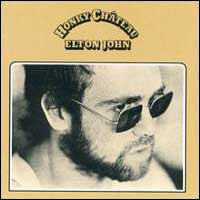

 Mehr ...
Mehr ...
Considerably lighter than Madman Across the Water, Honky Chateau is a rollicking collection of ballads, rockers, blues, country-rock, and soul songs. On paper, it reads like an eclectic mess, but it plays as the most focused and accomplished set of songs Elton John and Bernie Taupin ever wrote. The skittering boogie of "Honky Cat" and the light psychedelic pop of "Rocket Man" helped send Honky Chateau to the top of the charts, but what is truly impressive about the album is the depth of its material. From the surprisingly cynical and nasty "I Think I'm Gonna Kill Myself" to the moving ballad "Mona Lisas and Mad Hatters," John is at the top of his form, crafting immaculate pop songs with memorable melodies and powerful hooks. While Taupin's lyrics aren't much more comprehensible than before, John delivers them with skill and passion, making them feel more substantial than they are. But what makes Honky Chateau a classic is the songcraft, and the way John ties disparate strands of roots music into distinctive and idiosyncratic pop — it's one of the finest collections of mainstream singer/songwriter pop of the early '70s.
(by Stephen Thomas Erlewine, All Music Guide)
|
| Little Feat: "Sailing Shoes" (Warner, Mai 1972) |
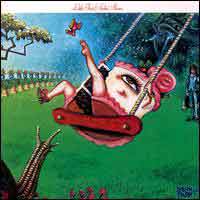 Beim
zweiten Album wurden Little Feat zum Sextett: Kenny Gradney ersetzte
Roy Estrada am Bass. Zu Lowell George (voc, Slidegit.), Bill
Payne (keyb) und Richie Hayward (dr) stießen der Gitarrist
Paul Barrere und der Congaspieler Sam Clayton. Die Songs,
meist aus der Feder von Lowell George, sprechen für sich:
"Easy To Slip", "Trouble", eine neue Version von "Willin'"
und natürlich der Titelsong. Beim
zweiten Album wurden Little Feat zum Sextett: Kenny Gradney ersetzte
Roy Estrada am Bass. Zu Lowell George (voc, Slidegit.), Bill
Payne (keyb) und Richie Hayward (dr) stießen der Gitarrist
Paul Barrere und der Congaspieler Sam Clayton. Die Songs,
meist aus der Feder von Lowell George, sprechen für sich:
"Easy To Slip", "Trouble", eine neue Version von "Willin'"
und natürlich der Titelsong. |
| John Mayall: "Jazz Blues Fusion" (Polydor, Mai 1972) |
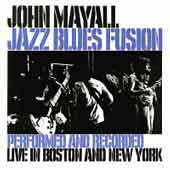 Sicherlich
nicht Mayalls bekannteste Platte, aber die erste, die mir damals aufgefallen
war. Mayall hatte eine hochkarätige Truppe von virtuosen Jazzern
um sich versammelt, die seine teils recht schlichten Bluesvorlagen auf
ein anderes Level gehoben haben. Es spielten: Larry Taylor (Bass,
vorher & nachher bei Canned Heat), Freddy Robinson (g), Clifford
Solomon (sax), Blue Mitchell (tp) und Ron Selico (dr). Sicherlich
nicht Mayalls bekannteste Platte, aber die erste, die mir damals aufgefallen
war. Mayall hatte eine hochkarätige Truppe von virtuosen Jazzern
um sich versammelt, die seine teils recht schlichten Bluesvorlagen auf
ein anderes Level gehoben haben. Es spielten: Larry Taylor (Bass,
vorher & nachher bei Canned Heat), Freddy Robinson (g), Clifford
Solomon (sax), Blue Mitchell (tp) und Ron Selico (dr). |
| Stephen Stills: "Manassas" (Atlantic, Mai 1972) |
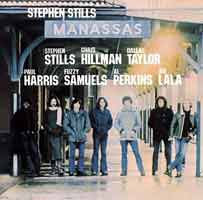 Nach dem Split von CSN&Y im Anschluss
an ihre 71er-Tournee scharte Stills diese hochkarätige Truppe um sich,
die 72/73 für Furore sorgte und dieses sehr gute Doppelalbum und
im Folgejahr noch einen ordentlichen Nachfolger hinlegte. Die Musik bewegt
sich zwischen bluesigem Rock, Country (Pedal Steel, Mandoline) und viel
Latin (Percussion). Leider hatte Stills danach außerhalb der CS&N-
bzw. CSN&Y-Reunions nichts Aufsehen erregendes mehr auf die Beine
gestellt. Zu Manassas gehörten: Chris Hillman (Ex-Byrd,
Ex-Flying Burrito Brother, der
hier als Rhythmusgitarrist und Zweitsänger leider ein bisschen untergeht),
Paul Harris (keyb), Joe Lala (perc), Al Perkins (genialer
Steeler, in den 90ern bei Emmylou Harris's
Nash Ramblers), Dallas Taylor (dr) und Calvin Samuels
(bg). Als Gäste sind u.a. der legendäre Geiger Byron Berline
und Bill Wyman zu hören.
Nach dem Split von CSN&Y im Anschluss
an ihre 71er-Tournee scharte Stills diese hochkarätige Truppe um sich,
die 72/73 für Furore sorgte und dieses sehr gute Doppelalbum und
im Folgejahr noch einen ordentlichen Nachfolger hinlegte. Die Musik bewegt
sich zwischen bluesigem Rock, Country (Pedal Steel, Mandoline) und viel
Latin (Percussion). Leider hatte Stills danach außerhalb der CS&N-
bzw. CSN&Y-Reunions nichts Aufsehen erregendes mehr auf die Beine
gestellt. Zu Manassas gehörten: Chris Hillman (Ex-Byrd,
Ex-Flying Burrito Brother, der
hier als Rhythmusgitarrist und Zweitsänger leider ein bisschen untergeht),
Paul Harris (keyb), Joe Lala (perc), Al Perkins (genialer
Steeler, in den 90ern bei Emmylou Harris's
Nash Ramblers), Dallas Taylor (dr) und Calvin Samuels
(bg). Als Gäste sind u.a. der legendäre Geiger Byron Berline
und Bill Wyman zu hören.

 Mehr ...
Mehr ...
| Nachdem Stephen Stills mit Buffalo Springfield Mitte der
60er Erfolg hatte, eroberte er mit Crosby, Stills, Nash & Young am Ende
der Dekade die US-Charts: "Deja Vu" landete '70 auf Platz 1. Nach
dem Bruch des Folkrock-Quartetts startete der gebürtige Texaner '72
neu unter dem Band-Logo Manassas, mit 21 Songs und breiter Stil-Palette:
Rockige Töne ("Song Of Love") fehlen sowenig wie Country-durchtränkte
Songs ("Jesus Gave Love Away For Free") und warmherzige Harmoniegesänge
("So Begins The Task") - fein HDCD-remastert. ** Musik: 03-04
** Klang: 02-03
© Audio
|
|
|
Ziemlich genau sieben Jahre nach der CD-Erstveröffentlichung hat
die derzeit hoch wogende Remastering-Welle die Soloplatten von Stephen
Stills erreicht. Zwei Silberlinge werden zunächst angeboten, und
es sind, vom musikalischen Gehalt her gesehen, seine besten: das Solodebüt
von 1970 (mit dem Hit "Love The One You're With") sowie das
anderthalb Jahre später veröffentlichte erste Album mit der
Band Manassas. Äußerlich erkennbar sind beide Plättchen
an einem HDCD-Aufkleber. Joe Gastwirt besorgte - wie schon im Fall der
Crosby, Stills & Nash-CDs (stereoplay 9/1995) - die Remastering, und
zwar ausdrücklich "from the original master tapes". Die
frühere Stills-Solo-CD (Atlantic 7567-81414-2) war so übel nicht,
sie entsprach im westentlichen dem originalen US-Vinyl-Umschnitt. Die
klanglichen Veränderungen der Neuauflage sind zum Teil subtiler Natur,
bei einigen Songs allerdings deutlich hörbar. So profitieren insbesondere
"Do For The Others" und "To A Flame" von einem volleren
und wärmeren Grundtonbereich, während "Church (Part Of
Someone)" in der Transparenz erheblich verbessert wurde. Den Siebener-Verband
Manassas rief Stills zusammen mit dem Ex-Byrd Chris Hillman ins Leben.
Die gruppeneigene Melange aus deftigem Rock ("Rock & Roll Crazies"),
Bluegrass- ("Fallen Eagle") und Country-Verwandtem ("Jesus
Grave Love Away For Free") sowie einer Prise Latin-Rock ("Cuban
Bluegrass") war einmalig im Westcoast-Genre. Von der Doppel-LP gab
es eine erste CD (Atlantic 7567-81322-2) mit unverhältnismäßig
stark angehobenem Baßbereich und fehlender Dynamik: ein Desaster.
Die Neuüberspielung hebt jetzt diese bravouröse Platte in die
klangliche Kategorie, die ihr gebührt. Vorzüglich ist die Durchbhörbarkeit,
sehr ausgewogen die Frequenzbalance, und die Bässe reichen noch tiefer
hinab als beim Vinyl.
© Stereoplay
|
|
|
A sprawling masterpiece, akin to the Beatles' White Album, the Stones'
Exile on Main St., or Wilco's Being There in its makeup, if not its sound.
Rock, folk, blues, country, Latin, and bluegrass have all been styles
touched on in Stephen Stills' career, and the skilled, energetic musicians
he had gathered in Manassas played them all on this album. What could
have been a disorganized mess in other hands, though, here all gelled
together and formed a cohesive musical statement. The songs are thematically
grouped: part one (side one on the original vinyl release) is titled "The
Raven," and is a composite of rock and Latin sounds that the group
would often perform in full live. "The Wilderness" mainly centers
on country and bluegrass (Chris Hillman's and Al Perkins' talents coming
to the forefront), with the track "So Begins the Task" later
covered by Stills' old flame Judy Collins. Part three, "Consider"
is largely folk and folk-rock. "Johnny's Garden," reportedly
for the caretaker at Stills' English manor house and not for John Lennon
as is often thought, is a particular highlight. Two other notables from
the "Consider" section are "It Doesn't Matter" (later
redone with different lyrics by the song's uncredited co-writer Rick Roberts
on the first Firefall album) and "Move Around," which features
some of the first synthesizer used in a rock context. The closing section,
titled "Rock & Roll Is Here to Stay," is a rock and blues
set with one of the landmarks of Manassas' short life, the epic "The
Treasure." A sort of Zen-like meditation on love and "oneness,"
enlivened by the band's most inspired recorded playing it evolves into
a bluesy groove washed in Stills' fierce electric slide playing. The delineation
lines of the four themed song groupings aren't cut in stone, though, and
one of the strengths of the album is that there is a lot of overlap in
styles throughout. The CD reissue's remastered sound is excellent, though
missed is the foldout poster and handwritten lyrics from the original
vinyl release. Unfortunately, the album has been somewhat overlooked over
the years, even though Stills considers it some of the best work he has
done. Bill Wyman (who guested on "The Love Gangster") has said
he would have quit the Rolling Stones to join Manassas.
(by Rob Caldwell, All
Music Guide)
|
|
| Bob Weir: "Ace" (Warner, Mai 1972) |
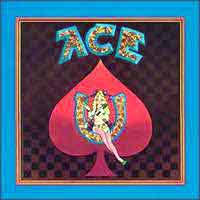 Bob
Weirs Solodebut ist ein verkapptes Grateful Dead - Album, denn er wird
hier durchgängig von seiner Stammband begleitet (Jerry Garcia,
Phil Lesh, Bill Kreutzmann und der Neuzugang Keith Godchaux).
Zum ersten Mal tritt auch Donna Godchaux in Erscheinung, die danach
ebenfalls festes Bandmitglied wurde. Die meisten der Songs fanden danach
auch den Weg in das Dead-Repertoire: "Greatest Story Ever Told",
"Playing In The Band", "Looks Like Rain", "Cassidy"
und "One More Saturday Night". Eines der besten Dead-Alben,
nur eben ohne Garcia-Songs und Garcia-Gesang. Bob
Weirs Solodebut ist ein verkapptes Grateful Dead - Album, denn er wird
hier durchgängig von seiner Stammband begleitet (Jerry Garcia,
Phil Lesh, Bill Kreutzmann und der Neuzugang Keith Godchaux).
Zum ersten Mal tritt auch Donna Godchaux in Erscheinung, die danach
ebenfalls festes Bandmitglied wurde. Die meisten der Songs fanden danach
auch den Weg in das Dead-Repertoire: "Greatest Story Ever Told",
"Playing In The Band", "Looks Like Rain", "Cassidy"
und "One More Saturday Night". Eines der besten Dead-Alben,
nur eben ohne Garcia-Songs und Garcia-Gesang.

 Mehr ...
Mehr ...
I've always thought of this album as the record that launched a thousand
tatoos. With a band made up of a large portion of the Grateful Dead, Weir
make this his own album. The tunes from these sessions became standards
during live performances. Either live or in the studio tunes like "Looks
Like Rain" will always make me stop what I'm doing and listen for
a bit. And the cover colors are bright, but still produce a nice quiet
effect.
(Tralfaz-Archive)
As a "bonus" for re-signing another three-album deal with Warner
Brothers Records in the early '70s, members of the Grateful Dead were
given the opportunity to cut solo albums. Jerry Garcia (Garcia), Mickey
Hart (Rolling Thunder), and Bob Weir (Ace) took advantage of the offer
-- although it could easily be argued that Weir's disc was in reality
the next Grateful Dead album simply featuring the rhythm guitarist's co-compositions
and lead vocals throughout. In essence, Ace became the follow-up to the
double-live LP Grateful Dead [1971] (aka "Skull and Roses"),
which included a live and somewhat non-descript rendition of "Playing
in the Band." Ironically, on this studio release the Grateful Dead
stretch out during the seven-plus-minute version -- which is considered
to be one of their most inspired improvisational interactions away from
the concert stage. Likewise, practically every track -- with the exception
of the painfully optimistic "Walk in the Sunshine" -- became
an integral component of the Grateful Dead's performance repertoire for
their remaining 20-plus years as an actively touring band. Much of Ace
is flavored with the same country-rock textures that informed the Dead's
previous two studio recordings, American Beauty and Workingman's Dead.
The addition of keyboardist Keith Godchaux -- whose style on this album
rivals that of Jerry Lee Lewis -- gives songs such as "Greatest Story
Ever Told" and "One More Saturday Night" an aggressive
bite which is conspicuous in its absence from the Grateful Dead's previous
studio outings. On the whole, Ace is thoroughly enjoyable for devout Deadheads
as well as less-fanatical enthusiasts. Other standout tracks include the
lilting lullaby "Cassidy," Snooky Flowers' driving horn arrangement
on "One More Saturday Night," and Garcia's lazy, laid-back pedal
steel guitar work on "Looks Like Rain."
(by Lindsay Planer, All Music Guide)
|
| Randy Newman: "Sail Away" (Reprise, Juni 1972) |
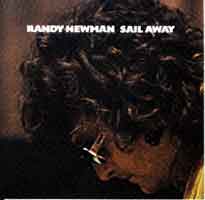 Einer
der besten Texter der Rockmusik - und auch als Sänger und Pianist
kein schlechter! Auf dieser Platte sind einige seiner besten Songs versammelt:
"Sail Away", "Lonely At The Top", "God's Song"
und "You Can Leave Your Hat On" (ja, genau: das Bierreklamelied
von Joe Cocker! übrigens ziehe ich die Coverversion von Jess
Roden von 1976 vor!) Einer
der besten Texter der Rockmusik - und auch als Sänger und Pianist
kein schlechter! Auf dieser Platte sind einige seiner besten Songs versammelt:
"Sail Away", "Lonely At The Top", "God's Song"
und "You Can Leave Your Hat On" (ja, genau: das Bierreklamelied
von Joe Cocker! übrigens ziehe ich die Coverversion von Jess
Roden von 1976 vor!) |
| "Roxy Music" (Island, Juni 1972) |
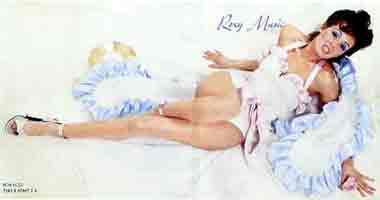 Das Debüt der Band um Sänger/Pianist Bryan Ferry und
Synthesizerspieler Brian Eno. Die Band war vor allem optisch auffällig
("Glamrock"), hatte aber zumindest damals ordentlich Feuer unter
dem Hintern und spielte auch eine betörende Musik, in der vor allem
Gitarrist Phil Manzanera und Saxofonist Andy Mackay glänzten.
Einziger Schwachpunkt des Albums: die geniale Single "Virginia Plain"
fehlt.
Das Debüt der Band um Sänger/Pianist Bryan Ferry und
Synthesizerspieler Brian Eno. Die Band war vor allem optisch auffällig
("Glamrock"), hatte aber zumindest damals ordentlich Feuer unter
dem Hintern und spielte auch eine betörende Musik, in der vor allem
Gitarrist Phil Manzanera und Saxofonist Andy Mackay glänzten.
Einziger Schwachpunkt des Albums: die geniale Single "Virginia Plain"
fehlt.

 Mehr ...
Mehr ...
Many people only know Roxy Music's later, mellower work, but their early stuff is totally original and really rocks. This is their debut album and has a great mixture of tracks that set Bryan Ferry's wide-ranging vocals to an extraordinary mix of sounds.It's almost worth buying this CD for the inlay card alone. Animal prints were clearly compulsory in 1972, Ferry's hair is unbelievable, and Eno looks exactly like Hugo Weaving in Lord of the Rings (Ok his ears aren't quite as pointy but honestly it's uncanny).
|
| Bridget St. John: "Thank You For ..." (Dandelion, Juni 1972) |
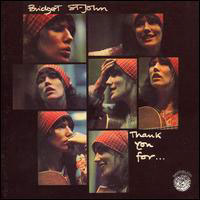 Lost & Found!
Lost & Found!
(19.12.2008)

 Mehr ...
Mehr ...
Bridget St. John has a small legion of fans willing to do battle for their hero, but to most she sounds like a pleasant, secondary British folk-rock artist of the early 1970s. Those impressions won't be changed by this, her third album, mixing low-key originals with covers of songs by Bob Dylan and Buddy Holly, as well as one of her most popular tracks, an interpretation of the traditional folk tune "Lazarus." Simply put, St. John doesn't come within bow-and-arrow range of Sandy Denny or Maddy Prior. She favors a low, slightly husky delivery that sometimes brings to mind what Marianne Faithfull might have sounded like in the late '70s had Faithfull's voice lowered naturally, instead of being ravaged. Reserve can be effective, but it sounds like St. John would need to be roasted over an open flame before her temperature rose.
(by Richie Unterberger, All Music Guide)
|
| "Fillmore: The Last Days" (Warner, Juni 1972) |
|
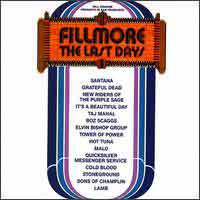 Im
Juli 1971 schloss Bill Grahams berühmte Konzerthalle in San Francisco.
In der letzten Woche gaben sich die Rockstars der Bay Area dort die
Klinke in die Hand und alles wurde auf einem Dreifachalbum festgehalten. Im
Juli 1971 schloss Bill Grahams berühmte Konzerthalle in San Francisco.
In der letzten Woche gaben sich die Rockstars der Bay Area dort die
Klinke in die Hand und alles wurde auf einem Dreifachalbum festgehalten.
"In the summer of 1971, Bill Graham closed the two
halls that had redefined the way live rock music was heard. In San Francisco,
the Fillmore Auditorium, and later the Fillmore West, had been home
to virtually every major performing band of the era, a neighborhood
meeting place and dance palace rolled into one. It was the place to
see the Dead, the Airplane, Santana, and any visiting musical act with
any hipness quotient at all. This 2-CD package features some of the
recordings from the final week of shows at the fabled Fillmore West.
Not all of the bands are remembered today (Lamb, anyone?) but with hot
entries from Quicksilver Messenger Service, Tower of Power, Hot Tuna,
Boz Scaggs, the Dead, Santana, etc., it's a tribute both to a time and
place and to the inestimable contributions of the late Graham. The sound
quality is lacking by today's standards, but the free 'n' easy Fillmore
atmosphere comes through." (Jeff Tamarkin, All Music Guide)
|
| Guru Guru: "Känguru" (Brain, Juli 1972) |
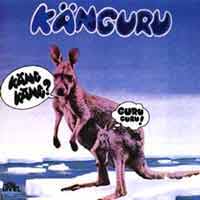 Der
immer noch ausgezeichnete Nachfolger zu meinem Lieblingsalbum der Band
("Hinten" vom letzten Jahr).
Das Trio der ehemaligen Jazzer Mani Neumeier (dr), Uli Trepte
(bg) und Ax Genrich (g) schaffte es in unnachahmlicher Weise Jimi
Hendrix, Freejazz und Humor miteinander zu verbinden. Guru Guru sind
eine der wenigen Bands aus der damaligen Deutschrockzeit, die ich mir
auch heute noch gut anhören kann (die anderen sind z.B. Can
und Amon Düül II, aber die habe ich eigentlich erst später
für mich entdeckt!). Nur 4 Lieder in 40 Minuten. Mein Anspieltipp
ist das russisch(?) gesungene(?) "Immer Lustig". Ist sehr lustig. Der
immer noch ausgezeichnete Nachfolger zu meinem Lieblingsalbum der Band
("Hinten" vom letzten Jahr).
Das Trio der ehemaligen Jazzer Mani Neumeier (dr), Uli Trepte
(bg) und Ax Genrich (g) schaffte es in unnachahmlicher Weise Jimi
Hendrix, Freejazz und Humor miteinander zu verbinden. Guru Guru sind
eine der wenigen Bands aus der damaligen Deutschrockzeit, die ich mir
auch heute noch gut anhören kann (die anderen sind z.B. Can
und Amon Düül II, aber die habe ich eigentlich erst später
für mich entdeckt!). Nur 4 Lieder in 40 Minuten. Mein Anspieltipp
ist das russisch(?) gesungene(?) "Immer Lustig". Ist sehr lustig. |
| The Charles Ford Band (Arhoolie, Aug. 1972) |
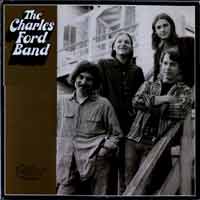 Blues
vom Allerfeinsten! Die Charles Ford Band war nach dem Vater der drei Brüder
Patrick Ford (Schlagzeug, damals 22 Jahre jung), Robben Ford
(Gesang, Gitarre, 21 Jahre jung) und Mark Ford (Harp, 18 Jahre
jung) benannt. Dazu kam am Bass Stan Poplin (19 Jahre jung). Robben
und Patrick spielten nebenher in der Band von Charlie
Musselwhite und lernten dort als kalifornische Teenager den Blues
zu spielen. Leider hielt die Band nicht sehr lange - und nur Robben Ford
machte danach Karriere als einer der besten Jazz- und Bluesgitarristen
überhaupt (u.a. bei Joni Mitchell und Miles Davis). Blues
vom Allerfeinsten! Die Charles Ford Band war nach dem Vater der drei Brüder
Patrick Ford (Schlagzeug, damals 22 Jahre jung), Robben Ford
(Gesang, Gitarre, 21 Jahre jung) und Mark Ford (Harp, 18 Jahre
jung) benannt. Dazu kam am Bass Stan Poplin (19 Jahre jung). Robben
und Patrick spielten nebenher in der Band von Charlie
Musselwhite und lernten dort als kalifornische Teenager den Blues
zu spielen. Leider hielt die Band nicht sehr lange - und nur Robben Ford
machte danach Karriere als einer der besten Jazz- und Bluesgitarristen
überhaupt (u.a. bei Joni Mitchell und Miles Davis). |
| Van Morrison: "Saint Dominic's Preview" (Warner, Aug. 1972) |
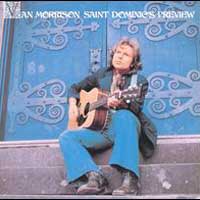 Dieses Klasse-Album hatte ich doch bisher glatt vergessen! Liegt vielleicht
daran, dass ich mir meine uralte Vinyl-Ausgabe mit einem hässlichen
"Nice-Price-Cover" schon lange nicht mehr angehört hatte.
Heute überkam es mich dann im Plattenladen und ich habe mir ein CD-reissue
"geschossen" (O.K. - war ziemlich billig!) und kann nur sagen:
starkes Teil, vielleicht nicht ganz so genial wie das Vorgängeralbum
"Tupelo Honey" (natürlich
mit dem Titelsong "Tupelo
Honey": Album und Song gehören schließlich zu meinen
All-Time-Fave's!), aber trotzdem ganz wunderbar. Den Opener "Jackie
Wilson Said" kennt der eine oder andere in der Coverversion von Dexy's
Midnight Runners. Besonders schön sind aber die beiden Lieder
mit jeweils mehr als 10 Minuten Laufzeit: "Listen To The Lion"
und "Almost Independence Day" lassen noch einmal den Glanz von
Van's anderem Meisterwerk "Astral
Weeks" aufleuchten. "Van The Man" at his best! An solch
lange Geschichten wagt er sich dann erst wieder fast 10 Jahre später
mit "Summertime In England" auf "Common
One".
Dieses Klasse-Album hatte ich doch bisher glatt vergessen! Liegt vielleicht
daran, dass ich mir meine uralte Vinyl-Ausgabe mit einem hässlichen
"Nice-Price-Cover" schon lange nicht mehr angehört hatte.
Heute überkam es mich dann im Plattenladen und ich habe mir ein CD-reissue
"geschossen" (O.K. - war ziemlich billig!) und kann nur sagen:
starkes Teil, vielleicht nicht ganz so genial wie das Vorgängeralbum
"Tupelo Honey" (natürlich
mit dem Titelsong "Tupelo
Honey": Album und Song gehören schließlich zu meinen
All-Time-Fave's!), aber trotzdem ganz wunderbar. Den Opener "Jackie
Wilson Said" kennt der eine oder andere in der Coverversion von Dexy's
Midnight Runners. Besonders schön sind aber die beiden Lieder
mit jeweils mehr als 10 Minuten Laufzeit: "Listen To The Lion"
und "Almost Independence Day" lassen noch einmal den Glanz von
Van's anderem Meisterwerk "Astral
Weeks" aufleuchten. "Van The Man" at his best! An solch
lange Geschichten wagt er sich dann erst wieder fast 10 Jahre später
mit "Summertime In England" auf "Common
One".

 Mehr ...
Mehr ...
|
"The best-produced, most ambitious Van Morrison record
yet released, Saint Dominic's Preview presents an impressive assemblage
of musical ideas that can be enjoyed on many levels. Though the album
does not have quite the surface accessibility of Tupelo
Honey, being melodically less predictable and lyrically more esoteric,
its overall content is musically much richer and more adventurous.
Five of the album's seven cuts pick up where Tupelo
Honey left off, as Van and many of the same crew who put together
Tupelo further refine and extend the possibilities of the mainstream road-house
band sound that has characterized Van's last three albums. In contrast,
the two longest cuts, "Listen to the Lion" and "Almost
Independence Day," run 10 and 11 minutes respectively, and mark a
welcome return to the meditative vitality of Astral Weeks. The coexistence
of two styles on the same record turns out to be very refreshing; they
complement each other by underscoring the remarkable versatility of Van's
musical imagination.
As in Tupelo Honey,
the mood here is one of celebration and expectation, but this time not
in terms of a relationship within a particular setting. Above all, Saint
Dominic's Preview invokes the possibility of profound self-revelation
through being on the road and making music. Often there is a feeling of
thrilling mystical presentiment. All this is expressed in such a dazzling
variety of ways that at first listening Saint Dominic seems to be a less
unified work than Tupelo or Astral
Weeks. The point, however, is that Van is deliberately proclaiming
his freedom from musical style or place (either the specific southern
locale of Tupelo or the mythic arena of Astral
Weeks.) Images of travel abound, adding up to a summons to high adventure-actual,
imaginative, and musical.
The album opens with "Jackie Wilson Said (I'm in Heaven When You
Smile)," a neat three-minute salute to soul then moves into "Gypsy,"
in which Van states where he's at artistically; the rhythms, alternating
between double and triple time, are driving and excited, the harmonies
faintly Middle Eastern, and the multiple guitar textures exotic. The song
demonstrates that Van is precisely a musical gypsy-cryptic, sensual, and
shrewd-a master at casting spells and at leading us through whatever territory
he feels like exploring. While both cuts show off the band in its funky
style, the third cut, "I Will Be There," goes the furthest of
any into R&B-jazz roots, as Van pays expert musical tribute to Count
Basie and Joe Williams.
The excellence of these cuts isn't based on any major innovation, but
on the homogenization of diverse but familiar ideas under the auspices
of a single strong personality. But just as impressive as Van's personal
stamp is the band's marvelous ensemble virtuosity. At the forefront of
this evolving "roadhouse" sound are two saxophones (alternately
played by Jack Schroer, Boots Houston, and Jules Broussard). The greater
prominence of saxophone, plus the development of a more integrated and
generally denser "band" sound in which Van's singing is somewhat
laid back, mark the chief departures on these cuts from the sound of Tupelo.
Saint Dominic's Preview gets better as it goes along. The extended meditation,
"Listen to the Lion," which closes side one, is magnificent.
Here, as on much of Astral
Weeks, the momentum is carried forward by incantatory rhythmic strumming
(Van and Ronnie Montrose). But whereas the music on Astral Weeks was augmented
by strings, "Listen to the Lion" uses subdued backup vocals
(Montrose, Houston, and Van) to achieve the same hypnotic effect. The
result is a purer but no less captivating sound than on Astral Weeks.
Musically and lyrically, the cut builds slowly to an intense climax through
the use of repeated short musical and lyrical phrases that gradually metamorphose
without totally changing shape, and then subside, gradually surrendering
tension like the release of a deep breath. Van begins: "Listen to
the lion inside me." As the idea is developed it becomes, "and
all my tears like water flow for the lion inside me," and ends, "and
we sailed looking for a brand new start." As the song reaches peak
intensity Van's singing becomes more and more gutteral until it is almost
a feral muttering.
The six-and-a-half-minute title cut which opens side two nicely straddles
the gap between the album's two styles. Instrumentally it is very similar
to "Tupelo Honey."
The arrangement and vocals are joyously full-bodied and enhanced by John
McFee's steel guitar. However, the dense verbiage (more complex than on
any other cut) is disjunctive and arcane, juxtaposing images of mythic
travel, with those of social alienation, with reference to James Joyce
and Northern Ireland. Within this deliberately obscure but provocative
narrative recurs the refrain of Van's apocalyptic vision which he calls
Saint Dominic's Preview. I was uneasy about Van's insistence on employing
a basically private mythology in Astral Weeks, evocative as it was, and
I am uneasy about "Saint Dominic's Preview" for the same reason.
The words are difficult to follow, and the album provides no lyric sheet.
Nevertheless Van achieves his effect-contrasting a restless, ominous perspective
of the present with his certainty of a positive, perhaps ultimate resolution
just ahead. The affirmation of "Saint Dominic's Preview" is
translated to the past in "Redwood Tree," an ecstatic boyhood
reminiscence centering on the image of a sheltering redwood tree. This
beautiful, sensuous cut has the album's greatest potential as a hit single.
"Almost Independence Day," the ten-minute concluding cut, is
a moving summation of what has preceded. Structurally akin to "Listen
to the Lion," it duets Van and Ron Elliott on 12-string and 6-string
guitar and effectively uses the Moog as a sort of foghorn bass. Grandly
opening with references to the Stones' "Moonlight Mile," the
body of the song is an incantatory montage of simple, portentous phrases
repeated over and over with varying emotional emphasis: "I can hear
the fireworks echoing up and down San Francisco Bay. I can see the boats
in the harbor, lights shining out in a cool cool night. I can hear the
fireworks. I can hear the people shouting out, up and down the line. And
it's almost Independence Day, way up and down the line." As in "Listen
to the Lion," the structure of the song is metamorphic, taking the
form of a rising and subsiding wave. Music like this is so personal and
private that you either relate to it or you don't. It can be faulted on
so many grounds- formlessness, self-indulgence, monotony-by those who
are unwilling to listen long and hard. For me, the deeply compelling quality
of Van Morrison's trips is embodied in their very evanescence-in the fact
that the forces he conjures are beyond precise articulation and can only
be suggested. (STEPHEN HOLDEN, US-Rolling Stone)
|
|
| While less thematically and sonically cohesive than Morrison's
prior albums, Saint Dominic's Preview nonetheless hangs together on the
strength of its songs, an intriguingly diverse collection which draws together
the disparate threads of the singer's recent work into one sterling package.
The opener, "Jackie Wilson Said (I'm in Heaven When You Smile)"
is pure R&B jubilation, while the title cut, although essentially a
rewrite of "Tupelo Honey,"
is stunning gospel-pop; both "Listen to the Lion" and "Almost
Independence Day," meanwhile, mark a return to the epic mystical explorations
of Morrison's earlier work and offer a pair of his most primal performances.
(Jason Ankeny, All Music Guide) |
|
| Brinsley Schwarz: "Nervous On The Road" (United Artists, Sept. 1972) |
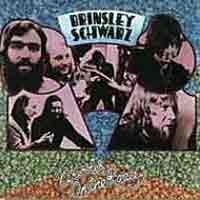 Mit
dieser zweiten Platte innerhalb eines Jahres hatte ich die Band für
mich entdeckt. Die wunderbaren Lieder von Nick Lowe, das laidback-Gitarrenspiel
von Ian Gomm & Brinsley Schwarz und vor allem die tolle
Orgel von Bob Andrews (etwa in "Surrender To The Rhythm")
machen "Nervous On The Road" zu einer meiner Alltime-Favorites! Mit
dieser zweiten Platte innerhalb eines Jahres hatte ich die Band für
mich entdeckt. Die wunderbaren Lieder von Nick Lowe, das laidback-Gitarrenspiel
von Ian Gomm & Brinsley Schwarz und vor allem die tolle
Orgel von Bob Andrews (etwa in "Surrender To The Rhythm")
machen "Nervous On The Road" zu einer meiner Alltime-Favorites!

 Mehr ...
Mehr ...
|
by Stephen Thomas Erlewine
Silver Pistol wrote the blueprint for Brinsley Schwarz's pub rock, but
Nervous on the Road perfected the group's sound, helping Brinsley to become
the definitive pub rock band in the process. Nervous on the Road has a
fuller, more detailed production than its predecessor, as well as a looser
feeling -- even with the smooth production, it sounds like the band was
captured on a good night at the Tally Ho. But what really makes the record
is its excellent selection of songs, almost all of which were written
by Nick Lowe. "Happy Doing What We're Doing," "Surrender
to the Rhythm," and "Nervous on the Road" are all great
rock & roll songs about rock & roll, spiked with an off-kilter
sense of humor. "Don't Lose Your Grip on Love" is Lowe's first
great ballad, while Ian Gomm's "It's Been So Long" is one of
his best songs. And the covers of "I Like It Like That" and
"Home in My Hand" are wonderful pub rockers, giving the album
the feeling of an excellent concert. Nevertheless, what makes Nervous
on the Road such a fine record is the combination of empathetic performances,
unpredictable songwriting, and charming unpretentiousness, all of which
help make the album one of the great forgotten rock & roll records.
|
|
| Sandy Denny: "Sandy" (Island, Sept. 1972) |
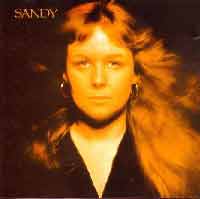 Diese
Platte habe ich mir 1976 im Londoner HMV-Shop gekauft und bin immer noch
begeistert. Nach ihrem Ausstieg bei Fairport
Convention und dem "Misserfolg" von Fotheringay
öffnete sie auf ihrem zweiten Soloalbum ihr Folkrockkonzept (Gitarre
und Mandoline von Richard Thompson!) und integrierte mit Erfolg
Country-Elemente (Sneaky Pete von den Burrito
Brothers an der Pedal Steel!) Diese
Platte habe ich mir 1976 im Londoner HMV-Shop gekauft und bin immer noch
begeistert. Nach ihrem Ausstieg bei Fairport
Convention und dem "Misserfolg" von Fotheringay
öffnete sie auf ihrem zweiten Soloalbum ihr Folkrockkonzept (Gitarre
und Mandoline von Richard Thompson!) und integrierte mit Erfolg
Country-Elemente (Sneaky Pete von den Burrito
Brothers an der Pedal Steel!) |
| Mickey Hart: "Rolling Thunder" (Warner, Sept. 1972) |
|
 "Rolling
Thunder", das Solodebüt des zu diesem Zeitpunkt ehemaligen
Grateful Dead-Schlagzeugers (er kehrte 1976 zur Band zurück), wurde
etwa zeitgleich mit Bob Weir's Solodebüt "Ace"
aufgenommen. Zwei Songs gibt es auf beiden LPs, wenn auch mit unterschiedlichen
Namen: "Rolling
Thunder", das Solodebüt des zu diesem Zeitpunkt ehemaligen
Grateful Dead-Schlagzeugers (er kehrte 1976 zur Band zurück), wurde
etwa zeitgleich mit Bob Weir's Solodebüt "Ace"
aufgenommen. Zwei Songs gibt es auf beiden LPs, wenn auch mit unterschiedlichen
Namen:
"The Main Ten" ist zum Teil eine Version von "Playing
In The Band", das auch schon auf dem letztjährigen Livealbum
der Dead erschien. "Pump song" wurde zu "Greatest Story
Ever Told". Dieser Song, so Bob Weir, "actually
started out with a pump Mickey had - he recorded the pump and told me
to write a song."
Die Besetzungsliste versammelt das "Who Is Who" der damaligen
San Francisco-Szene: Bob Weir, Jerry Garcia und Phil
Lesh von den Dead, John Cipollina von Quicksilver Messenger
Service, Paul Kantner, Grace Slick und David Freiberg
von Jefferson Airplane, Sam Andrew von Big Brother & The
Holding Conmpany, Barry Melton von Country Joe & The Fish,
sowie Stephen Stills und Zakir Hussain.
"...Mickey Hart's album "ROLLING THUNDER"
is finally finished after a year and a half's work and is due to be
released in the first part of September. It features Mickey as well
as at least thirty of the heaviest musicians around these days . . .
really a fine album!" (3rd Deadheads newsletter, August 1972)
|
| Mott The Hoople: "All The Young Dudes" (Columbia, Sept. 1972) |
|
 Glamrock
ist eigentlich nicht meine Baustelle - trotzdem ist das hier ein sehr
gutes und wichtiges Album. Aus der damaligen Zeit kann ich mich eigentlich
nur an die Single "Roll Away The Stone" von Ende '73 erinnern: Glamrock
ist eigentlich nicht meine Baustelle - trotzdem ist das hier ein sehr
gutes und wichtiges Album. Aus der damaligen Zeit kann ich mich eigentlich
nur an die Single "Roll Away The Stone" von Ende '73 erinnern:
There's a rockabilly party
On saturday night.
Are you gonna be there?
I got my invite... (oder so ähnlich)
Nun denn - die späte Entdeckung eines Klassealbum von Ian Hunter
und Mick Ralphs. Letzterer gründete danach Bad Company,
deren bekannter Song "Ready For Love" hier bereits in einer
frühen Version zu finden ist. Zwei weitere herausragende Songs
tragen die Handschrift des Produzenten David Bowie (der allerdings
auch mit weniger gelungenen Saxofoneinlagen zu hören ist). Zum
einen sein extra für die Band geschriebenes "All The Young
Dudes", das der ersten Top-Ten-Erfolg der Band wurde und angeblich
damals die Auflösung der Band wegen Erfolglosigkeit verhindern
konnte. Zum anderen der Velvet Underground-Klassiker "Sweet
Jane" (Lou Reed und Bowie waren damals auch Spezis und arbeiteten
mehr oder weniger gleichzeitig an dessen Album "Transformer")
Kleiner Gedankensprung bzw. Quiz:
Bekannte Rocksänger, die sich (vielleicht zu oft) auch am Saxofon
versucht haben, aber auf jeden Fall bessere Sänger sind:
- David Bowie
- Van Morrison
- Mike Love (Beach Boys)
- Roger Chapman (Family)
|
| Plainsong: "In Search Of Amelia Earheart" (Elektra, Sept. 1972) |
 Nur
einen Sommer und einen Herbst leuchtete der Stern von Ian Matthews
und Andy Roberts Band. Was blieb, war diese wunderbare
Platte. In den 90ern fanden beide mit neuen Mitstreitern (u. a. Julian
Dawson und Clive Gregson) für Tourneen und Alben
wieder zusammen, um ungezwungen und locker neben den jeweiligen Solokarrieren
zu musizieren. Nur
einen Sommer und einen Herbst leuchtete der Stern von Ian Matthews
und Andy Roberts Band. Was blieb, war diese wunderbare
Platte. In den 90ern fanden beide mit neuen Mitstreitern (u. a. Julian
Dawson und Clive Gregson) für Tourneen und Alben
wieder zusammen, um ungezwungen und locker neben den jeweiligen Solokarrieren
zu musizieren. |
| String Driven Thing (Charisma, Sept. 1972) |
 Diese
Platte habe ich bereits Anfang 1974 wegen des tollen Covers gekauft. Nur
mit Bass und Gitarre, aber ohne Schlagzeug wird hier ein hypnotischer
Rhythmus unter die Folksongs von Chris Adams gelegt, über
die sich ein verrückter Geiger (Graeme Smith) austobt. Diese
Platte habe ich bereits Anfang 1974 wegen des tollen Covers gekauft. Nur
mit Bass und Gitarre, aber ohne Schlagzeug wird hier ein hypnotischer
Rhythmus unter die Folksongs von Chris Adams gelegt, über
die sich ein verrückter Geiger (Graeme Smith) austobt. |
| Witthüser & Westrupp: "Bauer Plath" (Ohr, Sept. 1972) |
 Ein
deutsche Duo, bestehend aus dem Sänger, Gitarristen und Songschreiber
(also ein Liedermacher!) Bernd Witthüser und dem Multiinstrumentalisten
Walter Westrupp, das damals label- und rauschmittelbedingt eher
der Krautrock- und Hippie-Szene als der "klassischen" Leidermacherei
etwa von Rainhard Mey oder Hannes Wader zugeordnet wurde, obwohl sie in
manchen Momenten gar nicht so weit von denen weg sind. Heute würde
man sowas vielleicht "Freakfolk" nennen. Vorzüglich
aufgenommen vom legendären Dieter Dierks, begleitet auf einigen
Titeln von den Labelkollegen von Wallenstein
und einem gewissen Kölner Schlagzeuger namens Tommy Engel
... Ein
deutsche Duo, bestehend aus dem Sänger, Gitarristen und Songschreiber
(also ein Liedermacher!) Bernd Witthüser und dem Multiinstrumentalisten
Walter Westrupp, das damals label- und rauschmittelbedingt eher
der Krautrock- und Hippie-Szene als der "klassischen" Leidermacherei
etwa von Rainhard Mey oder Hannes Wader zugeordnet wurde, obwohl sie in
manchen Momenten gar nicht so weit von denen weg sind. Heute würde
man sowas vielleicht "Freakfolk" nennen. Vorzüglich
aufgenommen vom legendären Dieter Dierks, begleitet auf einigen
Titeln von den Labelkollegen von Wallenstein
und einem gewissen Kölner Schlagzeuger namens Tommy Engel
...
(09.06.2010) |
| David Ackles: "American Gothic" (Elektra, Okt. 1972) |
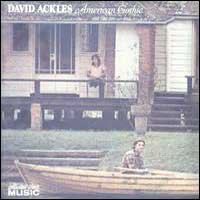 Ein ausgezeichneter, Piano spielender Singer/Songwriter aus den USA, durchaus
in der Spielkasse von Landsmann Randy Newman. Wenn man ihn überhaupt
bei uns kennt, dann als Autor von "The Road To Cairo", das 1969 ein Hit
von Julie Driscoll und Brian Auger war. Elton John
und sein textender und hier auch produzierender Kumpan Bernie Taupin
waren große Fans, weswegen sie Ackles auch zur Aufnahme dieses Albums
nach England holten. Das größte Verdienst des Produzenten Taupin ist es
dabei aber wohl gewesen, Ackles sein "eigenes Ding", ohne irgendwelche
Einschränkungen, machen zu lassen. Deswegen gibt's auf dieser Platte auch
kaum noch Elemente der Rockmusik, sondern eigentlich nur Ackles Stimme,
sein Klavier und ein großes Orchester. Somit für mich immer noch
etwas anstrengend beim Rezipieren (besser gesagt: etwas schwer bekömmlich),
aber in jedem Fall eine klasse Platte.
Ein ausgezeichneter, Piano spielender Singer/Songwriter aus den USA, durchaus
in der Spielkasse von Landsmann Randy Newman. Wenn man ihn überhaupt
bei uns kennt, dann als Autor von "The Road To Cairo", das 1969 ein Hit
von Julie Driscoll und Brian Auger war. Elton John
und sein textender und hier auch produzierender Kumpan Bernie Taupin
waren große Fans, weswegen sie Ackles auch zur Aufnahme dieses Albums
nach England holten. Das größte Verdienst des Produzenten Taupin ist es
dabei aber wohl gewesen, Ackles sein "eigenes Ding", ohne irgendwelche
Einschränkungen, machen zu lassen. Deswegen gibt's auf dieser Platte auch
kaum noch Elemente der Rockmusik, sondern eigentlich nur Ackles Stimme,
sein Klavier und ein großes Orchester. Somit für mich immer noch
etwas anstrengend beim Rezipieren (besser gesagt: etwas schwer bekömmlich),
aber in jedem Fall eine klasse Platte.

 Mehr ...
Mehr ...
| Seine 3. Platte, von 1972 und letztmals für Elektra
eingespielt. Gilt allgemein als sein Meisterwerk, ich würde sie auf
eine Stufe mit „Subway..“ stellen, wenngleich songwriterisch sicherlich
am ausgereiftesten. Das (damals schon mit superben Kritiken versehene) Album
enthält sowohl einige wenige dezente ruhige klassisch schöne Balladen,
das Piano im Vordergrund, sparsam ausgeschmückt; als auch kraftvolle
süffige theatralische Stücke mit einer Menge Bläser und Streicher,
Music Hall- bzw. Brecht/Weill-Bezug. Oft orchestral, manchmal in leichter
Schräglage. Variantenreiche Arrangements, abwechslungsreiche Strukturen
und großer Klangfarbenreichtum sorgen für eine große Bandbreite,
auch innerhalb der einzelnen Songs. Exquisit und besser denn je: Ackles´
Gesang. Wiederum gibt´s Anklänge an Scott Walker oder Fred Neil,
v.a. aber diesmal an Randy Newman; Nilsson, Jacques Brel sind auch nicht
weit weg. Und das alles auf dem Qualitätslevel dieser Größen!
Ach ja: Bernie Taupin produzierte, R. Kirby (vorher Arrangeur für Nick
Drake) fungierte als musikalischer Direktor. (Glitterhouse) |
|
|
The years have only been kind to the album considered David Ackles' masterpiece
when it was released. Ackles combined an early '70s singer-songwriter
sensibility with a theater music background that placed him as much in
the tradition of Brecht-Weill and Jacques Brel as Bob Dylan. Not only
are his songs fully realized, dramatic statements, but Ackles proves himself
a warm, accomplished singer. When this album got no higher than #167 in
the charts, Ackles' fans were heartbroken. Decades later, American Gothic
remains one of those great albums that never found its audience. It waits
to be rediscovered.
(by William Ruhlmann, All
Music Guide)
|
|
| The Band: "Rock Of Ages" (Capitol, Okt. 1972) |
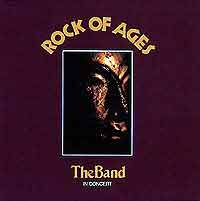 Eines
der besten Livealben aller Zeiten, Silvester 71/72 aufgenommen. Die Band
ist selber in Höchstform, dazu kommt ein Bläsersatz mit irrsinniger
Arrangements von Alan Toussaint. Bob Dylan war damals auch
dabei, ist allerdings nur auf den Bonustracks der remasterten Doppel-CD
von 2001 zu hören. Für die erste CD-Veröffentlichung wurde
das ursprüngliche Doppelalbum sogar um einen Titel gekürzt. Eines
der besten Livealben aller Zeiten, Silvester 71/72 aufgenommen. Die Band
ist selber in Höchstform, dazu kommt ein Bläsersatz mit irrsinniger
Arrangements von Alan Toussaint. Bob Dylan war damals auch
dabei, ist allerdings nur auf den Bonustracks der remasterten Doppel-CD
von 2001 zu hören. Für die erste CD-Veröffentlichung wurde
das ursprüngliche Doppelalbum sogar um einen Titel gekürzt. |
| David Bowie: "The Rise And The Fall Of Ziggy Stardust..." (RCA, Okt. 1972) |
 Mit dieser Platte hat Bowie zusammen mit Mick Ronson ein
absolutes Meisterwerk geschaffen! Die Geschichte: Androgyner Außerirdischer
landet in dubioser Mission auf der Erde, gründet Band, wird zum Superstar
und begeht Selbstmord: das kann man wohl nicht mehr toppen.
Mit dieser Platte hat Bowie zusammen mit Mick Ronson ein
absolutes Meisterwerk geschaffen! Die Geschichte: Androgyner Außerirdischer
landet in dubioser Mission auf der Erde, gründet Band, wird zum Superstar
und begeht Selbstmord: das kann man wohl nicht mehr toppen.

 Mehr ...
Mehr ...
This album documents one of the most elaborate self-mythologizing
schemes in rock, as Bowie created the glittery, messianic alter ego Ziggy
Stardust ("well-hung and snow-white tan"). The bouncy glam-rock
Bowie made with guitarist Mick Ronson is an irresistible blend of sexy,
campy pop and blues rock, with enduring tracks such as "Hang On to
Yourself" and "Suffragette City." The anthem "Ziggy
Stardust" was one of rock's earliest, and best, power ballads. "I
consider myself responsible for a whole new school of pretensions,"
Bowie said. "They know who they are. Don't you, Elton? Just kidding.
No, I'm not." (Rolling Stone)
Total album sales: Under 500,000, Peak chart position: 75
|
| Bobby Charles: "Bobby Charles [Small Town Talk]" (Bearsville, Okt. 1972) |
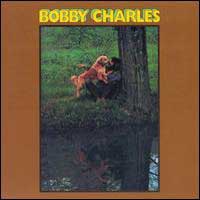 Bobby Charles ist der Autor vieler Rock'n'Roll-Klassiker, z. B. "See
You Later Alligator", meist unter dem Namen Robert Guidry
veröffentlicht. Dies ist - nach meinem Kenntnisstand - sein spätes
Debüt, eingespielt mit den Kumpels von The
Band, produziert von Rick Danko
und John Simon.
Bobby Charles ist der Autor vieler Rock'n'Roll-Klassiker, z. B. "See
You Later Alligator", meist unter dem Namen Robert Guidry
veröffentlicht. Dies ist - nach meinem Kenntnisstand - sein spätes
Debüt, eingespielt mit den Kumpels von The
Band, produziert von Rick Danko
und John Simon.

 Mehr ...
Mehr ...
|
Hooking up with the Band, specifically Rick Danko and their producer
John Simon, was one of the smartest moves Bobby Charles ever made. His
subsequent eponymous album on Bearsville not only gave him a bigger audience,
but led to the perfect production for his sly, subtle blend of New Orleans
R&B, rock & roll, and country. Partially, that's because the production
is fuller, richer than his sides for Chess, Jewel, and Paula, boasting
not just some grit, but a sweetness on ballads like "I Must Be in
a Good Place Now," a tune every bit as good as those from the singer/songwriters
who dominated the charts in 1972. This gives the album an earthier quality
than anything else he recorded; it also makes the album feel like a perfect
companion piece to other roots rock albums from the time like, of course,
the Band. Still, there's a special charm to this record, largely because
while it sounds contemporary, it retains Charles' mellow vibe and his
sharp songwriting. The songs come on slow -- "Street People,"
"He's Got All the Whiskey," and "Small Town Talk"
all slowly unwind -- but the slow build is friendly, welcoming you into
the song. This isn't lazy music, but it takes its time and it's better
for it; it's perfect music for a hot summer afternoon. It's a true hidden
gem of blue-eyed soul, Southern R&B, and early '70s roots rock (and
early-'70s singer/songwriterism, for that matter).
(by Stephen Thomas Erlewin, All
Music Guide)
|
|
| Tim Buckley: "Greetings From L.A." (Bizarre/Straight, Okt. 1972) |
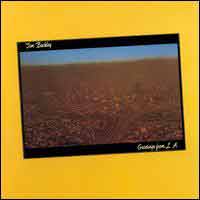 Diese Buckley-Platte hätte ich fast vergessen. Mehr Funk und Rock
als auf den älteren Alben: deshalb von vielen Leuten abgelehnt, was
aber der Qualität der Songs nicht gerecht wird!
Diese Buckley-Platte hätte ich fast vergessen. Mehr Funk und Rock
als auf den älteren Alben: deshalb von vielen Leuten abgelehnt, was
aber der Qualität der Songs nicht gerecht wird!

 Mehr ...
Mehr ...
HAPPY SAD und BLUE AFTERNOON markierten 1968/69 einen wichtigen Einschnitt in Tim Buckleys musikalischer Entwicklung. Er hatte sich nach HAPPY SAD gerade von seiner Firma Elektra getrennt und war zu Frank Zappas Straight-Label übergewechselt, das ihm das verlockende Angebot voller künstlerischer Kontrolle gemacht hatte. Mit dem fünften Album, BLUE AFTERNOON, begann dann tatsächlich für Tim Buckley ein völliger Neubeginn. Begraben wurde ein Liedersänger, der sich durch die normierten Formen des Songs geschränkt sah. Wiedergeboren wurde ein neuer Tim Buckley, der sich nun mit seinen vokalen und instrumentalen Möglichkeiten über alle ungeschriebenen Gesetze der Pop-Musik hinwegsetzt. Er schreit und schmeichelt, flucht und flüstert, droht, zischt, stöhnt und lacht, die Stimme ist warm und weich, im nächsten Moment schon hart, kalt, wandelt sich zu kindlichem Plappern, zu schriller Erregung, zu melancholischer Weichheit. Er singt nicht mehr Texte, inhaltsschwere Worte, sondern Klänge, losgelöste Silben, deren Konturen er wie Farben auflöst und vermischt. Alle Bereiche menschlicher Emotionen scheint diese Stimme malen, jede Empfindung registrieren zu können.
Mit seinem letzten und vollkommensten Album STARSAILOR hob dann Buckley vollends ab und segelte in andere Milchstraßen auf und davon. Akustische Traumgebilde brachte er mit, voller bizarrer Schönheit und durchsichtiger Reinheit.
Das war 1970. In mehr als zwei Jahren gab dann Buckley keine Lebenszeichen von sich und schien schon in die Pop-History eingehen zu wollen. Nach langem Schweigen schickte er nun endlich Grüße, Grüße aus Los Angeles. GREETINGS FROM L.A.
Aber es scheint, als habe der Smog von L.A. die feinnervige, glasklare Musik der letzten Platten arg zersetzt und nur noch das grobe Geäst der musikalischen Strukturen verschont. Wäre dies Tim Buckleys erste Platte, so könnte man sagen: Immerhin, ein ungewöhnlicher Sänger mit einem ganzen Schwung melodischer Einfälle, mit jener Unbeschwertheit und Relaxtheit, wie sie nur dem amerikanischen Country-Rock zu eigen ist, dem dazu mit einem alten Session-Fuchs wie Chuck Rainey am Baß ein Mann zur Verfügung steht, der für Drive und flüssige Baß-Linien sorgt, alles in allem eine stimmige, hörenswerte Platte.
Vergleicht man sie aber mit den Maßstäben, die Buckley selbst in den vergangenen Jahren gesetzt hat, so stimmt das Ergebnis traurig. Warum muß ein Mann, der wie kaum ein anderer mit seiner Musik Gefühle, Stimmungen und Gedanken zeichnen kann, warum muß gerade dieser Tim Buckley nun Background-Streicher verwenden, Emotionen von der Stange, im Dutzend billiger? Wo sind die vielschichtigen Gewebe, die weitausholenden, verflochtenen Instrumental-Teile der früheren Platten? Was ist aus dieser unheimlichen Stimme geworden, die alle menschlichen Ausdrucksmöglichkeiten zu beherrschen schien? Was früher Magie war, ist nun zu gehobener Konsumware degeneriert. Die Stimme beschwört nicht mehr, sondern schlägt Purzelbäume - Vokal-Akrobatik ohne Netz und emotionalen Boden. Subtile Stimmungsbilder haben pfeifbaren Melodien Platz gemacht, die musikalischen Höhenflüge sind in den Sumpf von Routine und Klischee gestürzt.
Der Aufstieg und Fall des Tim Buckley weckt Erinnerungen an einen anderen großen Sänger, der ebenso plötzlich und unerwartet seine schöpferische Individualität verlor: Van Morrison. ASTRAL WEEKS übermittelte wie der STARSAILOR Musik von anderen Sternen, voll von persönliches Empfindungen und daher voll von ungewöhnlichen, einmaligen Einfällen. Beide, Tim Buckley und Van Morrison, waren einmalige Sänger und Musiker - beide sind heute in die unübersehbare Masse der Sänger/Songschreiber zurückgefallen. Geblieben ist ihnen noch ihre langjährige Routine und Erfahrung, die ihnen zu gekonnten, gefälligen Platten verhilft GREETINGS FROM L.A. ist eine gefällige Platte - doch eine bittere Enttäuschung.
(Bernd Gockel, Sounds, 1972)
“Starsailor” war zu extrem für die Buckley-Fans und die Liveshows dieser Zeit noch extremer. Das Album verkaufte sich sehr schlecht, was Buckley in die Depression trieb. Barbiturate. Kokain und Heroin sollten ihm darüber hinweg helfen.
1972 erschien schließlich “Greetings From LA”, ein Album, bei dem Buckley wiederum eine völlig andere Richtung einschlug. Straighter Rock, Al Green-style Soul, viel Funk und statt mysteriöser Texte direkte Statements zum Thema Sex. “Sweet Surrender” war zu meiner Jugend ein absoluter Dancefloor-Hit in unserer Dorfdisco.
(Glitterhouse)
Stepping back from the swooping avant-garde touches of Starsailor for a fairly greasy, funky, honky tonk set of songs, the opening lines of Greetings from L.A. set the tone: "I went down to the meat rack tavern/And I found myself a big ol' healthy girl." Sassy backing vocalists, honking sax, and more add to the atmosphere, while Tim Buckley himself blends his vocal acrobatics with touches not unfamiliar to fans of Mick Jagger or Jim Morrison. The studio band backing him up might not be the equal to, say, War, but in their own way they do the business; extra touches like the string arrangement on "Sweet Surrender" help all the more. The argument that this was all somehow a compromise or sellout doesn't seem to entirely wash. While no doubt there were commercial pressures at play, given Buckley's constant change from album to album it seems like he simply found something else to try, which he did with gusto. "Get On Top," one of his best numbers, certainly doesn't sound like something aimed for the charts. The music may have a solid groove to it (Kevin Kelly's organ is worth a mention), but Buckley's frank lyrics and improv scatting both show it as him following his own muse.
( Ned Raggett, All Music Guide)
|
| Rita Coolidge: "The Lady's Not For Sale" (A&M, Okt. 1972) |
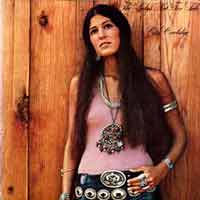 Ach ja, Rita... Ich liebe diese Platte heiß und innig - und zwar aus mehreren
Gründen. Ein wichtiger ist zugegebenermaßen das Coverfoto, aber Rita
singt auch erstklassig, hat ein wunderbares Händchen bei der Songauswahl
(u. a. "My Crew" von ihrer Schwester Priscilla und ihrem
Schwager Booker T. Jones, "Bird On A Wire" von Leonard
Cohen, "I'll Be Your Baby Tonight" von Bob Dylan
und "The Lady's Not For Sale" von ihrem Lover Kris Kristofferson)
und eine erstklassige Band mit eingebauter Laidback-Garantie (Bernie Leadon,
Russ Kunkel, Jim Keltner, Marc Benno, Lee Sklar, Mike Utley, Carl Radle).
Ach ja, Rita... Ich liebe diese Platte heiß und innig - und zwar aus mehreren
Gründen. Ein wichtiger ist zugegebenermaßen das Coverfoto, aber Rita
singt auch erstklassig, hat ein wunderbares Händchen bei der Songauswahl
(u. a. "My Crew" von ihrer Schwester Priscilla und ihrem
Schwager Booker T. Jones, "Bird On A Wire" von Leonard
Cohen, "I'll Be Your Baby Tonight" von Bob Dylan
und "The Lady's Not For Sale" von ihrem Lover Kris Kristofferson)
und eine erstklassige Band mit eingebauter Laidback-Garantie (Bernie Leadon,
Russ Kunkel, Jim Keltner, Marc Benno, Lee Sklar, Mike Utley, Carl Radle).

 Mehr ...
Mehr ...
|
Rita Coolidge's third album is a fine mixture of covers and originals
that manages to showcase her fine vocal abilities as well as show off
an impressive array of friends. Booker T. Jones contributes not only his
fine flute skills, but also two songs. Noted guitarist and songwriter
Marc Benno also lends his impressive, laid-back guitar work all throughout
the album. His "Donut Man" adds an air of lazy funk to the proceedings.
Bob Dylan's "I'll Be Your Baby Tonight" probably gets the most
soulful reading, with Coolidge's take on Leonard Cohen's "Bird on
a Wire" following close behind. Kris Kristofferson is represented
at the tail end of the album with the title track. She may not have had
the most distinctive of voices, but Coolidge definitely captured the sort
of laid-back energy and approach associated with early-'70s country-rock.
If Rita Coolidge's voice and stellar class of backing musicians aren't
enough to sway you, consider the cover that shows her bedecked in what
looks to be several pounds of turquoise, or the gatefold in which she
appears pensive, with Stonehenge not too far in the background. (by Jon
Pruett, AMG)
|
|
| Coulson, Dean, McGuinness, Flint: "Lo And Behold" (Sire, Okt. 1972) |
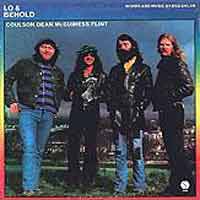 Eine
wunderbare Platte, nur mit obskuren Dylan Songs. Meistens solche,
die der Meister selber bisher nicht veröffentlicht hat. Tom McGuinness
und Hughie Flint gründeten Jahre später die Blues
Band. Eine
wunderbare Platte, nur mit obskuren Dylan Songs. Meistens solche,
die der Meister selber bisher nicht veröffentlicht hat. Tom McGuinness
und Hughie Flint gründeten Jahre später die Blues
Band. |
| "Eagles" (Asylum, Okt. 1972) |
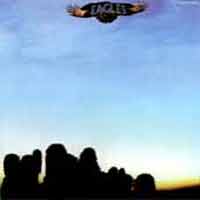 Bei ihrem Debüt waren die Eagles um Don Henley und Glenn
Frey noch relativ weit weg vom späteren, mega-erfolgreichen Sound.
Für das Countryelement sorgte vor allem der Saitenvirtuose Bernie
Leadon. Das erste Stück der Platte, "Take It Easy"
aus der Feder von Jackson Browne und Glenn Frey , ist inzwischen ein Countryrock-Klassiker
und war auch lange Zeit Opener bei den "Waiting For Louise"-Konzerten.
Bei ihrem Debüt waren die Eagles um Don Henley und Glenn
Frey noch relativ weit weg vom späteren, mega-erfolgreichen Sound.
Für das Countryelement sorgte vor allem der Saitenvirtuose Bernie
Leadon. Das erste Stück der Platte, "Take It Easy"
aus der Feder von Jackson Browne und Glenn Frey , ist inzwischen ein Countryrock-Klassiker
und war auch lange Zeit Opener bei den "Waiting For Louise"-Konzerten.

 Mehr ...
Mehr ...

Balance is the key element of the Eagles' self-titled debut album, a collection that contains elements of rock & roll, folk, and country, overlaid by vocal harmonies alternately suggestive of doo wop, the Beach Boys, and the Everly Brothers. If the group kicks up its heels on rockers like "Chug All Night," "Nightingale," and "Tryin'," it is equally convincing on ballads like "Most of Us Are Sad" and "Train Leaves Here This Morning." The album is also balanced among its members, who trade off on lead vocal chores and divide the songwriting such that Glenn Frey, Bernie Leadon, and Randy Meisner all get three writing or co-writing credits. (Fourth member Don Henley, with only one co-writing credit and two lead vocals, falls a little behind, while Jackson Browne, Gene Clark, and Jack Tempchin also figure in the writing credits.) The album's overall balance is worth keeping in mind because it produced three Top 40 hit singles (all of which turned up on the massively popular Eagles: Their Greatest Hits 1971-1975) that do not reflect that balance. "Take It Easy" and "Peaceful Easy Feeling" are similar-sounding mid-tempo folk-rock tunes sung by Frey that express the same sort of laid-back philosophy, as indicated by the word "easy" in both titles, while "Witchy Woman," a Henley vocal and co-composition, initiates the band's career-long examination of supernaturally evil females. These are the songs one remembers from Eagles, and they look forward to the eventual dominance of the band by Frey and Henley. But the complete album from which they come belongs as much to Leadon's country-steeped playing and singing and to Meisner's melodic rock & roll feel, which, on the release date, made it seem a more varied and consistent effort than it did later, when the singles had become overly familiar.
(by William Ruhlmann, All Music Guide)
|
| Tom Fogerty: "Excalibur" (Fantasy, Okt. 1972) |
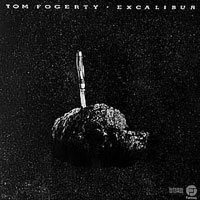 Das
zweite Soloalbum des ehemaligen zweiten Gitarristen von CCR,
als Begleitband fungiert die Merl
Saunders/Jerry Garcia-Band mit John Kahn am Bass und Bill
Vitt am Schlagzeug. Für Deadfreaks sicherlich interessant, aber
weil sich die Band klar in den Dienst des Sängers und seiner Songs
stellt kein typisches Garcia-Album. Und besser als sein Ruf. Das
zweite Soloalbum des ehemaligen zweiten Gitarristen von CCR,
als Begleitband fungiert die Merl
Saunders/Jerry Garcia-Band mit John Kahn am Bass und Bill
Vitt am Schlagzeug. Für Deadfreaks sicherlich interessant, aber
weil sich die Band klar in den Dienst des Sängers und seiner Songs
stellt kein typisches Garcia-Album. Und besser als sein Ruf. |
| Captain Beafheart & His Magic Band: "Clear Spot" (Reprise, Nov. 1972) |
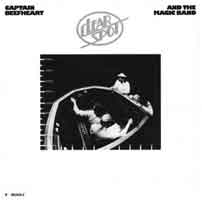 Eines
der "kommerzielleren" Alben des Käp'tens, was aber nicht
viel heißen soll. Enthält mit "Her Eyes Are A Blue Million
Miles" eines der wunderschönsten Liebeslieder, das ich kenne
und mit "Too Much Time" ein Lied, aus dem die englische Formation
Working Week 1986 eine tolle Latinjazzversion zauberte. Eines
der "kommerzielleren" Alben des Käp'tens, was aber nicht
viel heißen soll. Enthält mit "Her Eyes Are A Blue Million
Miles" eines der wunderschönsten Liebeslieder, das ich kenne
und mit "Too Much Time" ein Lied, aus dem die englische Formation
Working Week 1986 eine tolle Latinjazzversion zauberte. |
| Ry Cooder: "Boomer's Story" (Reprise, Nov. 1972) |
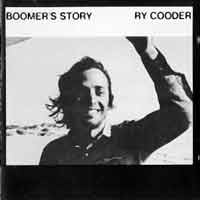 Sein
drittes Album. Virtuoses Spiel auf der Slidegitarre. Aber vor allem sehr
gutes Songmaterial: Die Ballade "Dark End Of The Street" ist
wunderbar interpretiert mit einem göttlichen Solo vom Meister. Zuvor
hatte er u.a. beim Debütalbum
von Little Feat und beim Meisterwerk "Sticky
Fingers" der Stones seine Finger und seinen Bottleneck
im Spiel. Sein
drittes Album. Virtuoses Spiel auf der Slidegitarre. Aber vor allem sehr
gutes Songmaterial: Die Ballade "Dark End Of The Street" ist
wunderbar interpretiert mit einem göttlichen Solo vom Meister. Zuvor
hatte er u.a. beim Debütalbum
von Little Feat und beim Meisterwerk "Sticky
Fingers" der Stones seine Finger und seinen Bottleneck
im Spiel.

 Mehr ...
Mehr ...
The file texte/Cooder-Boomers.htm does not exist
|
| Free: "Heartbreaker" (Island, Nov. 1972) |
 Das
letzte Aufbäumen dieser großartigen Band. Wegen der Single "Wishing
Well" auch mein Lieblingsalbum der Band. Sänger Paul Rodgers
und Drummer Simon Kirke waren als einzige vom Original-Lineup übrig
geblieben. Der geniale, aber mit Drogenproblemen belastete Gitarrist Paul
Kossoff war für einige Songs zurückgekehrt, aber bereits bei Fertigstellung
des Albums schon wieder weg und wurde deshalb auf Drängen der Plattenfirma
nur als Gastmusiker geführt. Auf "Wishing Well" spielt stattdessen
der amerikanische Studiogitarrist Snuffy Walden, der vom Keyboarder
"Rabbitt" John Bundrick vorgeschlagen wurde. Rodgers
Songwriting-Partner, der langjährige Bassist Andy Fraser, war auch
nicht mehr dabei und durch den Japaner Tetsu Yamauchi ersetzt worden. Das
letzte Aufbäumen dieser großartigen Band. Wegen der Single "Wishing
Well" auch mein Lieblingsalbum der Band. Sänger Paul Rodgers
und Drummer Simon Kirke waren als einzige vom Original-Lineup übrig
geblieben. Der geniale, aber mit Drogenproblemen belastete Gitarrist Paul
Kossoff war für einige Songs zurückgekehrt, aber bereits bei Fertigstellung
des Albums schon wieder weg und wurde deshalb auf Drängen der Plattenfirma
nur als Gastmusiker geführt. Auf "Wishing Well" spielt stattdessen
der amerikanische Studiogitarrist Snuffy Walden, der vom Keyboarder
"Rabbitt" John Bundrick vorgeschlagen wurde. Rodgers
Songwriting-Partner, der langjährige Bassist Andy Fraser, war auch
nicht mehr dabei und durch den Japaner Tetsu Yamauchi ersetzt worden.
|
| Can: "Ege Bamyasi" (United Artists/Spoon, Nov. 1972) |
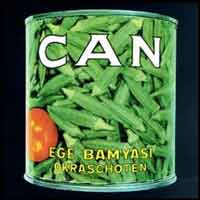 Cans nächster Geniestreich warf sogar zwei Hitsingles ab: "Spoon"
aus dem damaligen Durbridge-Krimi und "Vitamin-C". Ein echtes
Meisterwerk aus Köln.
Cans nächster Geniestreich warf sogar zwei Hitsingles ab: "Spoon"
aus dem damaligen Durbridge-Krimi und "Vitamin-C". Ein echtes
Meisterwerk aus Köln.

 Mehr ...
Mehr ...
| "By the time of 1972's Ege Bamyasi, Can had consolidated,
with singer Damo Suzuki fully entrenched as the unstable Michael Mooney's
replacement. Suzuki's vocals range from shrieks to inaudible chanting, tackling
subjects as mundane as "your vitamin C" while implying an archetypal
depth. Evidence of a band at the height of their interactive powers is here.
Anchored by the "percussion and flexation" (as he's credited)
of Jaki Liebezeit, Can delivers seven pounding sermons of rhythmic prowess,
peaking with the 10:30 sound storm of "Soup." Liebezeit's long
drum riff in "Pinch"--pegged by a resounding bass thoom at the
end of each repetition--creates an ellipse in which feedback bursts, guitar
and keyboard note clusters, and Damo's vocal witchery combine into a perfectly
balanced, loping cyclone, with each element beautifully playing off the
next. Like Miles's On the Corner, Ege Bamyasi is a definitive statement
on merging jazz ideology with the surging menace of rock & roll."
(Gene Booth) |
|
| Grateful Dead: "Europe '72" (Warner Bros., Nov. 1972) |
 Nach
der ersten Europatournee erschien dieses Dreifachalbum, was damals kommerziell
natürlich sehr gewagt war. Mit dieser Platte fielen sie mir damals
jedoch erstmalig auf, es hat dann aber noch ein paar Jahre gebraucht,
bis ich gänzlich den Dead-Virus verfiel. Nach
der ersten Europatournee erschien dieses Dreifachalbum, was damals kommerziell
natürlich sehr gewagt war. Mit dieser Platte fielen sie mir damals
jedoch erstmalig auf, es hat dann aber noch ein paar Jahre gebraucht,
bis ich gänzlich den Dead-Virus verfiel. |
| Herbie Hancock: "Crossings" (Warner, Nov. 1972) |
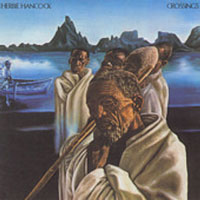 (29.12.2009)
(29.12.2009)

 Mehr ...
Mehr ...
With the frenzied knocking of what sounds like a clock shop gone berserk, Crossings takes the Herbie Hancock Sextet even further into the electric avant-garde, creating its own idiom. Now, however, the sextet has become a septet with the addition of Dr. Patrick Gleeson on Moog synthesizer, whose electronic decorations, pitchless and not, give the band an even spacier edge. Again, there are only three tracks — the centerpiece being Hancock's multi-faceted, open-structured suite in five parts called "Sleeping Giant." Nearly 25 minutes long yet amazingly cohesive, "Sleeping Giant" gathers a lot of its strength from a series of funky grooves — the most potent of which explodes at the tail-end of Part Two — and Hancock's on-edge Fender Rhodes electric piano solos anticipate his funk adventures later in the '70s. Bennie Maupin's "Quasar" pushes the session into extraterrestrial territory, dominated by Gleeson's wild Moog effects and trumpeter Eddie Henderson's patented fluttering air trumpet. Even stranger is Maupin's "Water Torture," which saunters along freely with splashes of color from Hancock's spooky Mellotron and fuzz-wah-pedaled Fender Rhodes piano, Gleeson's electronics, and a quintet of voices. Still a challenging sonic experience, this music (which can be heard on Warners' Mwandishi two-CD set) has yet to find its audience, though the electronica-minded youth ought to find it dazzling.
(by Richard S. Ginell, All Music Guide)
|
| Hawkwind: "Doremi Fasol Latido" (United Artistes, Nov. 1972) |
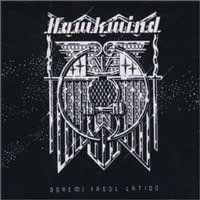 Das
dritte Album der Band ist eigentlich nicht mein Favorit - und wurde auch
lange von mir ignoriert: zu wenig Hippie zuviel Hardrock. Aber eigentlich
ist es doch auch ganz schön ... Das
dritte Album der Band ist eigentlich nicht mein Favorit - und wurde auch
lange von mir ignoriert: zu wenig Hippie zuviel Hardrock. Aber eigentlich
ist es doch auch ganz schön ...
(25.07.2010)

 Mehr ...
Mehr ...
|
Doremi may not be Hawkwind's most renowned album, but it carries the
same type of prog rock spaciness as their first two releases. Even though
the keyboard playing is trimmed down just a tad, the introduction of Ian
Kilmister, otherwise known as Lemmy of Motörhead fame, makes up for
it. With Lemmy's hard-lined guitar playing and Del Dettmar's synthesizer
stabs, tracks like "Space Is Deep" and "The Watcher"
are infused with elaborate instrumental meanderings in perfect Hawkwind
fashion. The longer tracks, both "Brainstorm" and "Time
We Left This World Today," have Lemmy getting settled in the band's
extraordinary milieu, but end up being the album's strongest cuts. There's
a harder feel to the songs all the way through, with the guitar and drums
coming to the forefront ahead of Dik and Mik's "generators"
and "hot electronics." Doremi is the inaugural album for drummer
Simon King, and with guitarist Dave Anderson and percussion man Terry
Ollis now departed, Hawkwind still manages to muster up a firm intergalactic
space-metal atmosphere...only with a more rugged thrust.
(by Mike DeGagne, AMG)
|
|
|
Hmm... well, it sounds exactly the same way as does its predecessor,
but something actually makes me choose Doremi over In Search Of Space.
Perhaps it has something to do with the fact that Dave Anderson had left
the band and was replaced by Ian Kilmister, yeah, yeah, it's the Lemmy
of future Motorhead fame. Not surprisingly, certain tracks on here now
sound like early Motorhead - or, well, it's more correct to say that early
Motorhead sounds a bit like some of the tracks on here. Can't you hear
the echoes of 'Time We Left This World Today' in, say, 'Iron Horse'? You
sure can.
In any case, one might poke fun at the poor Hawkwind for their tired 4/4
beats - how's that for ten-minute long songs that don't shift key or tempo
even once? - but if ye try to deny the trancey charm induced by the tattooed
potheads on some of the tracks, you're sure one nasty little sucker. Relax
and let the music get to you, I say, trying to imitate some of the flamers
who tell me the same things. Actually, I could have given the record four
stars - what's it to me? - except that I don't feel at all partial to
'Brainstorm'. I understand that it's actually shorter than its previous
analog by a whoppin' four minutes, and, once again, the vocal parts of
the song are fine and cool, but everything else is just... eh, I mean,
it sounds as if In Search Of Space never ended and they decided to re-record
it once again. Yeah, yeah, it's really soothing to be able to mount upon
Lemmy's unerring bass riff and watch the keyboardish comets and guitarish
meteors swish past in all of their trippy glory, but Christ! Is it really
necessary to double your efforts in such a blatant way?
However, the rest of the songs, which all more or less fit into six or
seven minutes, or even less, are excellently crafted - I really really
dig that stuff. 'Space Is Deep' opens with a lengthy acoustic section
that is equally trippy and visionary but doesn't pound so heavily on your
brain, and then transforms into yet another 4/4 shuffle which is far less
gloomy than the usual Hawkwind stuff, mainly due to some anthemic synthesizer
solos in the "daddy be proud of your planet" style. 'The Lord
Of Light' is an absolute stunner: you gotta hear that hellish rumble that
Lemmy produces, and while I think that Brock could have had refrained
from reciting the stupid lyrics three times in a row, they don't bother
me at all. Actually, what I'd like to state here is that Hawkwind lyrics
aren't really stupid. Hawkwind lyrics, just like the lyrics of Rush several
years later, are just primitive - and that's a different thing. Primitive
lyrics are lyrics derived from pocketbook fantasy, and since we all know
that the music of Hawkwind was initially presupposed to be pocketbook
fantasy soundtracks, we all know what to expect. But they're actually
well-constructed and not idiotic in their essence, like, say, something
like Uriah Heep's 'Magician's Birthday'. Here's 'Lord Of Light' for you:
'The elements that gather here upon this hill shall cast no fear, of lines
that match across the world for travel which no man has ever heard'. Eh?
Blah blah blah, I really don't care. 'Let's all go down to the magician's
birthday' irritates me far more.
Anyway, who the heck cares, they sing their lyrics as if they had no teeth
- you can't make out anything anyway, and so much for the better. Hawkwind
songs are essentially meant for the listener to bring in his own interpretations,
and that's the best part of it. 'Down Through The Night' creates excellent
winterish imagery, with loads of white noise descending upon Brock's melancholy
singing and acoustic strumming; and the lengthy 'Time We Left This World
Today' is a groovy bluesy jam that has more things going on it than the
entire Uriah Heep catalog. And Kilmister's 'The Watcher' ends the album
on a quiet, yet menacing note - Lemmy sings in such a strange 'negligent'
but dark tone, as if saying, 'we'll come back ya hear'.
It would be useless trying to analyse this stuff in details. Heck, it
would be useless trying to analyse this stuff AT ALL! This is just the
kind of record that doesn't fit into any logical scheme: according to
every parameter and criterion, it should suck balls, but on the gut level
it turns out to be incredibly cool. Does this mean that logic fails? No,
of course not! says I displaying some brand new positive thinking. If
logic fails, time to expand logic's boundaries. Or create a new logic.
Ergo, if you wanna create yourself a new logic, you gotta buy Doremi Fasol
Latido, dig it, dig it twice, dig it thrice, and then try to rationally
explain your feelings.
One, two, three, go. Good luck to you. Oh and, by the way, for some strange
reason, a large part of Hawkwind fans don't like this album at all, saying
that it was uninspired and formulaic. EH????!!!???? Now this is the kind
of logic that completely escapes me.
(George
Starostin, Rating: * * * 1/2)
|
|
| The Hollies: "Romany" (Polydor, Nov. 1972) |
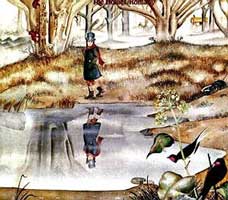 Ein eher unbekanntes Hollies-Album, vielleicht deshalb unbekannt, weil
es meines Wissens nach das einzige ist ohne den gewohnten Leadsänger Allan
Clarke, der hier durch einen Schweden (!) namens Mikael Rickfors
ersetzt wurde. Beim Cover ist der Bezug zum erfolgreichen Vorgänger
Distant Light sicherlich beabsichtigt,
aber es nahmen der Band damals viele Leute den Wechsel des Sängers
übel, oder netter gesagt: es klang eben nicht mehr "so richtig"
nach den Hollies. Auch ich habe mir die Platte damals nicht gekauft, besaß
aber vom Grabbeltisch eine der vielen Singleauskopplungen: "Jesus
Was A Crossmaker". Im Zuge meiner Entdeckung von Judee
Sill, der Komponistin dieses Lieds, im vergangenen Jahr wurde mein
Drang immer größer, auch die Version der Hollies mal wieder zu hören
und ich kann nur sagen: eine wirklich tolle Aufnahme, die den Kauf der
teuren französischen Import-CD und die lange Wartezeit absolut gerechtfertigt
hat. Außerdem gibt es noch weitere, sehr exquisite Coverversionen zu hören:
"Down River" von David Ackles, zu finden im Original
auf dessen Debütalbum von 1968,
und "Magic Woman Touch", zu finden auf "The
Going's Easy", dem zweiten Album einer unbekannten englischen
Band mit leicht größenwahnsinnigem Namen: "The
Greatest Show On Earth". Deren Sänger Colin Horton-Jenning
verfasste noch drei weitere Lieder für "Romany", u. a. das rockige
"Delaware Taggett And The Outlaw Boys", welches er selber erst
zwei Jahre später mit der Band Taggett
aufnahm, die nun überhaupt kein Schwein kennt. Auch ich nicht wirklich.
Aber der Namen ist doch wieder deutlich bescheidener.
Ein eher unbekanntes Hollies-Album, vielleicht deshalb unbekannt, weil
es meines Wissens nach das einzige ist ohne den gewohnten Leadsänger Allan
Clarke, der hier durch einen Schweden (!) namens Mikael Rickfors
ersetzt wurde. Beim Cover ist der Bezug zum erfolgreichen Vorgänger
Distant Light sicherlich beabsichtigt,
aber es nahmen der Band damals viele Leute den Wechsel des Sängers
übel, oder netter gesagt: es klang eben nicht mehr "so richtig"
nach den Hollies. Auch ich habe mir die Platte damals nicht gekauft, besaß
aber vom Grabbeltisch eine der vielen Singleauskopplungen: "Jesus
Was A Crossmaker". Im Zuge meiner Entdeckung von Judee
Sill, der Komponistin dieses Lieds, im vergangenen Jahr wurde mein
Drang immer größer, auch die Version der Hollies mal wieder zu hören
und ich kann nur sagen: eine wirklich tolle Aufnahme, die den Kauf der
teuren französischen Import-CD und die lange Wartezeit absolut gerechtfertigt
hat. Außerdem gibt es noch weitere, sehr exquisite Coverversionen zu hören:
"Down River" von David Ackles, zu finden im Original
auf dessen Debütalbum von 1968,
und "Magic Woman Touch", zu finden auf "The
Going's Easy", dem zweiten Album einer unbekannten englischen
Band mit leicht größenwahnsinnigem Namen: "The
Greatest Show On Earth". Deren Sänger Colin Horton-Jenning
verfasste noch drei weitere Lieder für "Romany", u. a. das rockige
"Delaware Taggett And The Outlaw Boys", welches er selber erst
zwei Jahre später mit der Band Taggett
aufnahm, die nun überhaupt kein Schwein kennt. Auch ich nicht wirklich.
Aber der Namen ist doch wieder deutlich bescheidener.
16.02.2006

 Mehr ...
Mehr ...
The group's follow-up album to a pair of hit singles ("Long Cool Woman," "Long Dark Road") tries for the harder sound that sold those singles. Romany's cover art deliberately recalls its immediate predecessor Distant Light, but otherwise the two albums are rather dissimilar. For starters, this is the album that the group cut during the short-lived tenure of Mikael Rickfors as lead singer -- he's more of a weighty, David Clayton-Thomas type singer than Allan Clarke was, much more of a hard-rock crooner, as is evident on the version of David Ackles' "Down River" and the self-consciously heavy rocker "Slow Down." Tony Hicks and Terry Sylvester make a valiant effort to meld their harmonies into the familiar Hollies mode, and succeed on songs such as "Delaware Taggett and the Outlaw Boys" and "Jesus Was a Crossmaker," though apart from "Magic Woman Touch," most of this album's original first side lacks the memorable hooks, melodies, or tempos needed for hit material. There are tunes worth discovering, however, for anyone who has never heard this album. The title track, although it was too moody and arty to ever become a hit, could be the prettiest song to come from the group after the 1960s; the Tony Hicks co-authored "Blue in the Morning" has a hard-edged, crisp, economical guitar part reminiscent of "Long Dark Road"; and "Courage of Your Convictions" seems to be a conscious attempt at emulating the sound of "Long Cool Woman." The playing and singing are impressive, and these are solid album tracks, if not necessarily chart-topping material.
(by Bruce Eder, All Music Guide)
|
| Bonnie Raitt: "Give It Up" (Warner Bros., Nov. 1972) |
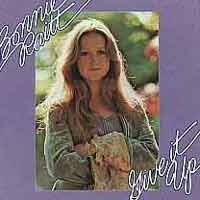 Bonnies
zweites Album ist mir vor allem wegen der Lieder eines der liebsten: "If
You Got To Make A Fool Of Somebody" (Rudy Clarke), "Under The
Falling Sky" (Jackson Browne) und "Love Has No Pride" (Eric
Kaz). Unter den tollen Begleitmusikern besonders erwähnenswert: Jerry
Garcia-Orgelspieler Merl Saunders, der britische Jazzbassist
Dave Holland und Paul Butterfield (Mundharmonika). Bonnies
zweites Album ist mir vor allem wegen der Lieder eines der liebsten: "If
You Got To Make A Fool Of Somebody" (Rudy Clarke), "Under The
Falling Sky" (Jackson Browne) und "Love Has No Pride" (Eric
Kaz). Unter den tollen Begleitmusikern besonders erwähnenswert: Jerry
Garcia-Orgelspieler Merl Saunders, der britische Jazzbassist
Dave Holland und Paul Butterfield (Mundharmonika).

 Mehr ...
Mehr ...
Das zweite Album von Bonnie Raitt, “Give It Up” von 1971, gilt als eines ihrer besten. Obwohl sie mit späteren Alben die Hits zu abonnieren schien, entwickelte sich „Give It up“ zu einer Platte, die Genregrenzen überschritt und eine ganze Generation definierte. Bonnie Raitt gab damit die Messlatte vor, an der sich die Horden der kommenden Sängerinnen messen lassen mussten.
Raitt setzte den Erfolg ihres bahnbrechenden Debüts mit der typischen Mischung aus Blues, Folk und kalifornischem Rock fort – und tat das mit Stil und einer Sinneslust, die selten so auf Platte zu hören war.
"Give It Up" ... erschien 1972 und zeigt Bonnie als wandlungsfähig expressive, jedoch nie röhrende Vokalistin sowie als Saitenmagierin mit seltenem Bottleneck- Flair.
(Rolling Stone, Oktober 2013)
... einerseits wie klassischen Blues klingen zu lassen, andererseits dem Ganzen durch ihren herausragenden Gesang aber auch eine eigene, frische Note zu verleihen. Das 180g-Vinyl kommt diesem Eindruck natürlich noch entgegen, verstärkt diese klasse vokalen Leistungen vom ersten bis zum letzten Ton.
(Good Times, Dezember 2013 / Januar 2014)
I didn't get to see Bonnie Raitt live until she was a big enough star to fill large concert halls, but whenever I'm trying to imagine what it must have been like to attend one of her appearances in the Cambridge, MA blues clubs where she started out way back when in the early 1970s, this is one of the albums I listen to. "Give It Up," released 1972, was Bonnie Raitt's second album, and it brims with the liveliness of the 22 year-old singer who only recently had nicked a college degree in African studies for a full-fledged career as a musician. Yet, all those live appearances before she landedmore… her record deal had already given her an incredible amount of self-confidence: This was not an insecure, directionless young thing who had barely outgrown her teenage years; nor, for that matter, a high-powered starlet whose career was taking off with rocket speed only to fizzle soon thereafter, as quickly as it had begun. No: this was a young woman who knew exactly where she wanted to go, both musically and lyrically; and all the trademark characteristics of the artist her fans would grow to admire over the course of the following 30 years were already in place, most notably her breathtaking skills as a guitar player, her vocal skills, running the gamut from sassy to sad, and that feeling for the blues which, even at the very beginning of her career, had already gained her the respect of the entire Delta blues elite from John Lee Hooker to Sippie Wallace."Give It Up" is a low-key recording with an almost improvised "live in the studio" feeling, and the one impression that stands out more than any other while listening to it is the obvious fun which all participants must have had during its production. Bonnie Raitt was joined for the occasion by multi-talent Freebo, a fixture on all of her early albums as well as at her live appearances, keyboardist Mark Jordan and saxophone player John Payne, both renowned for their collaborations with Van Morrison (on his "Tupelo Honey" and "Astral Weeks" albums, respectively), guitarists T.J. Tindall and John Hall (the latter known for his work with Taj Mahal and Janis Joplin), songwriter Eric Kaz, whose "Love Has No Pride" provides a melancholy conclusion to the album, and a largely Woodstock-based group of equally talented musicians. The photos reproduced on thirteen of the twenty pages of the booklet which accompanies the album amply illustrate the sheer joy involved in the project, and the easygoing companionship shared by its participants. The album opens with one of Bonnie Raitt's biggest hits to date, the feisty "Give It Up or Let Me Go," written by Raitt herself and featuring Freebo on tuba and John Payne on soprano sax - one of Raitt's many "attitude" songs and, as she wrote almost 20 years later in the liner notes of her "Bonnie Raitt Collection," "you can bet it was just as much fun to be there as it sounds." Two more of Raitt's own creations are contained on the album, in the second track, the contemplative "Nothing Seems to Matter," and the ninth song, the upbeat "You Told Me, Baby." Further standouts are Raitt's adaptation of Chris Smither's "Love Me Like a Man," with lyrics that make it clear that equality in a partnership is ultimately a matter of self-respect and "one of the best modern blues songs ever written," as Bonnie Raitt commented in the liner notes of her "Collection;" "Under the Falling Sky," featuring Paul Butterfield on harp, Raitt's first true rock song and also the first of several Jackson Browne-penned pieces she would record over the course of her career; "You Got to Know How," featuring John Payne on clarinet and one of Bonnie Raitt's many tributes to her mentor Sippie Wallace; and the closing tune, Eric Kaz's "Love Has No Pride," another one of Raitt's earliest signature songs and intensely personal, because at the time of that song's recording she herself had just been abandoned by a lover and, as she later recalled, more or less then "spent a year of gigs trying to sing him back.""Give It Up" is one of those sophomore efforts which are actually superior to the respective singer's first release; and as is so often the case in those instances, it is a clear indication that this would turn out to be an artist to reckon with for a long time to come. Yet, even though this proved to be the first high water mark in Bonnie Raitt's career, not everybody would probably have dared to prophesize all those years ago that the perky redhead from Southern California who had recorded this album would rise to be one of rock and blues music's longest shining stars. But just in case you forget where it all began for the multiple Grammy Award winner of so many years later, go back and listen to this album and to Bonnie Raitt's self-titled debut, and let their youthful, upbeat charm work on you. And man, don't you ever dare mess around behind my back, 'cause ... "if you want me to love you, you've got to give it up or let me go"!
|
| Lou Reed: "Transformer" (RCA, Nov. 1972) |
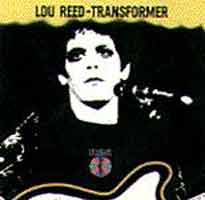 Nachdem Velvet Underground zwar Kultstatus erlangten, aber keine Platten
verkauften und sein erstes Soloalbum im Jahr zuvor nicht weiter auffiel,
wurde Lou Reed mit dieser von David Bowie und Mick Ronson
produzierten Platte zum Star. Lag natürlich auch am Erfolg der genialen
Single "Walk On The Wild Side" mit dem tollen gedoppelten Bass
von Herbie Flowers.
Nachdem Velvet Underground zwar Kultstatus erlangten, aber keine Platten
verkauften und sein erstes Soloalbum im Jahr zuvor nicht weiter auffiel,
wurde Lou Reed mit dieser von David Bowie und Mick Ronson
produzierten Platte zum Star. Lag natürlich auch am Erfolg der genialen
Single "Walk On The Wild Side" mit dem tollen gedoppelten Bass
von Herbie Flowers. |
| Santana: "Caravanserai" (Columbia, Nov. 1972) |
 Meine Lieblingsplatte von Carlos & Co.! Hier lösten sie sich
etwas vom bisherigen, sehr erfolgreichen Latinrock-Sound und bauten Jazzelemente
ein. Leider gab's auf der Platte keine Hits mehr wie "Black Magic
Woman", sodass das ganze Album natürlich nicht mehr so erfolgreich
wie "Abraxas" werden konnte.
Meine Lieblingsplatte von Carlos & Co.! Hier lösten sie sich
etwas vom bisherigen, sehr erfolgreichen Latinrock-Sound und bauten Jazzelemente
ein. Leider gab's auf der Platte keine Hits mehr wie "Black Magic
Woman", sodass das ganze Album natürlich nicht mehr so erfolgreich
wie "Abraxas" werden konnte.

 Mehr ...
Mehr ...
»Caravanserai« ist das vierte Album von Santana, das ursprünglich 1972 erschien. Es stellte einen wichtigen Wendepunkt in der Karriere von Carlos Santana dar, weil es sich von den ersten drei Alben deutlich entfernte.
»Caravanserai« erreicht Platz 8 der Billboard 200 und Platz 6 in den R&B Charts. Der Sound gestaltete sich anders als die charakteristische Santana-Mischung aus Salsa, Rock und Jazz und drehte sich hauptsächlich um Jazz-artige Instrumentalpassagen. Bis auf drei Songs sind alle Tracks Instrumentals, so dass das Album keine Single hervorbrachte.
»Caravanserai« ist das erste in einer Serie von Santana-Alben, die für ihre sich stetig verstärkende musikalische Komplexität bekannt wurden und sich vom eingängigen Rockformat der ersten Alben verabschiedeten. Dies ist das letzte Album mit Gregg Rolie und Neal Schon, die im darauffolgenden Jahr Journey gründen sollten.
Thank God there are no 'extra takes', 'bonus tracks' and Bill Laswell remasters. This is Santana's neo-masterpiece, a record that begins at the beginning, rocks through the middle and exits in Mike Shrieve's magnificent 'Every Step of the Way' with Douglas Rauch on bass guitar. Driving the caravan ever onward is James Mingo Lewis on bongos and Jose Chepito Areas on timbales - but check out Mr Santana himslef on 'Song of the Wind'. Beautiful, ethereal stuff. Forget the later Santana-featuring-everyone-you-can-think-of-and-scoop-Grammies, this is the real McJobim.
|
| Steely Dan: "Can't Buy A Thrill" (ABC, Nov. 1972) |
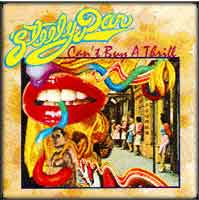 Der
erste Geniestreich von Becker/Fagan, damals noch als echte Band. Enthält
mit "Do It Again" und "Reeling In The Years" bereits
zwei Superhits. Der
erste Geniestreich von Becker/Fagan, damals noch als echte Band. Enthält
mit "Do It Again" und "Reeling In The Years" bereits
zwei Superhits. |
| Ton Steine Scherben: "Keine Macht Für Niemand" (David Volksmund, Nov. 1972) |
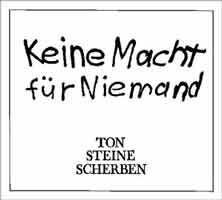 |
| Wallenstein: "Mother Universe" (BASF/Pilz, Nov. 1972) |
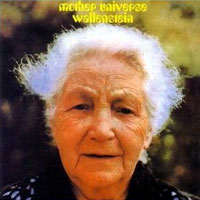 Zweites, bestes und letztes Album der Band aus Mönchengladbach (somit
beste Band vom Niederrhein!) mit Jerry
Berkers als Sänger und Bassist. Beim ersten Versuch "Blitzkrieg"
vom Beginn des Jahres war es mir noch zu unausgegoren, danach zu bombastisch.
Außerdem ein wunderschönes Cover - das war die Oma von Keyboarder
Jürgen Dollase.
Zweites, bestes und letztes Album der Band aus Mönchengladbach (somit
beste Band vom Niederrhein!) mit Jerry
Berkers als Sänger und Bassist. Beim ersten Versuch "Blitzkrieg"
vom Beginn des Jahres war es mir noch zu unausgegoren, danach zu bombastisch.
Außerdem ein wunderschönes Cover - das war die Oma von Keyboarder
Jürgen Dollase.
(29.06.2008) |
| War: "The World Is A Ghetto" (United Artists, Nov. 1972) |
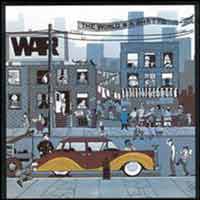 Dies
war bereits das dritte Album der ehemaligen Eric-Burdon-Begleitband unter
eigener Verantwortung und ihr großer Durchbruch. Ein Meilenstein
des Funks! Dies
war bereits das dritte Album der ehemaligen Eric-Burdon-Begleitband unter
eigener Verantwortung und ihr großer Durchbruch. Ein Meilenstein
des Funks!

 Mehr ...
Mehr ...
|
War's third album as an act separate from Eric Burdon was also far and
away their most popular, the group's only long-player to top the pop charts.
The culmination of everything they'd been shooting for creatively on their
two prior albums, it featured work in both succinct pop-accessible idioms
("The Cisco Kid," etc.) as well as challenging extended pieces
such as the 13-minute "City, Country, City" — which offered
featured spots to all seven members without ever seeming disjointed —
and the title track, and encompass not only soul and funk but elements
of blues and psychedelia on works such as the exquisite "Four Cornered
Room." "The Cisco Kid" and "The World Is a Ghetto"
understandably dominated the album's exposure, but there's much more to
enjoy here, even decades on. Beyond the quality of the musicianship, the
classy, forward-looking production has held up remarkably well, and not
just on the most famous cuts here; indeed, The World Is a Ghetto is of
a piece with Marvin Gaye's What's Going On and Curtis Mayfield's Curtis,
utilizing the most sophisticated studio techniques of the era. Not only
does it sound great, but there are important touches such as the phasing
in "Four Cornered Room," not only on the percussion but also
on the vocals, guitars, and other instruments, and the overall effect
is a seemingly contradictory (yet eminently workable) shimmering blues,
even working in a mournful and unadorned harmonica amid the more complex
sounds.
(by Bruce Eder, All
Music Guide)
|
|
| Stevie Wonder: "Talking Book" (Motown, Nov. 1972) |
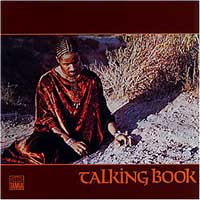 Ich bin definitiv kein Soul-Kenner. Und "You Are The Sunshine Of
My Life" habe ich wie jeder normale Mensch wahrscheinlich schon viel
zu oft im Radio gehört. Aber "Superstition" ist nun mal
einer der besten Rocksongs überhaupt!
Ich bin definitiv kein Soul-Kenner. Und "You Are The Sunshine Of
My Life" habe ich wie jeder normale Mensch wahrscheinlich schon viel
zu oft im Radio gehört. Aber "Superstition" ist nun mal
einer der besten Rocksongs überhaupt!

 Mehr ...
Mehr ...
Die zwei US-Nummer-Eins-Hits von diesem 1972er Album veranschaulichen perfekt die gegensätzlichen Seiten von Wonders komplexer Persönlichkeit. "Superstition" ist ein starker Rocksong, ein paranoides Stückchen Wah-Wah-Gitarren-Funk, das es in puncto Dauerhaftigkeit mit dem besten Punk aufnehmen kann; der Eröffnungstrack, "You Are the Sunshine of My Life", ist ein reines Liebeslied, das von jeder anderen Stimme gesungen kitschig klänge. Ein Hauch von Bitterkeit, vielleicht aufgrund von Wonders sich damals gerade auflösender Ehe, verleiht Talking Book ein paar Ecken und Kanten. Aber alles in allem ist die Liebe das große Thema, und obwohl "Sunshine" noch immer einer der beliebtesten Songs des Sängers und Keyboarders ist, ist das letzte Stück, "I Believe (When I Fall in Love It Will Be Forever)", viel tiefgründiger und lohnender.
(Steve Knoppe, amazon.de)
|
| Gene Clark: "Roadmaster" (A&M, Dez. 1972) |
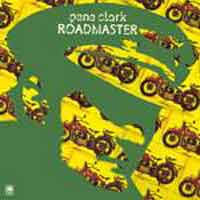 Ein Skandal! Ex-Byrd Gene Clark
nimmt diese wunderbare Platte mit tollen Songs ("Misty Morning"!)
und toller Band (Steeler Sneaky Pete von den Flying
Burritos Brothers, Ex-Byrd Gitarrenhexer
Clarence White, Ex-Byrd-Trommler
und jetzt-Burrito Brother Michael Clarke, Orgelspieler Spooner
Oldham und Geigenvirtuose Byron Berline) auf, packt 2 Lieder
aus einer Session mit allen Orifginalbyrds von 1970 dabei (außer Michael
Clarke und Chris Hillman natürlich noch Roger McGuinn und
David Crosby plus Jazzflötist Bud Shank) und auch einen
Versuch mit den kompletten Burritos Brothers - und A&M bringt
die Platte nur in Holland raus, dem einzigen Land, wo der Vorgänger
"White Light" so einigermaßen
erfolgreich war!
Ein Skandal! Ex-Byrd Gene Clark
nimmt diese wunderbare Platte mit tollen Songs ("Misty Morning"!)
und toller Band (Steeler Sneaky Pete von den Flying
Burritos Brothers, Ex-Byrd Gitarrenhexer
Clarence White, Ex-Byrd-Trommler
und jetzt-Burrito Brother Michael Clarke, Orgelspieler Spooner
Oldham und Geigenvirtuose Byron Berline) auf, packt 2 Lieder
aus einer Session mit allen Orifginalbyrds von 1970 dabei (außer Michael
Clarke und Chris Hillman natürlich noch Roger McGuinn und
David Crosby plus Jazzflötist Bud Shank) und auch einen
Versuch mit den kompletten Burritos Brothers - und A&M bringt
die Platte nur in Holland raus, dem einzigen Land, wo der Vorgänger
"White Light" so einigermaßen
erfolgreich war!

 Mehr ...
Mehr ...
|
Gene Clark, record business equals bad news. Case in point, this album.
Or masterpiece, you could say. After two brilliant Dillard & Clark
albums, A&M signed Clark to a solo deal. Okay, fair enough -- so far.
In 1972, he delivered perhaps the finest album of his career, Gene Clark,
(also known as White Light). Excellent reviews in all the top magazines,
including Rolling Stone. Guess what? Almost zero sales. Now, here's the
follow up, almost -- if not more -- brilliant. Released only in Holland.
Aside from containing some of Clark's finest tracks like "In a Misty
Morning" and "Full Circle Song," this record contains two
gems recorded with the willing participation of the other original Byrds.
"One in a Hundred" and "She's the Kind of Girl" are
so good that they would have easily stood out on The Byrds box set, had
McGuinn elected to include them. Oh well, the music is still here -- an
example of an artist who couldn't quite get in on with commerce. What
a disaster. The man should be mentioned in the same breath as Neil Young.
Roadmaster is one of the many reasons why.
(by Matthew Greenwald, AMG)
|
|
| J. Geils Band: "Live/Full House" (Atlantic, Dez. 1972) |
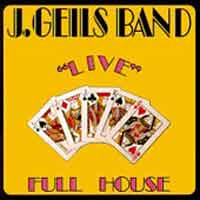 Ein richtig geiler Konzertmitschnitt einer der schärfsten R&B-Truppen
der 70er. Mit einem tollen Sänger (Peter Wolf, der bessere
Mick Jagger) und einem wahnsinnigen Harpspieler (Magic Dick). Die
Instrumentalarbeit ist Teamwork in Perfektion: der zurückhaltende
Namensgeber J. Geils an der Gitarre, Keyboarder Seth Justman
und die Rhythmusgruppe Danny Klein (bg) und Stephen Bladd
(dr). Direkt die ersten beiden Nummern hauen einen um "First I Look
At The Purse" (Smokey Robinson) und "Homework" von Otis
Rush. Die letzte Nummer hat Peter Wolf auf seinem fantastischen neuen
Soloalbum "Sleepless" (2002) noch mal in einer etwas gemächlicheren
Variante aufgenommen.
Ein richtig geiler Konzertmitschnitt einer der schärfsten R&B-Truppen
der 70er. Mit einem tollen Sänger (Peter Wolf, der bessere
Mick Jagger) und einem wahnsinnigen Harpspieler (Magic Dick). Die
Instrumentalarbeit ist Teamwork in Perfektion: der zurückhaltende
Namensgeber J. Geils an der Gitarre, Keyboarder Seth Justman
und die Rhythmusgruppe Danny Klein (bg) und Stephen Bladd
(dr). Direkt die ersten beiden Nummern hauen einen um "First I Look
At The Purse" (Smokey Robinson) und "Homework" von Otis
Rush. Die letzte Nummer hat Peter Wolf auf seinem fantastischen neuen
Soloalbum "Sleepless" (2002) noch mal in einer etwas gemächlicheren
Variante aufgenommen.

 Mehr ...
Mehr ...
"Founded in 1967 in Boston, the J. Geils Band made
a reputation of itself as an over-the-top bar band, specialists in esoteric
Soul and R&B songs. Raunchy by way of Wolf, Bluesy by way of Magic
Dick, Jazzy by way of keyboardist Seth Justman, and all Rock & Roll
by way of J. Geils, the J. Geils Band forged a white bridge between Detroit
Soul, Memphis R&B, and American pop culture. The band made albums
in the early 1970s that fed the appetite of AOR FM stations and Late Night
AM stations. It was not until the late 70s and early 80s that the band
finally reached a wider audience and produced a string of Top Ten hits…and
in the bargain lost their original grit. "I Must of Got Lost",
"Give it to Me", and "Centerfold" were all solid pop
confections, but they were no match for what the Band produced ten years
earlier on "Live" Full House.
Minute for Minute, "Live" Full House is one of
the densest rock live albums ever produced. Clocking in at just under
40 minutes, it packs a relentless punch that leaves the listener drunk
with pleasure and wanting more. The disc opens with the relatively obscure
Smokey Robinson tune, "First I Look at the Purse", which is
totally transformed into a slab-o-rock lava flow and proceeds through
Otis Rush's "Homework" (easy blues) and the originals "Wammer
Jammer", "Hard Drivin' Man" (Rock and Roll), and "Crusin'
for Love". Most songs are of 45 rpm length with the notable exception
of John Lee Hooker's staggering nine plus minutes of "It Serves You
Right to Suffer", a funeral dirge turned nasty"
|
|
| America: "Homecoming" (Warner, 1972) |
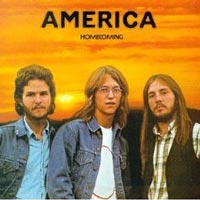

 Mehr ...
Mehr ...
Just als America 1973 einen Grammy als »Best New Artist« gewannen, veröffentlichten sie ihr zweites Album »Homecoming«, das entsprechend von Kritikern und Fans gefeiert wurde. Die Single »Ventura Highway« fungierte als Teaser zum Album und knackte die Top 10. Das Album folgte auf kurz darauf und stürmte seinerseits die Billboard Top 10.
Die Band polierte ihren Sound weiter auf und baute ihre patentierte Folk-Pop Formel weiter aus, die sie für ihr self-titled Debüt des Vorjahres angewendet hatte. Dewey Bunnell, Dan Peek und Gerry Beckley lieferten fesselnde Songs von höchster Qualität, die von vielen als ihre beste Arbeit eingeschätzt werden.
|
| Eric Andersen: "Blue River" (Columbia, 1972) |
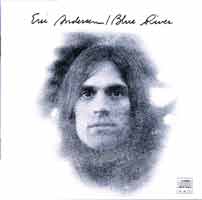 In Nashville unter der Regie von Norbert Putnam mit einer Allstarriege aufgenommen
(u.a. Joni Mitchell, David Briggs, Eddie Hinton,
David Bromberg). Eines der besten Alben von Anderson und trotzdem
nicht sehr bekannt geworden.
In Nashville unter der Regie von Norbert Putnam mit einer Allstarriege aufgenommen
(u.a. Joni Mitchell, David Briggs, Eddie Hinton,
David Bromberg). Eines der besten Alben von Anderson und trotzdem
nicht sehr bekannt geworden. |
| "Lô Borges " (EMI, 1972) |
|
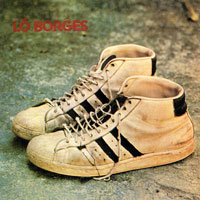 1972 war Lô Bastos im zarten Alter von 20 Jahren zusammen mit
seinem Jugendfreund Milton Nascimento im "Clube
Da Esquina". Kurz danach nahm er auch sein titelloses Debütalbum
auf, wo man deutlich erkennen kann, dass er für den Stil dieses
Meisterwerks mindestens genauso wichtig war wie sein viel bekannterer
Kumpel Milton.
1972 war Lô Bastos im zarten Alter von 20 Jahren zusammen mit
seinem Jugendfreund Milton Nascimento im "Clube
Da Esquina". Kurz danach nahm er auch sein titelloses Debütalbum
auf, wo man deutlich erkennen kann, dass er für den Stil dieses
Meisterwerks mindestens genauso wichtig war wie sein viel bekannterer
Kumpel Milton.
(01.04.2012)
Ein überragend gutes Album, obwohl ich kein Wort von dem verstehe,
was da gesungen wird! Obwohl es mit immerhin 15 Liedern nur eine knappe
halbe Stunde lang ist, würde ich die Platte in die Reihe der grandiosen
Singer/Songwriter Alben des Jahres 1972 mit Beatles, Jazz und Folkelementen,
wie zum Beispiel "Big Star #1", einordnen.
(13.04.2012)

 Mehr ...
Mehr ...
Reminiscent of the Clube da Esquina album he made the same year with Brazilian superstar Milton Nascimento, Lô Borges' 1972 solo debut proves that his influence on Nascimento was quite strong. The recording is texturally lush and dreamy, at times urgent and bizarre, and filled with the fantastic and intricate guitar playing one would expect of Borges after hearing his dazzling work with Nascimento. His vocal arrangements are lavish, often similar to the vocal qualities of George Harrison's All Things Must Pass, and his instrumental arrangements are just plain confounding. Piano phrases mash in and out of control over the unorthodox yet clever progressions; polyphonic percussion interlocks with jazzed-out organ lines and thoughtful, melodic bass work. Occasionally, a string section will fall into place, fulfilling the album's decorative quota, and the whole construction becomes watertight. It is truly stunning to pick apart the timbre of individual instruments and realize how necessary and meticulous each part is in the overall presentation. Borges is one of those arrangers who can build up a music bed with miles of depth and construct a wall of sound, yet keep the overall concept in crisp focus. No layer of the instrumentation seems to ever become obscured by another, nor does any part seem unnecessary, and so much is going on rhythmically and melodically that it demands full attention. The remarkable quality of Brazil's musical culture to seamlessly integrate as many outside influences into one place is well represented here. Many western textures, such as soul, rock, jazz, and pop, are absorbed into the picture with fervor and grace rarely executed in the world of western music. "Não Foi Nada" illustrates this particularly well, but the melting-pot sentiment echoes through all of Borges' performances here.
(by Gregory McIntosh, All Music Guide)
Originally released in 1972, Lo Borges' solo debut is a stunning piece of post-bossa nova Brazilian pop music. Combining influences ranging from soul, jazz, pop, psychedelic, and bossa nova with brilliant musicianship and wild arrangements, Lo Borges is one of the finest Brazilian records of the 1970s, if not ever. Borges emerged out of the Clube de Esquina musical collective, from the state of Minas Gerais, along with Milton Nascimento, a movement that rivaled the brilliance of the more well known Tropicalismo. Absolutely brilliant and available on CD in the USA for the first time ever.
|
| Dr. Hook & The Medicine Show: "Sloppy Seconds" (Columbia, 1972) |
 Eine
meiner ersten LPs, Ende '73 gekauft und lange Zeit aus meinem Gedächtnis
verschwunden. Im Film "Almost Famous" taucht in einer Szene
"The Cover Of The Rolling Stone" auf. Daraufhin habe ich die
Platte noch mal aufgelegt und stelle fest: tolle Songs von Shel
Silverstein mit abgefahrenen Texten, ein klasse Sänger (der mit
der Akustikgitarre, nicht der mit der Augenklappe!) und eine tolle Band,
irgendwo zwischen Rock und Country. Das muss die Rednecks ähnlich
wie bei Commander Cody sehr aufgeregt
haben, dass ihnen Hippies ihre Musik klauen! Eine
meiner ersten LPs, Ende '73 gekauft und lange Zeit aus meinem Gedächtnis
verschwunden. Im Film "Almost Famous" taucht in einer Szene
"The Cover Of The Rolling Stone" auf. Daraufhin habe ich die
Platte noch mal aufgelegt und stelle fest: tolle Songs von Shel
Silverstein mit abgefahrenen Texten, ein klasse Sänger (der mit
der Akustikgitarre, nicht der mit der Augenklappe!) und eine tolle Band,
irgendwo zwischen Rock und Country. Das muss die Rednecks ähnlich
wie bei Commander Cody sehr aufgeregt
haben, dass ihnen Hippies ihre Musik klauen! |
| Ellis: "Riding On The Crest Of A Slump"(Epic, 1972) |
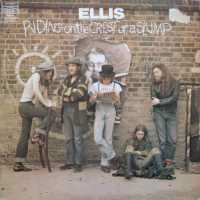 Lost And Found!
Lost And Found!
(06.04.2010) |
| Embryo: "Father Son And Holy Ghost" (United Artists/Liberty, 1972) |
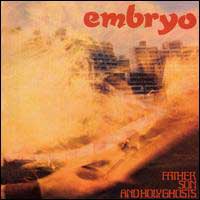 Ein
Frühwerk von Deutschlads besten Ethno-Jazz-Rock-Hippies. Aufgenommen
im März 1972 nach den Sessions für "Steig
Aus" (aber noch vor jenen veröffentlicht!) in der
Besetzung Christian Buchard (Schlagzeug & Vibraphon), Edgar
Hoffmann (Geige & Saxofon), Dave King (Bass & Flöte)
und Sigi Schwab (Gitarre & indische Saiteninstrumente). Ein
Frühwerk von Deutschlads besten Ethno-Jazz-Rock-Hippies. Aufgenommen
im März 1972 nach den Sessions für "Steig
Aus" (aber noch vor jenen veröffentlicht!) in der
Besetzung Christian Buchard (Schlagzeug & Vibraphon), Edgar
Hoffmann (Geige & Saxofon), Dave King (Bass & Flöte)
und Sigi Schwab (Gitarre & indische Saiteninstrumente). |
| "Barbara Keith" (Reprise, 1972 ) |
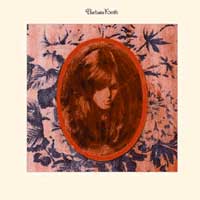 Lost And Found!
Lost And Found!
(01.05.2004) |
| Freddie King: "Texas Cannonball" (Shelter, 1972) |
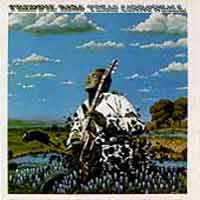 Für mich ganz klar eines der besten Alben von Freddie. Sehr rockig produziert
von Leon Russell. Mit einer tollen Version des CCR-Songs "Lodi".
Für mich ganz klar eines der besten Alben von Freddie. Sehr rockig produziert
von Leon Russell. Mit einer tollen Version des CCR-Songs "Lodi".

 Mehr ...
Mehr ...
Ein wahres Meisterwerk, voll von schneidigen Soli und mit einigen von Freddie Kings besten Gesangsleistungen seit seiner Blütezeit in den späten 50er und frühen 60er Jahren. Texas Cannonball wurde 1972 von Shelter Records veröffentlicht und ähnelt seinem ersten Shelter-Album (Getting Ready), hat aber einen stärkeren Rock-Einschlag. Es enthält Stücke von Jimmy Rogers, Howlin' Wolf und Elmore James, Kompositionen von Leon Russell und, noch unerwarteter, von Bill Withers, Isaac Hayes-David Porter und John Fogerty (dessen "Lodi" zu "Lowdown in Lodi" umgearbeitet wird). Kings eigene Feder blieb praktisch im Ruhestand, da er nur einen einzigen Titel des Albums schrieb.
2007 zählte die Houston Chronicle Texas Cannonball zu den 75 wichtigsten Blues-Alben aus Texas.
Similar to his first Shelter outing (Getting Ready), but with more of a rock feel. That's due as much to the material as the production. Besides covering tunes by Jimmy Rogers, Howlin' Wolf, and Elmore James, King tackles compositions by Leon Russell and, more unexpectedly, Bill Withers, Isaac Hayes-David Porter, and John Fogerty (whose "Lodi" is reworked into "Lowdown in Lodi"). King's own pen remained virtually in retirement, as he wrote only one of the album's tracks. Reissued in its entirety on King of the Blues.
(by Richie Unterberger, All Music Guide)
|
| Jackie Lomax: "Three" (Warner, 1972) |
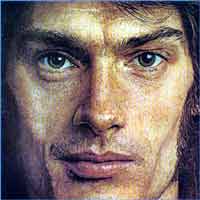 Drittes Album mit nicht sonderlich originellem Titel des englischen Sängers,
dieses mal aufgenommen in den Bearsville Studios, Woodstock, mit Musikern
aus dem weiteren Umfeld von The Band,
produziert hat John Simon, der auch bei den wichtigen Platten von
The Band dabei war. Bei einem Song liefern dann auch Levon Helm
und Rick Danko den Rhythmus.
Drittes Album mit nicht sonderlich originellem Titel des englischen Sängers,
dieses mal aufgenommen in den Bearsville Studios, Woodstock, mit Musikern
aus dem weiteren Umfeld von The Band,
produziert hat John Simon, der auch bei den wichtigen Platten von
The Band dabei war. Bei einem Song liefern dann auch Levon Helm
und Rick Danko den Rhythmus.
Den großen Durchbruch hat Jackie Lomax leider nie geschafft. Manche kennen
seinen Namen auch nur, weil sein Debüt von 1969 die erste Veröffentlichung
des Beatles-Labels Apple war. Mitte/Ende der 70er gab's dann noch
mal eine Zusammenarbeit mit Little Feat, die ich zwar nicht kenne
(Jackies Platten sind halt schlecht zu kriegen!), die ich mir aber gut
vorstellen kann. Lomax und Lowell passten sicherlich gut zusammen. Auf
"Three" bedient übrigenz ein anderer (heimlicher) Held
von mir die Slidegitarre: Bryn Haworth. |
| Mahavishnu Orchestra: "Birds Of Fire" (Columbia, 1972) |
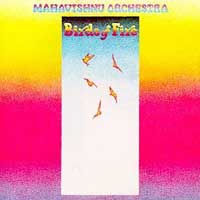 Dies ist bereits das zweite Streich von Gitarrist John
McLaughlin, zusammen mit Jan Hammer an den Keyboards, Geiger
Jerry Goodman, Trommler Billy Cobham und Bassist Rick
Laird. Und gäbe es den Vorgänger nicht, so müsste man
die Platte als unvergleichlich bezeichnen. Oder ist es eher eine Meisterleistung,
dass die Höchstleistung von "The
Inner Mounting Flame" keine Eintagsfliege war?
Dies ist bereits das zweite Streich von Gitarrist John
McLaughlin, zusammen mit Jan Hammer an den Keyboards, Geiger
Jerry Goodman, Trommler Billy Cobham und Bassist Rick
Laird. Und gäbe es den Vorgänger nicht, so müsste man
die Platte als unvergleichlich bezeichnen. Oder ist es eher eine Meisterleistung,
dass die Höchstleistung von "The
Inner Mounting Flame" keine Eintagsfliege war?
Insofern muss ich meinen bisherigen Gedankengang ("zwei tolle Platten
hintereinander - da erwähne ich wohl besser das Debüt")
etwas revidieren. Dank an Peter aus Wuppertal für den Denkanstoss.
Aber keine Asche auf mein Haupt!
(Okt. 2006)

 Mehr ...
Mehr ...
| Hätte es nicht schon das erste Mahavishnu-Album The
Inner Mounting Flame gegeben, dann wäre wohl das 1973 erschienene Birds
Of Fire die herausragendste Jazz-Fusion-Platte aller Zeiten geworden. Beide
Platten sind stark geprägt von Sinnsuche und Erlösungsthematik.
Alles hier ist durchdacht und verströmt Sicherheit.
Die phantastischen Leistungen von Keyboarder Jan Hammer, dem Geiger Jerry
Goodman, dem Bassisten Rick Laird und dem Wahnsinns-Drummer Billy Cobham
werden nur noch übertroffen von der Übergitarre des Bandleaders
John McLaughlin. Hier bekommt man die ganze Palette seiner musikalischen
Einflüsse zu hören: Tal Farlow, Django Reinharts rasend-schnelle
Gitarrenläufe, Flamenco, Delta-Blues, schwerste verzerrte Metal-Gitarren,
Anleihen aus der indischen Musik und aus dem Folk. Alles ist hier versammelt
und vermischt sich zu einem edlen, kosmischen Gebräu.
(Peter Monaghan, Amazon.de-Redaktion)
|
|
|
Emboldened by the popularity of Inner Mounting Flame among rock audiences,
the first Mahavishnu Orchestra set out to further define and refine its
blistering jazz-rock direction in its second -- and, no thanks to internal
feuding, last -- studio album. Although it has much of the screaming rock
energy and sometimes exaggerated competitive frenzy of its predecessor,
Birds of Fire is audibly more varied in texture, even more tightly organized,
and thankfully more musical in content. A remarkable example of precisely
choreographed, high-speed solo trading -- with John McLaughlin, Jerry
Goodman, and Jan Hammer all of one mind, supported by Billy Cobham's machine-gun
drumming and Rick Laird's dancing bass -- can be heard on the aptly named
"One Word," and the title track is a defining moment of the
group's nearly atonal fury. The band also takes time out for a brief bit
of spaced-out electronic burbling and static called "Sapphire Bullets
of Pure Love." Yet the most enticing pieces of music on the record
are the gorgeous, almost pastoral opening and closing sections to "Open
Country Joy," a relaxed, jocular bit of communal jamming that they
ought to have pursued further. This album actually became a major crossover
hit, rising to number 15 on the pop album charts, and it remains the key
item in the first Mahavishnu Orchestra's slim discography.
(by Richard S. Ginell, All
Music Guide)
|
|
| Les McCann: "Invitation To Openness" (Atlantic, 1972) |
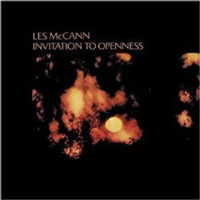 Les McCann ist ein Jazz-Keyboarder und -sänger, von dem ich nicht besonders
viel kenne, eigentlich nur das wenig später entstandene Album "Layers",
auf dem er vor allem mit den damals brandneuen Synthesizern arbeitete.
"Invitation ..." besteht aus gerade einmal drei Songs von 12
bis 26 Minuten Länge, bei denen das Rhodes-E-Piano im Mittelpunkt steht.
Dazu kommt als Bläser der eigenwillige Jusef
Lateef - schon war ich neugierig, als ich das Album kürzlich in der
Plattensammlung eines Freundes entdeckte!
Les McCann ist ein Jazz-Keyboarder und -sänger, von dem ich nicht besonders
viel kenne, eigentlich nur das wenig später entstandene Album "Layers",
auf dem er vor allem mit den damals brandneuen Synthesizern arbeitete.
"Invitation ..." besteht aus gerade einmal drei Songs von 12
bis 26 Minuten Länge, bei denen das Rhodes-E-Piano im Mittelpunkt steht.
Dazu kommt als Bläser der eigenwillige Jusef
Lateef - schon war ich neugierig, als ich das Album kürzlich in der
Plattensammlung eines Freundes entdeckte!
(19.05.2009) |
| Sergio Mendes & Brasil 66: "Foursider" (A&M, 1972) |
 Klassiker aus der Hochphase der Popmusik! Foursider ist ein Greatest-Hits-Doppelalbum
mit Aufnahmen aus den späten 60ern, das heute noch eindrucksvoll
demonstriert, wie zeitlos diese Mischung aus Bossa Nova, Quasi-Jazz und
Easy Listening-Pop ist, mit welcher der brasilianische Pianist Sergio
Mendes damals weltweit Erfolg hatte. Dieses Konzept erlaubte ihm,
Pop-Originale von Joni Mitchell ("Chelsea Morning"),
den Beatles ("A Little Help From My Friends", "Fool
On The Hill" und "Norwegian Wood"), Burt Bacharach
("Look Of Love"), Buffalo Springfield ("For What
It's Worth"), Otis Redding ("The Dock Of The Bay")
und J.J. Cale ("After Midnight") ohne Brüche neben
brasilianisches Material von Jorge Ben ("Mas Que Nada"),
Joao Gilberto und Tom Jobim ("Samba De Uma Nota So",
"Vou Te Contar") zu stellen.
Klassiker aus der Hochphase der Popmusik! Foursider ist ein Greatest-Hits-Doppelalbum
mit Aufnahmen aus den späten 60ern, das heute noch eindrucksvoll
demonstriert, wie zeitlos diese Mischung aus Bossa Nova, Quasi-Jazz und
Easy Listening-Pop ist, mit welcher der brasilianische Pianist Sergio
Mendes damals weltweit Erfolg hatte. Dieses Konzept erlaubte ihm,
Pop-Originale von Joni Mitchell ("Chelsea Morning"),
den Beatles ("A Little Help From My Friends", "Fool
On The Hill" und "Norwegian Wood"), Burt Bacharach
("Look Of Love"), Buffalo Springfield ("For What
It's Worth"), Otis Redding ("The Dock Of The Bay")
und J.J. Cale ("After Midnight") ohne Brüche neben
brasilianisches Material von Jorge Ben ("Mas Que Nada"),
Joao Gilberto und Tom Jobim ("Samba De Uma Nota So",
"Vou Te Contar") zu stellen. |
| Milton Nascimento & Lô Borges: "Clube Da Esquina" (EMI, 1972) |
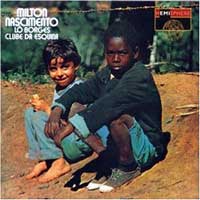 Ende der 60er Jahre, autoritäres Militärregime, Belo Horizonte,
Hauptstadt des Bundesstaates Minas Gerais, eine Gruppe junger Freunde,
die sich für die Jugendrevolte in der westlichen Welt begeistern.
Ihr Chef: ein dünner Schwarzer, der mehrere Instrumente perfekt beherrscht
und eine auffällige Stimme besitzt: Bituca, später berühmt
als Milton Nascimento. Mit ihm sind der Keyboarder Wagner Tiso,
die Poeten Fernando Brant und Ronaldo Bastos, der Gitarrist
Toninho Horta, der Bassist Beto Guedes, die Brüder
Marcio und Lô Borges und andere Komponisten
und Musiker. Jazz und Rock vermischen sich mit Bossa Nova und anderen
brasilianischen Stilen. Der Club wird in ganz Brasilien berühmt,
seine Platten mit dem Label 'Clube da Esquina' verkaufen sich überall
und prägen eine Generation.
Ende der 60er Jahre, autoritäres Militärregime, Belo Horizonte,
Hauptstadt des Bundesstaates Minas Gerais, eine Gruppe junger Freunde,
die sich für die Jugendrevolte in der westlichen Welt begeistern.
Ihr Chef: ein dünner Schwarzer, der mehrere Instrumente perfekt beherrscht
und eine auffällige Stimme besitzt: Bituca, später berühmt
als Milton Nascimento. Mit ihm sind der Keyboarder Wagner Tiso,
die Poeten Fernando Brant und Ronaldo Bastos, der Gitarrist
Toninho Horta, der Bassist Beto Guedes, die Brüder
Marcio und Lô Borges und andere Komponisten
und Musiker. Jazz und Rock vermischen sich mit Bossa Nova und anderen
brasilianischen Stilen. Der Club wird in ganz Brasilien berühmt,
seine Platten mit dem Label 'Clube da Esquina' verkaufen sich überall
und prägen eine Generation.
Das Album ist ein Klassiker der brasilianischen Popmusik und ein guter
Einstieg für jeden, der bisher keinen Zugang zu dieser Musik hatte.
Ich hatte gerade frisch ein Buch über brasilianische Musik verschlungen
("The Brazilian Sound" von Chris McGowan ud Ricardo Pessanha,
Hannibal 1991) als ich dieses Doppelalbum auf einer CD wiederveröffentlicht
für schlappe DM 13,95 bei Zweitausendeins entdeckte und natürlich
sofort zuschlug. Es handelt sich tatsächlich um eine gelungene Verbindung
von Brasilien und Europa (Beatles vor allem). Ich kannte sogar ein Lied:
"Cravo E Canela", ich weiß leider nicht mehr woher!

 Mehr ...
Mehr ...
| "Unsere Musik drückte unsere Revolte aus, aber
auch unsere Liebe und die Lust an der Schönheit. Wir verbreiteten eine
demokratische Kultur und waren gegen Hass und Gewalt. Wir suchten die Harmonie
und die Öffnung zur Welt, die wir als unser Heimat betrachteten. 1972
erschien unsere erste LP, ein gewaltiger Erfolg". (Fernando Brant)
|
|
"Flamencogitarren und Keltenklänge, Sambarhythmen
und Salsagrooves, orientalische Arabesken und "Ethno-Punk" --
das eklektische Label Hemisphere präsentiert nicht die Musik der westlichen,
sondern der restlichen Welt. Etwa den letzten Konzertmitschnitt von Argentiniens
Tango-Virtuosen Astor Piazzolla oder die Neuauflage der beiden Clube Da
Esquina-Alben von Milton Nascimento ein Vierteljahrhundert nach ihrer Erstveröffentlichung.
Nascimento, 1942 in Rio geboren und als schwarzes Adoptivkind bei einer
weißen Familie in der Provinz Minas Gerais aufgewachsen, gehört
zu den bekanntesten Sängern Südamerikas. Nicht nur seine engelsgleiche
Stimme trägt den Hörer in andere Sphären, auch sein Kompositionstalent
weckte weltweit Bewunderung. Selten hat sich ein schwarzer Musiker stilistisch
den europäischen Bands so weit angenähert wie er. Dabei schuf
Milton seinen eigenen Stil: Eine geniale Mixtur aus Bossa Nova und Brit-Pop,
Klassik und Jazz, Folklore und Chanson. Seine Songwriterqualitäten
entfalten sich unübertroffen in seinem faszinierendsten Projekt: Das
erste Album mit dem Clube Da Esquina, dem "Club von der (Straßen-)Ecke"
erschien 1972, eine Neuauflage dieses Bandprojekts mit Freunden und Gleichgesinnten
unter dem Titel Club Da Esquina 2 folgte 1978. Beide Doppelalben gehören
heute zu den Klassikern der brasilianischen Popmusik. Experimentell, avantgardistisch
(auch für heutige Verhältnisse) und symphonisch präsentiert
dieses Meisterwerk trotz des deutlichen Einflusses europäischer Vorbilder
wie Pink Floyd oder Beatles Musik, wie sie nur von einem Lateinamerikaner
gemacht werden kann. Mehrheitlich melancholische Titel wie "O Trem
Azul" oder "San Vicente" konterkarieren die ausgelassene
Fröhlichkeit des südamerikanischen Karnevals. Die Neuauflage des
Clube Da Esquina stellt auch Klangfetischisten zufrieden. Die Mastertapes
wurden 1995 in den Londoner Abbey Road Studios neu abgemischt." (Wolfgang
Zwack, Amazon) |
|
|
This is the CD reissue of a classic double LP recorded in 1972 by Milton
Nascimento and Lô Borges. The album had orchestrations of Eumir
Deodato and Wagner Tiso under the conduction of the renowned clarinetist/composer/orchestrator
Paulo Moura. The title Clube da Esquina is related to the gang of mineiros
(people from the Minas Gerais state) that populate this release, either
singing compositions or vocal/instrumental performances, like Nascimento
and Borges themselves: Wagner Tiso, Beto Guedes, Milton Guedes, Tavito,
Toninho Horta, Márcio Borges, Ronaldo Bastos, and Fernando Brant,
among others. The album covers a great number of Clube da Esquina hits,
like "Tudo Que Você Podia Ser," "Cais," "O
Trem Azul," "Caravo E Canela," "Um Girassol da Cor
do Seu Cabelo," "San Vicente," "Clube da Esquina No.
2," and so many others, with the competent backing of some of the
best musicians in Brazil, including bassist Luiz Alves and percussionist
Robertinho Silva. A must-have. (by Alvaro Neder, AMG)
|
|
| Nitty Gritty Dirt Band: "Will The Circle Be Unbroken" (EMI, 1972) |
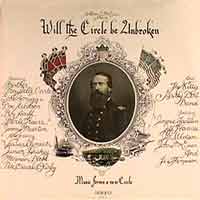 Bevor sie in den 80ern und 90ern in Nashville zu Stars wurden, war dies
eine von vielen kalifornischen Hippietruppen, die sich an Country und
Bluegrass versuchten. Mit "Mr. Bojangles" (Jerry Jeff Walker)
hatten sie kurz zuvor sogar einen Hit zu verzeichnen. Mit diesem gewaltigen
Dreifachalbum verbeugten sich Jim Fadden (dr+harp), Jeff Hanna
(voc,g), Jimmy Ibbotson (g) und John McEuen (bj) vor der
Musik aus den Appalachen. Dazu luden sie sich prominente Gäste ein,
u.a.: Earl Scruggs, Vassar Clements, Doc Watson,
Merle Travis, Maybelle Carter, Norman Blake und Ray
Acuff.
Bevor sie in den 80ern und 90ern in Nashville zu Stars wurden, war dies
eine von vielen kalifornischen Hippietruppen, die sich an Country und
Bluegrass versuchten. Mit "Mr. Bojangles" (Jerry Jeff Walker)
hatten sie kurz zuvor sogar einen Hit zu verzeichnen. Mit diesem gewaltigen
Dreifachalbum verbeugten sich Jim Fadden (dr+harp), Jeff Hanna
(voc,g), Jimmy Ibbotson (g) und John McEuen (bj) vor der
Musik aus den Appalachen. Dazu luden sie sich prominente Gäste ein,
u.a.: Earl Scruggs, Vassar Clements, Doc Watson,
Merle Travis, Maybelle Carter, Norman Blake und Ray
Acuff. |
| Oregon: "Music Of Another Present Era" (Vanguard, 1972) |
 Oregon, die auch heute noch aktiv sind, spielen eine unvergleichliche
Musik. Hier finden Jazz, E-Musik, Weltmusik und was ich noch alles (Europa,
Indien, USA) zu etwas Neuem zusammen. Man kann sich dieser Musik am ehesten
mit der Vorstellung der 4 absolut gleichberechtigten Musiker mit ihrem
jeweiligen Instrumenten nähern. Gleicher unter gleichen ist vielleicht
Ralph Towner (Ak. Gitarre, Piano, Trompete). Collin Walcott
spielt Perkussion und indische Instrumente (Sitar, Tablas). Glenn Moore
bedient den Kontrabass (gelegentlich Piano und Flöte). Paul McCandless
spielt Oboe und Bassklarinette. Dies ist ihr Debütalbum, denn das
eigentliche erste Album von 1970 kam erst 1980 in die Plattenläden.
Der Titel der Platte ist natürlich programmatisch und trifft es sehr
genau. Heimlicher "Hit" ist das Lied "The Silence Of A
Candle", das hier instrumental vorliegt, während es im gleichen
Jahr noch eine von Ralph Towner höchstpersönlich gesungene Version
auf dem Album "Icarus" vom Paul Winter
Consort gab, bei dem auch Walcott und McCandless mit dabei waren.
Oregon, die auch heute noch aktiv sind, spielen eine unvergleichliche
Musik. Hier finden Jazz, E-Musik, Weltmusik und was ich noch alles (Europa,
Indien, USA) zu etwas Neuem zusammen. Man kann sich dieser Musik am ehesten
mit der Vorstellung der 4 absolut gleichberechtigten Musiker mit ihrem
jeweiligen Instrumenten nähern. Gleicher unter gleichen ist vielleicht
Ralph Towner (Ak. Gitarre, Piano, Trompete). Collin Walcott
spielt Perkussion und indische Instrumente (Sitar, Tablas). Glenn Moore
bedient den Kontrabass (gelegentlich Piano und Flöte). Paul McCandless
spielt Oboe und Bassklarinette. Dies ist ihr Debütalbum, denn das
eigentliche erste Album von 1970 kam erst 1980 in die Plattenläden.
Der Titel der Platte ist natürlich programmatisch und trifft es sehr
genau. Heimlicher "Hit" ist das Lied "The Silence Of A
Candle", das hier instrumental vorliegt, während es im gleichen
Jahr noch eine von Ralph Towner höchstpersönlich gesungene Version
auf dem Album "Icarus" vom Paul Winter
Consort gab, bei dem auch Walcott und McCandless mit dabei waren.

 Mehr ...
Mehr ...
Music of Another Present Era remains Oregon's most enduring masterwork. Achieving a perfect balance of musical traditions from the East and West, ancient to future, they set the stage not only for a new transculturalism in jazz, but also created a lasting template for the fusion of musics from world traditions that would flower over a decade later. The four participants in Oregon, oboist and pianist Paul McCandless, guitarist and pianist Ralph Towner, upright bassist and pianist Glen Moore, and the late multi-instrumentalist Collin Walcott, operated on the premise that melodic ideas and expansive harmonies all contributed to a music that didn't bridge cultures, but erased them and eradicated them. This is a place where the astute dynamics of classical music meet the freedom of post-bop jazz in an inquiry of world rhythms and harmonics. Standout tracks include "North Star," with its celebration of rural music and rhythmic invention; the up-tempo "Sail" that offers a killer trio of Walcott's sprinting tablas; Towner's frenetic 12-string playing and Moore's inquiring bass; the intensely improvisatory "Shard/Spring Is Really Coming," and the lilting, "The Swan." This is fusion music to be sure, but it's the kind of fusion musicians have been trying unsuccessfully to emulate for decades. Music of Another Present Era is one of the most poetic and groundbreaking records to be released in the 1970s.
(by Thom Jurek, All Music Guide)
|
| "John David Souther" (Elektra/Asylum, 1972) |
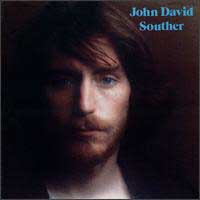 Gefunden in der Grabbelkiste!
Gefunden in der Grabbelkiste!
(10.05.2018)

 Mehr ...
Mehr ...

It may be that the only thing that kept Souther from becoming a major star in the '70s was that his friends the Eagles beat him to the country-rock style demonstrated on this album, which features "The Fast One" and "Run Like a Thief," both recorded by Linda Ronstadt.
(by William Ruhlmann, All Music Guide)
|
| Marcos Valle: "Vento Sul" (Odeon, 1972) |
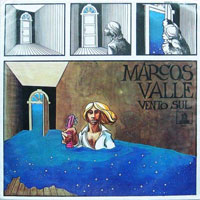 Lost & Found! Brazil!
Lost & Found! Brazil!
(09.03.2013)

 Mehr ...
Mehr ...
During the hot Brazilian summer of 1971, Marcos and Paulo Sergio Valle, along with their significant others and six additional couples, rented a few modest fisherman shacks in the small village of Búzios to escape from Rio's more populated beaches. The focus was making music and soul searching, as was the practice for affluent young hippies back then. They stayed for two months. "I wanted to go in a new direction," says Marcos looking back. "I wanted to try out a rock influence and to risk a little bit more." Shifting away from the studio musicians used on 1971's Garra, Vento Sul (translation "South Wind") was a rewarding collaboration with Brazilian progressive rockers O Terço. Originally released in 1972, Vento Sul not only channeled the Búzios beach bum vibe, but also manifested a floating dream like psychedelic sound. Any way you spin it, we at Light In The Attic are extremely proud to present Vento Sul as part of our four-album Marcos Valle reissue campaign. Consisting of an ambitious string of early 1970s landmark studio sessions (sympathetic in spirit to Stevie Wonder and Marvin Gaye's game changing work from the same era) and released on LP, Vento Sul features extensive liner notes by San Francisco-based writer Allen Thayer (Wax Poetics) with exclusive interview content and song-by-song breakdown from Marcos himself. Fans new and old will finally have easy breezy access to these once hard-to-find Brazilian classics. Elevated by a strong union between Valle and O Terço, Vento Sul'smagical spell of an album is a welcome addition to any South American friendly record collection and sits proudly with the best of Brazil. File after Os Mutantes and before Caetano Veloso.
Für heutige Ohren fällt diese exotische Mischung aus Flöten, E-Gitarren, Gainsbourg-Bass und entrückten Satzgesängen, die ebenso viele Kanten wie schwungvolle Rundungen aufweist, eigentümlich unvermittelt aus Zeit und Raum.
(stereoplay, März 2013)
When Marcos Valle recorded 1972's Vento Sul, he'd been a wildly successful, well-established songwriter, producer, and recording artist for nearly a decade, furthering the horizons of bossa nova and samba in the pre-MPB era. Due to that success, each successive recording brought higher expectations. In the face of mounting pressure, Valle dropped out for a bit, took a vacation, and in the process wrote the music for the album that was to become his hardest left turn to that point. Nothing could have prepared listeners for what transpired on Vento Sul (translation: South Wind). Even after the revolution tropicalia had wrought, this album was radical. The set was composed by Valle and brother Paulo Sérgio Valle in Buzios, then a mellow, out-of-the-way beach town that offered young people great surfing and a cosmic communal hippie vibe provided by the Valles and 14 companions who had taken the two-month summer retreat with them. When Valle returned to Rio, he sought to re-create the laid-back dreamy collaborative atmosphere of Buzios in the studio. He'd been backed live by Brazilian psychedelic, proto-prog rockers O Terço (translation: The Rosary), who included drummer and future guitar hero Vinicius Cantuária. He also employed arrangers Ian Guest and Hugo Bellard and studio aces such as guitarist Claudio Guimarães, drummer Robertinho Silva, and flutist Paulo Guimarães. Some of the music here retains undeniable elements of both bossa and samba ("Malena," "Rosto Barbado," and even the tripped-out "Paisagem de Mariana"), but they are wrapped in expansive psychedelic rock and baroque pop textures. Art rock makes its presence known in opener "Revolução Orgânica," with its contrasting hyper flute and hard rock guitar -- but make no mistake, this is not tropicalia; if anything it reflects the influence of O Terço most, and here too, samba makes its voice known in the bridge. There are Pet Sounds-era Beach Boys sounds, textures, and harmonies throughout, but best heard on cuts such as "Mi Hermoza" (even with its mean electric guitar breaks) and the instrumental "Bôdas de Sangu." "Democústico" is a hallucinatory, political, spoken word number, with phased wah-wah guitars, flutes, harpsichord, and Latin percussion. The title track, by contrast, with its layered piano, guitars, and stretched-to-the-breaking-point waltz rhythm, is so dreamy, spacious, romantic, and sparse, it's the set masterpiece. Vento Sul was greeted with hostility by Valle fans and critics alike, but time has proven that criticism unfounded. It remains one of Valle's most provocative albums, but it's also one of his most beautiful, mysterious, and enduring ones.
(by Thom Jurek, All Music Guide)
|
| "Arthur Verocai" (Continental, 1972) |
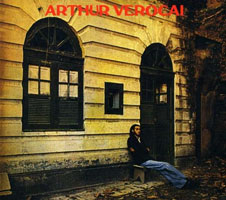 Lost & Found! Brazil!
Lost & Found! Brazil!
(18.08.2013)

 Mehr ...
Mehr ...
Das megarare Album des aussergewöhnlichen Komponisten und Arrangeurs Artur Verocai von 1972 ist wieder erhältlich! Das Album ist mit einer Mischung aus Funk Einflüssen, Folk Anleihen, jazzartigen Soli, zwanzigköpfigem Streichorchester, elektronischen Klängen und Soundtrackästhetik ein echtes Meisterwerk. Für Fans von Shuggie Otis, Jorge Ben oder Tim Maia!
Arthur Verocai's long-lost solo LP straddles the continents to fuse Brazilian tropicalia with American funk, yielding a shimmering, dreamlike mosaic of sound that both celebrates and advances the creative spirit. Employing a dizzyingly lush 20-piece string section, stiletto-sharp bursts of brass, and electric piano melodies that twinkle like stars, Verocai's heady productions draw on folk, jazz, and pop traditions from both sides of the equator to make music that is both immediately familiar and quite unlike anything else you've ever experienced. While its sun-kissed arrangements and insistent rhythms clearly evoke its Brazilian origins, Arthur Verocai nevertheless seems to exist somewhere far outside of space and time.
(by Jason Ankeny, All Music Guide)
|
| Loudon Wainwright III: "Album III" (Columbia, 1972) |
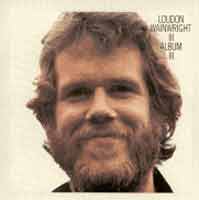 Die erste Produktion mit großer Besetzung: u.a. Hugh McCracken
(g), Eric Weissberg (banjo), Elliott Randall (g), Kenny
Kosek (vio) und Bill Keith.
Die erste Produktion mit großer Besetzung: u.a. Hugh McCracken
(g), Eric Weissberg (banjo), Elliott Randall (g), Kenny
Kosek (vio) und Bill Keith.

 Mehr ...
Mehr ...
|
Wainwright's directly autobiographical songs are both brutally honest
and extremely funny. Usually he plays alone, but here he gets a full folk/rock
backup, which brings out the pop implications of his music. His fluke
hit "Dead Skunk" is here, and so is "Red Guitar,"
about the destruction of one.
(William Ruhlmann, All
Music Guide)
|
|
| "A "new Dylan" with critical acclaim but
few fans, Loudon Wainwright III moved to Columbia Records and traded his
prior albums' unadorned voice and guitar for a higher-octane folk-rock ensemble
sound on this 1972 release. The strategy earned the WASP-ish troubadour
the left-field Top 40 hit "Dead Skunk," which is still his best-known
song--a Pyrrhic victory that confirmed Wainwright's wit and roguish vocal
style, but obscured the depth and nuance of his pointedly autobiographical
material. Album III offers more telling, if still funny, glimpses of its
author, as well as more sobering slices of his deceptively concise art.
Most striking of all is the blink-and-you'll-miss-it "Red Guitar,"
which in less than two minutes paints a startling self portrait of the rage
behind the smirk." (Sam Sutherland) |
|
| Wild Turkey: "Battle Hymn" (Chrysalis, 1972) |
|
 Dass in meinem Plattenarchiv bisher kein Hinweis zu Jethro Tull auftaucht
liegt daran, dass ich mich für Ian Anderson und sein Querflötenspiel
eigentlich nie interessiert habe. Die bekannten Alben ("Aqualung",
"Thick As A Brick") sind mir zwar durchaus ein Begriff und
ich finde sie auch nicht wirklich schlecht - nur ist "Tull"
eben nicht mein Ding. Auf Wild Turkey, die Band des Ex-Tull-Bassisten
Glenn Cornick, sind mein Freund Peter und ich ca. 1973/74 gestoßen
- bei Hertie/Dinslaken in der Grabbelkiste, da auch schon damals kaum
jemand das Album gekauft hatte. Weil ja Glenn Cornick bei Tull
"nur" den Bass bedient hat, klingt Wild Turkey auch
nicht nach jenen, auch wenn damals mit einem Tull-Sticker auf dem Cover
geworben wurde. Vielmehr ist die Musik eine Mischung aus typisch englischem
"Progressive Rock" und Folk: schöne Akustikgitarren,
E-Gitarren-Duette wie bei Wishbone Ash, vertrackte Rhythmen wie
bei vielen Bands dieser Zeit, zwei abwechslungsreiche Leadsänger
mit guten Songs und schönen Melodien. Außerdem haben immerhin drei
der fünf beteiligten Musiker einen direkten oder indirekten Bezug
zu Man, meinen alten Waliser Helden! Sagen wir also: Man-Faktor
= 2,5 Punkte, Tull-Faktor = 1 Punkt, wie folgendermaßen belegt werden
soll:
Dass in meinem Plattenarchiv bisher kein Hinweis zu Jethro Tull auftaucht
liegt daran, dass ich mich für Ian Anderson und sein Querflötenspiel
eigentlich nie interessiert habe. Die bekannten Alben ("Aqualung",
"Thick As A Brick") sind mir zwar durchaus ein Begriff und
ich finde sie auch nicht wirklich schlecht - nur ist "Tull"
eben nicht mein Ding. Auf Wild Turkey, die Band des Ex-Tull-Bassisten
Glenn Cornick, sind mein Freund Peter und ich ca. 1973/74 gestoßen
- bei Hertie/Dinslaken in der Grabbelkiste, da auch schon damals kaum
jemand das Album gekauft hatte. Weil ja Glenn Cornick bei Tull
"nur" den Bass bedient hat, klingt Wild Turkey auch
nicht nach jenen, auch wenn damals mit einem Tull-Sticker auf dem Cover
geworben wurde. Vielmehr ist die Musik eine Mischung aus typisch englischem
"Progressive Rock" und Folk: schöne Akustikgitarren,
E-Gitarren-Duette wie bei Wishbone Ash, vertrackte Rhythmen wie
bei vielen Bands dieser Zeit, zwei abwechslungsreiche Leadsänger
mit guten Songs und schönen Melodien. Außerdem haben immerhin drei
der fünf beteiligten Musiker einen direkten oder indirekten Bezug
zu Man, meinen alten Waliser Helden! Sagen wir also: Man-Faktor
= 2,5 Punkte, Tull-Faktor = 1 Punkt, wie folgendermaßen belegt werden
soll:
- Jon Blackmore - Rhythmusgitarre und 2. Leadsänger (Ex-Folksänger und Bruder Richie Blackmore!)
- Glenn Cornick - Bass & Keyboards (auf den ersten drei Jethro Tull-Alben dabei)
- Gary Pickford-Hopkins - 1. Leadsänger & Akustikgitarre (in den 60ern bei Eyes Of Blue mit Phil Ryan und John Weathers, beide später, aber nicht zeitgleich, bei Man! In den 70ern sang Gary allerdings leider auch für Rick Wakeman)
- Jeff Jones - Schlagzeug (erster Man-Trommler 1968/69)
- "Tweke" Lewis - Sologitarre (1973 für eine Saison bei Man, und zwar auf dem tollen Album "Back Into The Future")
Jon Blackmores "Dulwich Fox" ist übrigenz eines
der ersten Lieder, das ich damals auf der Gitarre hingekriegt habe (was
ABSOLUT NICHT gegen die Qualität des Songs spricht!) und schon
vor fast 30 Jahren bei meiner Premiere als "Folksänger"
vor Publikum gesungen habe!
Glenn Cornick gab Mitte/Ende der 70er dann mal ein Gastspiel
bei der Berliner Hardrockcombo Karthago. Es gab sogar einen Auftritt
in der Aula vom Dinslakener Mädchengymnasium, bei dem Herr Cornick
zur Konzertmitte als " Stargast" auf die Bühne kam, während
sich vorher der Gitarrist und der Keyboarder abwechselnd am Bass abgemüht
hatten. War alles irgendwie peinlich und eine grottenschlechte Musik
im Unterschied zu den wunderbaren Wild Turkey!
(2005)

 Mehr ...
Mehr ...
In December 1970, Glenn Cornick was kicked out of Jethro Tull according to an interview in A New Day fanzine. Then in 1971 he founded Wild Turkey, it was the best he could do because he didn´t find any better offers around and he didn´t know what to do with himself! He says that this was the two best years on the road as well as in the studio, most of the time, even if they didn´t know what they where doing he recalls. They did two albums and two American tours. Much later he did a third album with two of the original members, Alan "Tweke" Lewis and Gary Pickford-Hopkins.
(von einer Tull-Fans-Website)
|
| Paul Winter/Winter Consort: "Icarus" (Epic, 1972) |
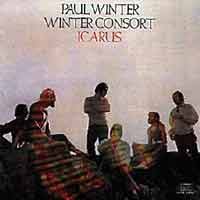 Neben ihrer Band Oregon spielten Ralph Towner,
Collin Walcott und Paul McCandless auch in der Band des
Sopransaxofonisten Paul Winter, der in den 60ern durch seine Pionierarbeit
bei der Popularisierung brasilianischer Musik in den USA bekannt wurde.
Kurios ist hier das später von Oregon bekannt
gewordene Stück "The Silence Of A Candle", das der Autor
Ralph Towner hier sogar singt: zwar nicht wirklich schlecht, aber
er ist doch ein ungleich besserer Gitarrist als Sänger! Produziert
wurde das Album von George Martin. Als Gast ist Billy Cobham
dabei, ohne dass er in dieser schönen Musik großartig stört.
Nur Glenn Moore fehlt.
Neben ihrer Band Oregon spielten Ralph Towner,
Collin Walcott und Paul McCandless auch in der Band des
Sopransaxofonisten Paul Winter, der in den 60ern durch seine Pionierarbeit
bei der Popularisierung brasilianischer Musik in den USA bekannt wurde.
Kurios ist hier das später von Oregon bekannt
gewordene Stück "The Silence Of A Candle", das der Autor
Ralph Towner hier sogar singt: zwar nicht wirklich schlecht, aber
er ist doch ein ungleich besserer Gitarrist als Sänger! Produziert
wurde das Album von George Martin. Als Gast ist Billy Cobham
dabei, ohne dass er in dieser schönen Musik großartig stört.
Nur Glenn Moore fehlt.

 Mehr ...
Mehr ...
|
This, a reissue of saxophonist Paul Winter's finest album, marks a transitional
point in his career from jazz to his own brand of contemporary instrumental.
But one can simply revel in the lovely melodies, the contemplative sounds,
and the tasteful production of George Martin, especially on the justly
famous title track by Ralph Towner.
(by William Ruhlmann, All
Music Guide)
|
|
| Bill Withers: "Still Bill" (Sussex, 1972) |
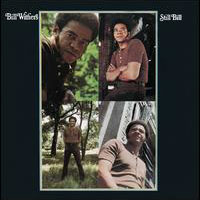 Die meisten Leute kennen von ihm natürlich "Ain't No Sunshine",
seinen überraschungshit - und inzwischen Blues-Klassiker - vom Vorjahr,
aber auch auf Album Nr.3 hat der Sänger und Songschreiber mit "Use
Me" und "Lean On Me" zwei Lieder für die Ewigkeit
dabei. "Still Bill" hatte Withers mit seiner vorzüglichen
Liveband eingespielt und auch produziert: Pianist Ray Jackson,
Trommler James Gadson, Bassist Melvin Dunlap und Gitarrist
Benorce Blackmon, anschliessend etwas "aufgepeppt" durch
Streicher und Bläser, die aber nichts verhunzen. Was ich an den Platten
aus dieser Zeit besonders liebe sind die alten analogen Tastenklänge.
Ich sage nur: Wurlitzer und Hohner D6!
Die meisten Leute kennen von ihm natürlich "Ain't No Sunshine",
seinen überraschungshit - und inzwischen Blues-Klassiker - vom Vorjahr,
aber auch auf Album Nr.3 hat der Sänger und Songschreiber mit "Use
Me" und "Lean On Me" zwei Lieder für die Ewigkeit
dabei. "Still Bill" hatte Withers mit seiner vorzüglichen
Liveband eingespielt und auch produziert: Pianist Ray Jackson,
Trommler James Gadson, Bassist Melvin Dunlap und Gitarrist
Benorce Blackmon, anschliessend etwas "aufgepeppt" durch
Streicher und Bläser, die aber nichts verhunzen. Was ich an den Platten
aus dieser Zeit besonders liebe sind die alten analogen Tastenklänge.
Ich sage nur: Wurlitzer und Hohner D6!
(22.10.2009)

 Mehr ...
Mehr ...
Bill Withers came into his own on his third album, Still Bill. Released in 1972, the record is a remarkable summation of a number of contemporary styles: the smooth soul coming out of Philly, smoky, late-night funk via Bobby Womack, bluesy Southern soul, and '70s singer/songwriterism. It's rich, subtly layered music, but its best attribute is that it comes on easy, never sounding labored or overworked. In fact, it takes several spins of the album to realize just how versatile Withers is on Still Bill, to hear how he makes intricate, funky rhythms sound as effortless and simple as the album's best-known song, the gospel-tinged inspirational anthem "Lean on Me." That's the genius behind Withers' music: it's warm and easily accessible, but it has a depth and complexity that reveals itself over numerous plays — and, given the sound and feel of the music, from the lush arrangements to his comforting voice, it's easy to want to play this again and again. Then there's the quality of the songwriting, which is as assured on the grooving "Lonely Town, Lonely Street" as it is on the suspicious, paranoid "Who Is He (And What Is He to You)?" or "Use Me," where he happily submits to being used by his object of affection. This high level of songwriting is sustained throughout the record, making this the greatest testament to his considerable gifts.
(by Stephen Thomas Erlewine, All Music Guide)
|
| Townes van Zandt: "High, Low And In Between" (Tomato, 1972) |
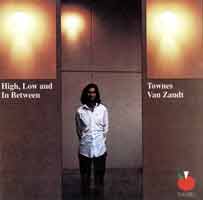 Dieses
mal wurde TVZ in L. A. produziert, ohne dass man einen großen Unterschied
zu den vorherigen Alben hört (Gott sei dank!). Ausnahmsweise werden
die Begleitmusiker erwähnt. Da taucht doch glatt der Jazzgitarrist
Larry Carlton auf! Dieses
mal wurde TVZ in L. A. produziert, ohne dass man einen großen Unterschied
zu den vorherigen Alben hört (Gott sei dank!). Ausnahmsweise werden
die Begleitmusiker erwähnt. Da taucht doch glatt der Jazzgitarrist
Larry Carlton auf! |
 Das Album des Jahres
Das Album des Jahres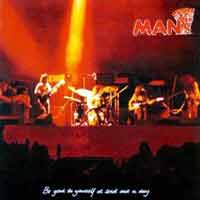
 Die
berühmte Platte mit der Landkarte von Wales ist mein Lieblingsalbum
einer meiner Lieblingsbands. Kurioserweise eine der wenigen Man-Platten
ohne Deke Leonard, der sich 1972/73 eine solistische Auszeit nahm
("Iceberg"), aber danach
wieder zur Band zurückkehrte. Wir hören Mickey Jones
an der Gitarre, der einzige Musiker, der auf allen Man-Platten spielt,
Phil Ryan an den Keyboards (neu dabei), Will Youatt am Bass
(neu dabei und vorher Gitarrist), Terry Williams am Schlagzeug
(wurde später mit Rockpile
und den Dire Straits semi-berühmt) und Clive John an der zweiten
Gitarre (war früher mal Keyboarder bei Man!). Insgesamt eine sehr
komplizierte Bandgeschichte, die auf der von Deke Leonard gezeichneten
Innenhülle nachzulesen ist. Produziert hatte übrigens Dave
Edmunds. Es gibt insgesamt nur 4 Songs, darunter mit "C'mon"
und "Bananas" zwei der absoluten Man-Klassiker.
Die
berühmte Platte mit der Landkarte von Wales ist mein Lieblingsalbum
einer meiner Lieblingsbands. Kurioserweise eine der wenigen Man-Platten
ohne Deke Leonard, der sich 1972/73 eine solistische Auszeit nahm
("Iceberg"), aber danach
wieder zur Band zurückkehrte. Wir hören Mickey Jones
an der Gitarre, der einzige Musiker, der auf allen Man-Platten spielt,
Phil Ryan an den Keyboards (neu dabei), Will Youatt am Bass
(neu dabei und vorher Gitarrist), Terry Williams am Schlagzeug
(wurde später mit Rockpile
und den Dire Straits semi-berühmt) und Clive John an der zweiten
Gitarre (war früher mal Keyboarder bei Man!). Insgesamt eine sehr
komplizierte Bandgeschichte, die auf der von Deke Leonard gezeichneten
Innenhülle nachzulesen ist. Produziert hatte übrigens Dave
Edmunds. Es gibt insgesamt nur 4 Songs, darunter mit "C'mon"
und "Bananas" zwei der absoluten Man-Klassiker.
 Mehr ...
Mehr ...
 weitere
Highlights ...
weitere
Highlights ...  Der
ehemalige Softmachine Sänger/Bassist hatte in den 70ern eine
mehr oder weniger erfolgreiche Solokarriere gestartet. Hier kam wieder
das "psychedelische Element" stärker zum Tragen, das bei
Softmachine zugunsten einer ernsthaften Jazzrock-Ausrichtung geopfert
wurde. Als Gast wirkt sein ehemaliger Bandkollege Robert Wyatt
mit (der auch bald Softmachine verlassen wird). Der auffälligste
Name in der Besetzungsliste ist allerdings der damals noch recht junge
Mike Oldfield als Gitarrist und Bassist, kurz vor seinem Durchbruch
zu Weltruhm mit dieser unsäglichen "Tubular Bells"-Platte.
Insgesamt ein versponnenes, sympathisches Album.
Der
ehemalige Softmachine Sänger/Bassist hatte in den 70ern eine
mehr oder weniger erfolgreiche Solokarriere gestartet. Hier kam wieder
das "psychedelische Element" stärker zum Tragen, das bei
Softmachine zugunsten einer ernsthaften Jazzrock-Ausrichtung geopfert
wurde. Als Gast wirkt sein ehemaliger Bandkollege Robert Wyatt
mit (der auch bald Softmachine verlassen wird). Der auffälligste
Name in der Besetzungsliste ist allerdings der damals noch recht junge
Mike Oldfield als Gitarrist und Bassist, kurz vor seinem Durchbruch
zu Weltruhm mit dieser unsäglichen "Tubular Bells"-Platte.
Insgesamt ein versponnenes, sympathisches Album. Nachdem
Eric Clapton mit "After Midnight" erfolgreich war, bekam
J.J. seine eigene Chance und nutzte sie. Neben "After Midnight"
seien erwähnt: "Call Me The Breeze" und "Magnolia".
Nachdem
Eric Clapton mit "After Midnight" erfolgreich war, bekam
J.J. seine eigene Chance und nutzte sie. Neben "After Midnight"
seien erwähnt: "Call Me The Breeze" und "Magnolia". Diese
Platte hat Jerry (fast) alleine aufgenommen, er wurde nur vom Dead-Trommler
Bill Kreutzmann unterstützt. Enthält neben einigen Soundexperimenten
ein paar tolle Songs, die schnell den Weg in das Bühnenrepertoire
der Dead fanden: "Deal", "Birdsong", "Sugaree",
"Loser", "To Lay Me Down" und "The Wheel".
Diese
Platte hat Jerry (fast) alleine aufgenommen, er wurde nur vom Dead-Trommler
Bill Kreutzmann unterstützt. Enthält neben einigen Soundexperimenten
ein paar tolle Songs, die schnell den Weg in das Bühnenrepertoire
der Dead fanden: "Deal", "Birdsong", "Sugaree",
"Loser", "To Lay Me Down" und "The Wheel".
 Mehr ...
Mehr ...
 Das Meisterwerk der Stones.
Das Meisterwerk der Stones.
 Mehr ...
Mehr ...
 Nach
dem gescheiterten Versuch ihres Managements, die Band mit ihrem Debüt
1970 in New York als das "Next Big Thing" zu etablieren,
machte die Band um Nick Lowe
(voc, bg, Songwriter), Bob Andrews (keyb), Namensgeber Brinsley
Schwarz (g), Drummer Billy Rankin und Neuzugang Ian Gomm
(voc,g) eine Wendung um 180°, um fortan in den englischen Kneipen
zu spielen: der "Pubrock" war geboren. Die Musik auf "Silver
Pistol" ist extrem laidback und sehr amerikanisch ausgereichtet.
Nick Lowe, der als Solist und Produzent später sehr erfolgreich wurde,
bezeichnete ihre Musik mal als den Versuch, "Rag Mama Rag" von
"The Band" neu zu erfinden (m. E. kein schlechtes, wenn auch
ein sehr hohes Ziel!). Neben den Songs von Lowe (und auch Gomm) sei besonders
auf den Rock'n'Roll-Klassiker "Juju Man" hingewiesen, den später
Dave Edmunds zum Hit machte und den ich mit meiner Band Rusty
Nails in den 80ern auch sehr gerne live gespielt habe.
Nach
dem gescheiterten Versuch ihres Managements, die Band mit ihrem Debüt
1970 in New York als das "Next Big Thing" zu etablieren,
machte die Band um Nick Lowe
(voc, bg, Songwriter), Bob Andrews (keyb), Namensgeber Brinsley
Schwarz (g), Drummer Billy Rankin und Neuzugang Ian Gomm
(voc,g) eine Wendung um 180°, um fortan in den englischen Kneipen
zu spielen: der "Pubrock" war geboren. Die Musik auf "Silver
Pistol" ist extrem laidback und sehr amerikanisch ausgereichtet.
Nick Lowe, der als Solist und Produzent später sehr erfolgreich wurde,
bezeichnete ihre Musik mal als den Versuch, "Rag Mama Rag" von
"The Band" neu zu erfinden (m. E. kein schlechtes, wenn auch
ein sehr hohes Ziel!). Neben den Songs von Lowe (und auch Gomm) sei besonders
auf den Rock'n'Roll-Klassiker "Juju Man" hingewiesen, den später
Dave Edmunds zum Hit machte und den ich mit meiner Band Rusty
Nails in den 80ern auch sehr gerne live gespielt habe. Ich kann zwar nicht behaupten, dass ich mich besonders gut mit Soulmusik
auskenne - Al Green aus Memphis vom legendären Label Hi-Records gehörte
in den 70ern sicherlich zu den großen schwarzen Stimmen: vielleicht nur
vergleichbar mit Marvin Gaye. Oder Otis Redding, wenn dieser
nicht zu früh verstorben wäre. Später wurde er zum Priester
in Memphis (mit eigener Kirche, wie z.B. auch Solomon Burke), zog
sich ganz aus "weltlicher Musik" zurück, nur gelegentlich
von kurzen Ausflügen in die Popmusik unterbrochen. In den 80ern war
er eigentlich nur durch Tina Turners Coverversion vom Titelstück
des Albums im Gespräch. In den 90ern gab's einen witzigen Gastauftritt
bei Ally MacBeal. Im Jahr 2003 kehrt er nun mit einem neuen Album
"I Can't Stop" zurück, das so klingt als hätte es
diese 30 Jahre Unterbrechung zwischen den beiden Alben nicht gegeben!
Ich kann zwar nicht behaupten, dass ich mich besonders gut mit Soulmusik
auskenne - Al Green aus Memphis vom legendären Label Hi-Records gehörte
in den 70ern sicherlich zu den großen schwarzen Stimmen: vielleicht nur
vergleichbar mit Marvin Gaye. Oder Otis Redding, wenn dieser
nicht zu früh verstorben wäre. Später wurde er zum Priester
in Memphis (mit eigener Kirche, wie z.B. auch Solomon Burke), zog
sich ganz aus "weltlicher Musik" zurück, nur gelegentlich
von kurzen Ausflügen in die Popmusik unterbrochen. In den 80ern war
er eigentlich nur durch Tina Turners Coverversion vom Titelstück
des Albums im Gespräch. In den 90ern gab's einen witzigen Gastauftritt
bei Ally MacBeal. Im Jahr 2003 kehrt er nun mit einem neuen Album
"I Can't Stop" zurück, das so klingt als hätte es
diese 30 Jahre Unterbrechung zwischen den beiden Alben nicht gegeben! Mehr ...
Mehr ...
 Eines
der frühen, sehr schönen Soloalben von Matthews nach seiner
Zeit bei Fairport Convention und Matthews Southern Comfort.
In der Begleitband spielte u. a. Andy Roberts,
mit dem er kurz danach Plainsong gründete.
Es wurden für Matthews Verhältnisse relativ viele Eigenkompositionen
aufgenommen, von denen aber keine bekannt geworden ist. Unter den Fremdkompositionen
sind der alte Ronettes-Hit "Da Doo Run Run" und Songs von Eric
Anderson und Richard Farina zu vermelden.
Eines
der frühen, sehr schönen Soloalben von Matthews nach seiner
Zeit bei Fairport Convention und Matthews Southern Comfort.
In der Begleitband spielte u. a. Andy Roberts,
mit dem er kurz danach Plainsong gründete.
Es wurden für Matthews Verhältnisse relativ viele Eigenkompositionen
aufgenommen, von denen aber keine bekannt geworden ist. Unter den Fremdkompositionen
sind der alte Ronettes-Hit "Da Doo Run Run" und Songs von Eric
Anderson und Richard Farina zu vermelden.
 Neils
bekannteste und erfolgreichste Platte mit seinem Hit "Heart Of Gold"
und (trotzdem) eine tolle Platte!
Neils
bekannteste und erfolgreichste Platte mit seinem Hit "Heart Of Gold"
und (trotzdem) eine tolle Platte!  Mehr ...
Mehr ...
 Sein Debüt, dass eigentlich unbetitelt ist, aber wegen des Schriftzugs
auf dem Wassersack vom Cover von Designer Gary Burden und Photograph
Henry Diltz nur unter dem Namen "Saturate Before Using"
bekannt, entstand mit tatkräftiger Unterstützung von David
Crosby, nachdem vorher bereits mehrere seiner Lieder von anderen Künstlern
gesungen wurden (z.B. "These Days" von Nico
und "Doctor My Eyes" von den Jackson Five!) und er 17jährig
in New York Nico's Begleitgitarrist war.
Sein Debüt, dass eigentlich unbetitelt ist, aber wegen des Schriftzugs
auf dem Wassersack vom Cover von Designer Gary Burden und Photograph
Henry Diltz nur unter dem Namen "Saturate Before Using"
bekannt, entstand mit tatkräftiger Unterstützung von David
Crosby, nachdem vorher bereits mehrere seiner Lieder von anderen Künstlern
gesungen wurden (z.B. "These Days" von Nico
und "Doctor My Eyes" von den Jackson Five!) und er 17jährig
in New York Nico's Begleitgitarrist war.
 Mehr ...
Mehr ...
 Auf dieser Platte brachte Corea die USA und Brasilien zusammen: sein eigenes
wunderbares Fender-Rhodes-Piano, Stanley Clark am Kontrabass und
Joe Farrell mit Flöte und Sopransaxofon, kombiniert mit Airto
Moreiras Schlagzeugspiel (normalerweise spielt er Perkussion) und
dem Gesang von Flora Purim. Die Songs
(z.T. mit Texten von Neville Potter) wurden Klassiker des Latin-Jazz:
"Crystal Silence", "La Fiesta", "What Game Shall
We Play Today" und "Sometime Ago".
Auf dieser Platte brachte Corea die USA und Brasilien zusammen: sein eigenes
wunderbares Fender-Rhodes-Piano, Stanley Clark am Kontrabass und
Joe Farrell mit Flöte und Sopransaxofon, kombiniert mit Airto
Moreiras Schlagzeugspiel (normalerweise spielt er Perkussion) und
dem Gesang von Flora Purim. Die Songs
(z.T. mit Texten von Neville Potter) wurden Klassiker des Latin-Jazz:
"Crystal Silence", "La Fiesta", "What Game Shall
We Play Today" und "Sometime Ago".
 Mehr ...
Mehr ...
 Auch bei ihrer zweiten Platte gelang der Truppe um Tony Colton,
Albert Lee und Chas Hodges ("Chas & Dave")
mit ihrem virtuosen Countryrock leider nicht der Durchbruch beim großen
Publikum! Trotzdem eine tolle Platte.
Auch bei ihrer zweiten Platte gelang der Truppe um Tony Colton,
Albert Lee und Chas Hodges ("Chas & Dave")
mit ihrem virtuosen Countryrock leider nicht der Durchbruch beim großen
Publikum! Trotzdem eine tolle Platte.
 Mehr ...
Mehr ...
 Das Album war nach einer akustischen und einer elektrischen Liveplatte
ihr erstes Studiowerk. Zu dem Zeitpunkt hatte die Band ihre eigene Identität
erarbeitet und wurde nicht mehr als „Urlaub von Jefferson Airplane“
gesehen. Ende des Jahres erschien dann noch das Airplane-Album "Long
John Silver", danach wurde Hot Tuna sogar zum Hauptbetätigungsfeld
von Jorma Kaukonen und Jack Casady. Kaukonen schrieb einige
exzellente Songs zwischen Folkblues-Picking (sehr gelungen: der "Water
Song") und Acid-Rock, Casady und Sammy Piazza waren eine gut
geölte Rhythmusgruppe und für Extra-Spannung sorgte der damals
bereits 55jährige Papa John Creach an der Violine. Bei einer
Nummer gibt es sogar gesangliche Unterstützung von David Crosby.
„Burgers“, die Platte mit dem schönen alten Auto vorne
auf dem Cover drauf, war sicher ihr bestes Studioalbum.
Das Album war nach einer akustischen und einer elektrischen Liveplatte
ihr erstes Studiowerk. Zu dem Zeitpunkt hatte die Band ihre eigene Identität
erarbeitet und wurde nicht mehr als „Urlaub von Jefferson Airplane“
gesehen. Ende des Jahres erschien dann noch das Airplane-Album "Long
John Silver", danach wurde Hot Tuna sogar zum Hauptbetätigungsfeld
von Jorma Kaukonen und Jack Casady. Kaukonen schrieb einige
exzellente Songs zwischen Folkblues-Picking (sehr gelungen: der "Water
Song") und Acid-Rock, Casady und Sammy Piazza waren eine gut
geölte Rhythmusgruppe und für Extra-Spannung sorgte der damals
bereits 55jährige Papa John Creach an der Violine. Bei einer
Nummer gibt es sogar gesangliche Unterstützung von David Crosby.
„Burgers“, die Platte mit dem schönen alten Auto vorne
auf dem Cover drauf, war sicher ihr bestes Studioalbum.  Die "Supergroup" des frühen texanischen Singer/Songwritermusik.
Neben Jimmie Dale Gilmore als "Gleicher unter Gleichen"
darf man da natürlich Joe Ely und
Butch Hancock nicht vergessen. Der Spruch
"Unplugged" auf dem Cover ist natürlich dem Zeitgeist der
CD-Wiederveröffentlichung in den 90ern geschuldet und in etwa so
sinnvoll, wie der Hinweis, dass Heavy Metal elektrisch wäre.
Die "Supergroup" des frühen texanischen Singer/Songwritermusik.
Neben Jimmie Dale Gilmore als "Gleicher unter Gleichen"
darf man da natürlich Joe Ely und
Butch Hancock nicht vergessen. Der Spruch
"Unplugged" auf dem Cover ist natürlich dem Zeitgeist der
CD-Wiederveröffentlichung in den 90ern geschuldet und in etwa so
sinnvoll, wie der Hinweis, dass Heavy Metal elektrisch wäre.
 Mehr ...
Mehr ...
 Solche "Kiffermusik" habe ich damals wenig gehört: ich
war ja auch noch ein unschuldiger Teenie. Auch Manuel Göttschings
Band lief ziemlich an mir vorbei. Aber irgendwie mag ich das jetzt doch!
Sehr entspannende Musik, die man auch ohne Drogenkonsum gut hören
kann.
Solche "Kiffermusik" habe ich damals wenig gehört: ich
war ja auch noch ein unschuldiger Teenie. Auch Manuel Göttschings
Band lief ziemlich an mir vorbei. Aber irgendwie mag ich das jetzt doch!
Sehr entspannende Musik, die man auch ohne Drogenkonsum gut hören
kann. Mehr ...
Mehr ...
 Ohne damals wirklich erfolgreich gewesen zu sein, gelten Alex Chiltons
drei Big Star-Platten, von denen hier beispielhaft die erste vorgestellt
wird, heute zu Recht als Kult. Mit dabei hier auch Chris
Bell als zweiter Sänger und Gitarrist.
Ohne damals wirklich erfolgreich gewesen zu sein, gelten Alex Chiltons
drei Big Star-Platten, von denen hier beispielhaft die erste vorgestellt
wird, heute zu Recht als Kult. Mit dabei hier auch Chris
Bell als zweiter Sänger und Gitarrist.
 Mehr ...
Mehr ...
 Lost & Found
Lost & Found
 Atlantics erste Produzenten-Riege (Tom Dowd, Ahmet Ertegun,
Michael Cuscuna) versuchte, zusammen mit Eric Clapton, auch
Buddy Guy und Junior Wells an dem damaligen Bluesboom partizipieren zu
lassen. Heraus kam eine unspektakuläre, aber schöne Platte,
auf der Clapton sogar uneigennützig nur Rhythmusgitarre spielt und
auf einem Titel auch die damaligen Atlantic-Shooting Stars J.Geils
Band dabei sind.
Atlantics erste Produzenten-Riege (Tom Dowd, Ahmet Ertegun,
Michael Cuscuna) versuchte, zusammen mit Eric Clapton, auch
Buddy Guy und Junior Wells an dem damaligen Bluesboom partizipieren zu
lassen. Heraus kam eine unspektakuläre, aber schöne Platte,
auf der Clapton sogar uneigennützig nur Rhythmusgitarre spielt und
auf einem Titel auch die damaligen Atlantic-Shooting Stars J.Geils
Band dabei sind.  Ein etwas skurrile Truppe aus den frühen Tagen des britischen Pubrocks,
ein wenig an die Waliser Kollegen von Man erinnernd. Bei deren
Weihnachtskonzert "Christmas At The
Patti" traten sie dann mit dem zu diesem Zeitpunkt ehemaligen
Man-Sänger/Gitarristen Deke Leonard auf und begleiteten ihn
auch auf dessen Soloalbum "Iceberg".
Der Sänger und Gitarrist Malcolm Morley war dann nach dem
Ende von Help Yourself als Keyboarder auf Man's 74er Album "Rhinos,
Winos & Lunatics" dabei. Insgesamt hat es für die Band
höchstens für eine kleine Fußnote in der britischen Rockgeschichte
gereicht. Allein Schlagzeuger Dave Charles ist heutzutage noch
als Musiker (Dave Edmunds Band), Toningenieur (in den berühmten Waliser
Rockfield-Studios) und Produzent (z.B. bei Man's Comebackalbum "Endangered
Species" von 2000) im Geschäft.
Ein etwas skurrile Truppe aus den frühen Tagen des britischen Pubrocks,
ein wenig an die Waliser Kollegen von Man erinnernd. Bei deren
Weihnachtskonzert "Christmas At The
Patti" traten sie dann mit dem zu diesem Zeitpunkt ehemaligen
Man-Sänger/Gitarristen Deke Leonard auf und begleiteten ihn
auch auf dessen Soloalbum "Iceberg".
Der Sänger und Gitarrist Malcolm Morley war dann nach dem
Ende von Help Yourself als Keyboarder auf Man's 74er Album "Rhinos,
Winos & Lunatics" dabei. Insgesamt hat es für die Band
höchstens für eine kleine Fußnote in der britischen Rockgeschichte
gereicht. Allein Schlagzeuger Dave Charles ist heutzutage noch
als Musiker (Dave Edmunds Band), Toningenieur (in den berühmten Waliser
Rockfield-Studios) und Produzent (z.B. bei Man's Comebackalbum "Endangered
Species" von 2000) im Geschäft.
 Mehr ...
Mehr ...
 Wunderbares
Debütalbum einer der besten deutschen "Krautrockbands"
der damaligen Zeit, noch sehr folkloristisch, kaum elektrische Instrumente
(ein wenig E-Bass, Mellotron und Orgel), viel Geige, Cello, Akustikgitarre
und Flöten und der charmante Gesang von Nanny de Ruig mit
süßem holländischen Akzent. Da ich die Band erst drei
Jahre später mit ihrem zweitem titellosen Album entdeckt habe und
dieses Debüt damals nicht mehr zu bekommen war, konnte ich es erst
vor wenigen Jahren dank der CD-Wiederveröffentlichung vom Billiglabel
ZYX ergattern.
Wunderbares
Debütalbum einer der besten deutschen "Krautrockbands"
der damaligen Zeit, noch sehr folkloristisch, kaum elektrische Instrumente
(ein wenig E-Bass, Mellotron und Orgel), viel Geige, Cello, Akustikgitarre
und Flöten und der charmante Gesang von Nanny de Ruig mit
süßem holländischen Akzent. Da ich die Band erst drei
Jahre später mit ihrem zweitem titellosen Album entdeckt habe und
dieses Debüt damals nicht mehr zu bekommen war, konnte ich es erst
vor wenigen Jahren dank der CD-Wiederveröffentlichung vom Billiglabel
ZYX ergattern. Im Oktober 1971 formierte Schlagzeuger und Sänger Robert Wyatt
eine Gruppe aus Mitgliedern diverser Canterbury Bands: Keyboarder Dave
Sinclair hatte Caravan nach "In
The Land Of Grey And Pink" verlassen, Bassist Bill MacCormick
spielte mit Roxy Musics Phil Manzanera bei Quiet Sun und Gitarrist
Phil Miller spielte mit seinem tastenspielenden Bruder Steve
Miller, welcher wiederum Sinclair auf "Waterloo
Lily" bei Caravan ersetzt hatte, bei Delivery). Wyatt
benannte die Band als kleinen Scherz auf Soft Machine, wo er gerade
ausgestiegen war (lautmalerisch für die französische übersetzung
von "soft machine": "machine mole". Auf dem Cover
sind auch 2 Maulwürfe zu sehen).
Im Oktober 1971 formierte Schlagzeuger und Sänger Robert Wyatt
eine Gruppe aus Mitgliedern diverser Canterbury Bands: Keyboarder Dave
Sinclair hatte Caravan nach "In
The Land Of Grey And Pink" verlassen, Bassist Bill MacCormick
spielte mit Roxy Musics Phil Manzanera bei Quiet Sun und Gitarrist
Phil Miller spielte mit seinem tastenspielenden Bruder Steve
Miller, welcher wiederum Sinclair auf "Waterloo
Lily" bei Caravan ersetzt hatte, bei Delivery). Wyatt
benannte die Band als kleinen Scherz auf Soft Machine, wo er gerade
ausgestiegen war (lautmalerisch für die französische übersetzung
von "soft machine": "machine mole". Auf dem Cover
sind auch 2 Maulwürfe zu sehen). "Lost And Found"!
"Lost And Found"! Dieses Album hatte ich fast vergessen! Auf jeden Fall habe ich es jahrelang
nicht mehr gehört. Es ist das siebte Album dieser klassischen Besetzung
der Moodies, die mit "Days Of Future
Passed" 1967 begonnen hatte und in der die Band zu einem der
größten damaligen Liveacts heranreifte. Es stellt aber auch das Ende dieser
Phase dar. Aus den Interviews mit den Mitgliedern, abgedruckt im Beiheft
zur Reissue-CD, geht deutlich hervor, wie schwierig die Aufnahmesessions
damals waren. Bekanntlich gab's danach ja eine lange Pause bis zur eher mäßigen
Comebackplatte "Octave" von 1978 und noch weiteren Alben bis
in die heutige Zeit, die ich mir aber gar nicht erst angehört habe.
Auf jeden Fall gehören diese 7 Platten zum Feinsten, was es an Rockmusik
der Fraktion "Schönklang/Klassik/Bombast" aus jener Zeit
gibt. Neben den beiden 1969er Werken "On
The Threshold Of A Dream" und "To
Our Children's Children's Children" gehörten "Seventh
Sojourn" auf jeden Fall zu meinen Lieblingsplatten aus jenen Tagen.
Dieses Album hatte ich fast vergessen! Auf jeden Fall habe ich es jahrelang
nicht mehr gehört. Es ist das siebte Album dieser klassischen Besetzung
der Moodies, die mit "Days Of Future
Passed" 1967 begonnen hatte und in der die Band zu einem der
größten damaligen Liveacts heranreifte. Es stellt aber auch das Ende dieser
Phase dar. Aus den Interviews mit den Mitgliedern, abgedruckt im Beiheft
zur Reissue-CD, geht deutlich hervor, wie schwierig die Aufnahmesessions
damals waren. Bekanntlich gab's danach ja eine lange Pause bis zur eher mäßigen
Comebackplatte "Octave" von 1978 und noch weiteren Alben bis
in die heutige Zeit, die ich mir aber gar nicht erst angehört habe.
Auf jeden Fall gehören diese 7 Platten zum Feinsten, was es an Rockmusik
der Fraktion "Schönklang/Klassik/Bombast" aus jener Zeit
gibt. Neben den beiden 1969er Werken "On
The Threshold Of A Dream" und "To
Our Children's Children's Children" gehörten "Seventh
Sojourn" auf jeden Fall zu meinen Lieblingsplatten aus jenen Tagen. Mehr ...
Mehr ...
 Die Band habe ich mir sicherlich mehr als 25 Jahre nicht mehr angehört.
Damals war einer meiner besten Freunde beinharter Wishbone Ash-Fan, während
Hawkwind meine Fraktion war. Trotzdem habe auch ich mir die Band damals
sehr gerne angehört. Als es dann bei uns Mitte der 70er selber mit
Musikmachen losging und alle Bands dann das zweistimmige Gitarrenspiel
von Andy Powell und Ted Turner versucht haben zu imitieren,
habe ich sehr schnell die Lust auch auf das Original verloren (das ging
mir übrigenz in den späten 70ern/frühen 80ern mit Z.Z.Top
genauso, die von all den Bluesbands in unserer Gegend zu Tode gecovert
wurden).
Die Band habe ich mir sicherlich mehr als 25 Jahre nicht mehr angehört.
Damals war einer meiner besten Freunde beinharter Wishbone Ash-Fan, während
Hawkwind meine Fraktion war. Trotzdem habe auch ich mir die Band damals
sehr gerne angehört. Als es dann bei uns Mitte der 70er selber mit
Musikmachen losging und alle Bands dann das zweistimmige Gitarrenspiel
von Andy Powell und Ted Turner versucht haben zu imitieren,
habe ich sehr schnell die Lust auch auf das Original verloren (das ging
mir übrigenz in den späten 70ern/frühen 80ern mit Z.Z.Top
genauso, die von all den Bluesbands in unserer Gegend zu Tode gecovert
wurden). In
den frühen 70ern hatte die Band aus Canterbury eine richtig gute
Phase. Dabei entstanden ein paar schöne Alben wie dieses hier. Heutzutage
gilt so was ja als "Prog-Rock" (Yes, frühe Genesis,
etc.). In diesen Topf solltet ihr diese Band aber nicht werfen, wäre
zu schade.
In
den frühen 70ern hatte die Band aus Canterbury eine richtig gute
Phase. Dabei entstanden ein paar schöne Alben wie dieses hier. Heutzutage
gilt so was ja als "Prog-Rock" (Yes, frühe Genesis,
etc.). In diesen Topf solltet ihr diese Band aber nicht werfen, wäre
zu schade.
 Mehr ...
Mehr ...
 Beim
zweiten Album wurden Little Feat zum Sextett: Kenny Gradney ersetzte
Roy Estrada am Bass. Zu Lowell George (voc, Slidegit.), Bill
Payne (keyb) und Richie Hayward (dr) stießen der Gitarrist
Paul Barrere und der Congaspieler Sam Clayton. Die Songs,
meist aus der Feder von Lowell George, sprechen für sich:
"Easy To Slip", "Trouble", eine neue Version von "Willin'"
und natürlich der Titelsong.
Beim
zweiten Album wurden Little Feat zum Sextett: Kenny Gradney ersetzte
Roy Estrada am Bass. Zu Lowell George (voc, Slidegit.), Bill
Payne (keyb) und Richie Hayward (dr) stießen der Gitarrist
Paul Barrere und der Congaspieler Sam Clayton. Die Songs,
meist aus der Feder von Lowell George, sprechen für sich:
"Easy To Slip", "Trouble", eine neue Version von "Willin'"
und natürlich der Titelsong. Sicherlich
nicht Mayalls bekannteste Platte, aber die erste, die mir damals aufgefallen
war. Mayall hatte eine hochkarätige Truppe von virtuosen Jazzern
um sich versammelt, die seine teils recht schlichten Bluesvorlagen auf
ein anderes Level gehoben haben. Es spielten: Larry Taylor (Bass,
vorher & nachher bei Canned Heat), Freddy Robinson (g), Clifford
Solomon (sax), Blue Mitchell (tp) und Ron Selico (dr).
Sicherlich
nicht Mayalls bekannteste Platte, aber die erste, die mir damals aufgefallen
war. Mayall hatte eine hochkarätige Truppe von virtuosen Jazzern
um sich versammelt, die seine teils recht schlichten Bluesvorlagen auf
ein anderes Level gehoben haben. Es spielten: Larry Taylor (Bass,
vorher & nachher bei Canned Heat), Freddy Robinson (g), Clifford
Solomon (sax), Blue Mitchell (tp) und Ron Selico (dr). Nach dem Split von CSN&Y im Anschluss
an ihre 71er-Tournee scharte Stills diese hochkarätige Truppe um sich,
die 72/73 für Furore sorgte und dieses sehr gute Doppelalbum und
im Folgejahr noch einen ordentlichen Nachfolger hinlegte. Die Musik bewegt
sich zwischen bluesigem Rock, Country (Pedal Steel, Mandoline) und viel
Latin (Percussion). Leider hatte Stills danach außerhalb der CS&N-
bzw. CSN&Y-Reunions nichts Aufsehen erregendes mehr auf die Beine
gestellt. Zu Manassas gehörten: Chris Hillman (Ex-Byrd,
Ex-Flying Burrito Brother, der
hier als Rhythmusgitarrist und Zweitsänger leider ein bisschen untergeht),
Paul Harris (keyb), Joe Lala (perc), Al Perkins (genialer
Steeler, in den 90ern bei Emmylou Harris's
Nash Ramblers), Dallas Taylor (dr) und Calvin Samuels
(bg). Als Gäste sind u.a. der legendäre Geiger Byron Berline
und Bill Wyman zu hören.
Nach dem Split von CSN&Y im Anschluss
an ihre 71er-Tournee scharte Stills diese hochkarätige Truppe um sich,
die 72/73 für Furore sorgte und dieses sehr gute Doppelalbum und
im Folgejahr noch einen ordentlichen Nachfolger hinlegte. Die Musik bewegt
sich zwischen bluesigem Rock, Country (Pedal Steel, Mandoline) und viel
Latin (Percussion). Leider hatte Stills danach außerhalb der CS&N-
bzw. CSN&Y-Reunions nichts Aufsehen erregendes mehr auf die Beine
gestellt. Zu Manassas gehörten: Chris Hillman (Ex-Byrd,
Ex-Flying Burrito Brother, der
hier als Rhythmusgitarrist und Zweitsänger leider ein bisschen untergeht),
Paul Harris (keyb), Joe Lala (perc), Al Perkins (genialer
Steeler, in den 90ern bei Emmylou Harris's
Nash Ramblers), Dallas Taylor (dr) und Calvin Samuels
(bg). Als Gäste sind u.a. der legendäre Geiger Byron Berline
und Bill Wyman zu hören.
 Mehr ...
Mehr ...
 Bob
Weirs Solodebut ist ein verkapptes Grateful Dead - Album, denn er wird
hier durchgängig von seiner Stammband begleitet (Jerry Garcia,
Phil Lesh, Bill Kreutzmann und der Neuzugang Keith Godchaux).
Zum ersten Mal tritt auch Donna Godchaux in Erscheinung, die danach
ebenfalls festes Bandmitglied wurde. Die meisten der Songs fanden danach
auch den Weg in das Dead-Repertoire: "Greatest Story Ever Told",
"Playing In The Band", "Looks Like Rain", "Cassidy"
und "One More Saturday Night". Eines der besten Dead-Alben,
nur eben ohne Garcia-Songs und Garcia-Gesang.
Bob
Weirs Solodebut ist ein verkapptes Grateful Dead - Album, denn er wird
hier durchgängig von seiner Stammband begleitet (Jerry Garcia,
Phil Lesh, Bill Kreutzmann und der Neuzugang Keith Godchaux).
Zum ersten Mal tritt auch Donna Godchaux in Erscheinung, die danach
ebenfalls festes Bandmitglied wurde. Die meisten der Songs fanden danach
auch den Weg in das Dead-Repertoire: "Greatest Story Ever Told",
"Playing In The Band", "Looks Like Rain", "Cassidy"
und "One More Saturday Night". Eines der besten Dead-Alben,
nur eben ohne Garcia-Songs und Garcia-Gesang.
 Mehr ...
Mehr ...
 Einer
der besten Texter der Rockmusik - und auch als Sänger und Pianist
kein schlechter! Auf dieser Platte sind einige seiner besten Songs versammelt:
"Sail Away", "Lonely At The Top", "God's Song"
und "You Can Leave Your Hat On" (ja, genau: das Bierreklamelied
von Joe Cocker! übrigens ziehe ich die Coverversion von Jess
Roden von 1976 vor!)
Einer
der besten Texter der Rockmusik - und auch als Sänger und Pianist
kein schlechter! Auf dieser Platte sind einige seiner besten Songs versammelt:
"Sail Away", "Lonely At The Top", "God's Song"
und "You Can Leave Your Hat On" (ja, genau: das Bierreklamelied
von Joe Cocker! übrigens ziehe ich die Coverversion von Jess
Roden von 1976 vor!) Das Debüt der Band um Sänger/Pianist Bryan Ferry und
Synthesizerspieler Brian Eno. Die Band war vor allem optisch auffällig
("Glamrock"), hatte aber zumindest damals ordentlich Feuer unter
dem Hintern und spielte auch eine betörende Musik, in der vor allem
Gitarrist Phil Manzanera und Saxofonist Andy Mackay glänzten.
Einziger Schwachpunkt des Albums: die geniale Single "Virginia Plain"
fehlt.
Das Debüt der Band um Sänger/Pianist Bryan Ferry und
Synthesizerspieler Brian Eno. Die Band war vor allem optisch auffällig
("Glamrock"), hatte aber zumindest damals ordentlich Feuer unter
dem Hintern und spielte auch eine betörende Musik, in der vor allem
Gitarrist Phil Manzanera und Saxofonist Andy Mackay glänzten.
Einziger Schwachpunkt des Albums: die geniale Single "Virginia Plain"
fehlt.
 Mehr ...
Mehr ...
 Lost & Found!
Lost & Found!
 Mehr ...
Mehr ...
 Der
immer noch ausgezeichnete Nachfolger zu meinem Lieblingsalbum der Band
("Hinten" vom letzten Jahr).
Das Trio der ehemaligen Jazzer Mani Neumeier (dr), Uli Trepte
(bg) und Ax Genrich (g) schaffte es in unnachahmlicher Weise Jimi
Hendrix, Freejazz und Humor miteinander zu verbinden. Guru Guru sind
eine der wenigen Bands aus der damaligen Deutschrockzeit, die ich mir
auch heute noch gut anhören kann (die anderen sind z.B. Can
und Amon Düül II, aber die habe ich eigentlich erst später
für mich entdeckt!). Nur 4 Lieder in 40 Minuten. Mein Anspieltipp
ist das russisch(?) gesungene(?) "Immer Lustig". Ist sehr lustig.
Der
immer noch ausgezeichnete Nachfolger zu meinem Lieblingsalbum der Band
("Hinten" vom letzten Jahr).
Das Trio der ehemaligen Jazzer Mani Neumeier (dr), Uli Trepte
(bg) und Ax Genrich (g) schaffte es in unnachahmlicher Weise Jimi
Hendrix, Freejazz und Humor miteinander zu verbinden. Guru Guru sind
eine der wenigen Bands aus der damaligen Deutschrockzeit, die ich mir
auch heute noch gut anhören kann (die anderen sind z.B. Can
und Amon Düül II, aber die habe ich eigentlich erst später
für mich entdeckt!). Nur 4 Lieder in 40 Minuten. Mein Anspieltipp
ist das russisch(?) gesungene(?) "Immer Lustig". Ist sehr lustig. Blues
vom Allerfeinsten! Die Charles Ford Band war nach dem Vater der drei Brüder
Patrick Ford (Schlagzeug, damals 22 Jahre jung), Robben Ford
(Gesang, Gitarre, 21 Jahre jung) und Mark Ford (Harp, 18 Jahre
jung) benannt. Dazu kam am Bass Stan Poplin (19 Jahre jung). Robben
und Patrick spielten nebenher in der Band von Charlie
Musselwhite und lernten dort als kalifornische Teenager den Blues
zu spielen. Leider hielt die Band nicht sehr lange - und nur Robben Ford
machte danach Karriere als einer der besten Jazz- und Bluesgitarristen
überhaupt (u.a. bei Joni Mitchell und Miles Davis).
Blues
vom Allerfeinsten! Die Charles Ford Band war nach dem Vater der drei Brüder
Patrick Ford (Schlagzeug, damals 22 Jahre jung), Robben Ford
(Gesang, Gitarre, 21 Jahre jung) und Mark Ford (Harp, 18 Jahre
jung) benannt. Dazu kam am Bass Stan Poplin (19 Jahre jung). Robben
und Patrick spielten nebenher in der Band von Charlie
Musselwhite und lernten dort als kalifornische Teenager den Blues
zu spielen. Leider hielt die Band nicht sehr lange - und nur Robben Ford
machte danach Karriere als einer der besten Jazz- und Bluesgitarristen
überhaupt (u.a. bei Joni Mitchell und Miles Davis).  Dieses Klasse-Album hatte ich doch bisher glatt vergessen! Liegt vielleicht
daran, dass ich mir meine uralte Vinyl-Ausgabe mit einem hässlichen
"Nice-Price-Cover" schon lange nicht mehr angehört hatte.
Heute überkam es mich dann im Plattenladen und ich habe mir ein CD-reissue
"geschossen" (O.K. - war ziemlich billig!) und kann nur sagen:
starkes Teil, vielleicht nicht ganz so genial wie das Vorgängeralbum
"Tupelo Honey" (natürlich
mit dem Titelsong "Tupelo
Honey": Album und Song gehören schließlich zu meinen
All-Time-Fave's!), aber trotzdem ganz wunderbar. Den Opener "Jackie
Wilson Said" kennt der eine oder andere in der Coverversion von Dexy's
Midnight Runners. Besonders schön sind aber die beiden Lieder
mit jeweils mehr als 10 Minuten Laufzeit: "Listen To The Lion"
und "Almost Independence Day" lassen noch einmal den Glanz von
Van's anderem Meisterwerk "Astral
Weeks" aufleuchten. "Van The Man" at his best! An solch
lange Geschichten wagt er sich dann erst wieder fast 10 Jahre später
mit "Summertime In England" auf "Common
One".
Dieses Klasse-Album hatte ich doch bisher glatt vergessen! Liegt vielleicht
daran, dass ich mir meine uralte Vinyl-Ausgabe mit einem hässlichen
"Nice-Price-Cover" schon lange nicht mehr angehört hatte.
Heute überkam es mich dann im Plattenladen und ich habe mir ein CD-reissue
"geschossen" (O.K. - war ziemlich billig!) und kann nur sagen:
starkes Teil, vielleicht nicht ganz so genial wie das Vorgängeralbum
"Tupelo Honey" (natürlich
mit dem Titelsong "Tupelo
Honey": Album und Song gehören schließlich zu meinen
All-Time-Fave's!), aber trotzdem ganz wunderbar. Den Opener "Jackie
Wilson Said" kennt der eine oder andere in der Coverversion von Dexy's
Midnight Runners. Besonders schön sind aber die beiden Lieder
mit jeweils mehr als 10 Minuten Laufzeit: "Listen To The Lion"
und "Almost Independence Day" lassen noch einmal den Glanz von
Van's anderem Meisterwerk "Astral
Weeks" aufleuchten. "Van The Man" at his best! An solch
lange Geschichten wagt er sich dann erst wieder fast 10 Jahre später
mit "Summertime In England" auf "Common
One".
 Mehr ...
Mehr ...
 Mit
dieser zweiten Platte innerhalb eines Jahres hatte ich die Band für
mich entdeckt. Die wunderbaren Lieder von Nick Lowe, das laidback-Gitarrenspiel
von Ian Gomm & Brinsley Schwarz und vor allem die tolle
Orgel von Bob Andrews (etwa in "Surrender To The Rhythm")
machen "Nervous On The Road" zu einer meiner Alltime-Favorites!
Mit
dieser zweiten Platte innerhalb eines Jahres hatte ich die Band für
mich entdeckt. Die wunderbaren Lieder von Nick Lowe, das laidback-Gitarrenspiel
von Ian Gomm & Brinsley Schwarz und vor allem die tolle
Orgel von Bob Andrews (etwa in "Surrender To The Rhythm")
machen "Nervous On The Road" zu einer meiner Alltime-Favorites!
 Mehr ...
Mehr ...
 Diese
Platte habe ich mir 1976 im Londoner HMV-Shop gekauft und bin immer noch
begeistert. Nach ihrem Ausstieg bei Fairport
Convention und dem "Misserfolg" von Fotheringay
öffnete sie auf ihrem zweiten Soloalbum ihr Folkrockkonzept (Gitarre
und Mandoline von Richard Thompson!) und integrierte mit Erfolg
Country-Elemente (Sneaky Pete von den Burrito
Brothers an der Pedal Steel!)
Diese
Platte habe ich mir 1976 im Londoner HMV-Shop gekauft und bin immer noch
begeistert. Nach ihrem Ausstieg bei Fairport
Convention und dem "Misserfolg" von Fotheringay
öffnete sie auf ihrem zweiten Soloalbum ihr Folkrockkonzept (Gitarre
und Mandoline von Richard Thompson!) und integrierte mit Erfolg
Country-Elemente (Sneaky Pete von den Burrito
Brothers an der Pedal Steel!) Nur
einen Sommer und einen Herbst leuchtete der Stern von Ian Matthews
und Andy Roberts Band. Was blieb, war diese wunderbare
Platte. In den 90ern fanden beide mit neuen Mitstreitern (u. a. Julian
Dawson und Clive Gregson) für Tourneen und Alben
wieder zusammen, um ungezwungen und locker neben den jeweiligen Solokarrieren
zu musizieren.
Nur
einen Sommer und einen Herbst leuchtete der Stern von Ian Matthews
und Andy Roberts Band. Was blieb, war diese wunderbare
Platte. In den 90ern fanden beide mit neuen Mitstreitern (u. a. Julian
Dawson und Clive Gregson) für Tourneen und Alben
wieder zusammen, um ungezwungen und locker neben den jeweiligen Solokarrieren
zu musizieren. Diese
Platte habe ich bereits Anfang 1974 wegen des tollen Covers gekauft. Nur
mit Bass und Gitarre, aber ohne Schlagzeug wird hier ein hypnotischer
Rhythmus unter die Folksongs von Chris Adams gelegt, über
die sich ein verrückter Geiger (Graeme Smith) austobt.
Diese
Platte habe ich bereits Anfang 1974 wegen des tollen Covers gekauft. Nur
mit Bass und Gitarre, aber ohne Schlagzeug wird hier ein hypnotischer
Rhythmus unter die Folksongs von Chris Adams gelegt, über
die sich ein verrückter Geiger (Graeme Smith) austobt. Ein
deutsche Duo, bestehend aus dem Sänger, Gitarristen und Songschreiber
(also ein Liedermacher!) Bernd Witthüser und dem Multiinstrumentalisten
Walter Westrupp, das damals label- und rauschmittelbedingt eher
der Krautrock- und Hippie-Szene als der "klassischen" Leidermacherei
etwa von Rainhard Mey oder Hannes Wader zugeordnet wurde, obwohl sie in
manchen Momenten gar nicht so weit von denen weg sind. Heute würde
man sowas vielleicht "Freakfolk" nennen. Vorzüglich
aufgenommen vom legendären Dieter Dierks, begleitet auf einigen
Titeln von den Labelkollegen von Wallenstein
und einem gewissen Kölner Schlagzeuger namens Tommy Engel
...
Ein
deutsche Duo, bestehend aus dem Sänger, Gitarristen und Songschreiber
(also ein Liedermacher!) Bernd Witthüser und dem Multiinstrumentalisten
Walter Westrupp, das damals label- und rauschmittelbedingt eher
der Krautrock- und Hippie-Szene als der "klassischen" Leidermacherei
etwa von Rainhard Mey oder Hannes Wader zugeordnet wurde, obwohl sie in
manchen Momenten gar nicht so weit von denen weg sind. Heute würde
man sowas vielleicht "Freakfolk" nennen. Vorzüglich
aufgenommen vom legendären Dieter Dierks, begleitet auf einigen
Titeln von den Labelkollegen von Wallenstein
und einem gewissen Kölner Schlagzeuger namens Tommy Engel
... Ein ausgezeichneter, Piano spielender Singer/Songwriter aus den USA, durchaus
in der Spielkasse von Landsmann Randy Newman. Wenn man ihn überhaupt
bei uns kennt, dann als Autor von "The Road To Cairo", das 1969 ein Hit
von Julie Driscoll und Brian Auger war. Elton John
und sein textender und hier auch produzierender Kumpan Bernie Taupin
waren große Fans, weswegen sie Ackles auch zur Aufnahme dieses Albums
nach England holten. Das größte Verdienst des Produzenten Taupin ist es
dabei aber wohl gewesen, Ackles sein "eigenes Ding", ohne irgendwelche
Einschränkungen, machen zu lassen. Deswegen gibt's auf dieser Platte auch
kaum noch Elemente der Rockmusik, sondern eigentlich nur Ackles Stimme,
sein Klavier und ein großes Orchester. Somit für mich immer noch
etwas anstrengend beim Rezipieren (besser gesagt: etwas schwer bekömmlich),
aber in jedem Fall eine klasse Platte.
Ein ausgezeichneter, Piano spielender Singer/Songwriter aus den USA, durchaus
in der Spielkasse von Landsmann Randy Newman. Wenn man ihn überhaupt
bei uns kennt, dann als Autor von "The Road To Cairo", das 1969 ein Hit
von Julie Driscoll und Brian Auger war. Elton John
und sein textender und hier auch produzierender Kumpan Bernie Taupin
waren große Fans, weswegen sie Ackles auch zur Aufnahme dieses Albums
nach England holten. Das größte Verdienst des Produzenten Taupin ist es
dabei aber wohl gewesen, Ackles sein "eigenes Ding", ohne irgendwelche
Einschränkungen, machen zu lassen. Deswegen gibt's auf dieser Platte auch
kaum noch Elemente der Rockmusik, sondern eigentlich nur Ackles Stimme,
sein Klavier und ein großes Orchester. Somit für mich immer noch
etwas anstrengend beim Rezipieren (besser gesagt: etwas schwer bekömmlich),
aber in jedem Fall eine klasse Platte.
 Mehr ...
Mehr ...
 Eines
der besten Livealben aller Zeiten, Silvester 71/72 aufgenommen. Die Band
ist selber in Höchstform, dazu kommt ein Bläsersatz mit irrsinniger
Arrangements von Alan Toussaint. Bob Dylan war damals auch
dabei, ist allerdings nur auf den Bonustracks der remasterten Doppel-CD
von 2001 zu hören. Für die erste CD-Veröffentlichung wurde
das ursprüngliche Doppelalbum sogar um einen Titel gekürzt.
Eines
der besten Livealben aller Zeiten, Silvester 71/72 aufgenommen. Die Band
ist selber in Höchstform, dazu kommt ein Bläsersatz mit irrsinniger
Arrangements von Alan Toussaint. Bob Dylan war damals auch
dabei, ist allerdings nur auf den Bonustracks der remasterten Doppel-CD
von 2001 zu hören. Für die erste CD-Veröffentlichung wurde
das ursprüngliche Doppelalbum sogar um einen Titel gekürzt. Mit dieser Platte hat Bowie zusammen mit Mick Ronson ein
absolutes Meisterwerk geschaffen! Die Geschichte: Androgyner Außerirdischer
landet in dubioser Mission auf der Erde, gründet Band, wird zum Superstar
und begeht Selbstmord: das kann man wohl nicht mehr toppen.
Mit dieser Platte hat Bowie zusammen mit Mick Ronson ein
absolutes Meisterwerk geschaffen! Die Geschichte: Androgyner Außerirdischer
landet in dubioser Mission auf der Erde, gründet Band, wird zum Superstar
und begeht Selbstmord: das kann man wohl nicht mehr toppen.
 Mehr ...
Mehr ...
 Bobby Charles ist der Autor vieler Rock'n'Roll-Klassiker, z. B. "See
You Later Alligator", meist unter dem Namen Robert Guidry
veröffentlicht. Dies ist - nach meinem Kenntnisstand - sein spätes
Debüt, eingespielt mit den Kumpels von The
Band, produziert von Rick Danko
und John Simon.
Bobby Charles ist der Autor vieler Rock'n'Roll-Klassiker, z. B. "See
You Later Alligator", meist unter dem Namen Robert Guidry
veröffentlicht. Dies ist - nach meinem Kenntnisstand - sein spätes
Debüt, eingespielt mit den Kumpels von The
Band, produziert von Rick Danko
und John Simon.
 Mehr ...
Mehr ...
 Diese Buckley-Platte hätte ich fast vergessen. Mehr Funk und Rock
als auf den älteren Alben: deshalb von vielen Leuten abgelehnt, was
aber der Qualität der Songs nicht gerecht wird!
Diese Buckley-Platte hätte ich fast vergessen. Mehr Funk und Rock
als auf den älteren Alben: deshalb von vielen Leuten abgelehnt, was
aber der Qualität der Songs nicht gerecht wird!
 Mehr ...
Mehr ...
 Ach ja, Rita... Ich liebe diese Platte heiß und innig - und zwar aus mehreren
Gründen. Ein wichtiger ist zugegebenermaßen das Coverfoto, aber Rita
singt auch erstklassig, hat ein wunderbares Händchen bei der Songauswahl
(u. a. "My Crew" von ihrer Schwester Priscilla und ihrem
Schwager Booker T. Jones, "Bird On A Wire" von Leonard
Cohen, "I'll Be Your Baby Tonight" von Bob Dylan
und "The Lady's Not For Sale" von ihrem Lover Kris Kristofferson)
und eine erstklassige Band mit eingebauter Laidback-Garantie (Bernie Leadon,
Russ Kunkel, Jim Keltner, Marc Benno, Lee Sklar, Mike Utley, Carl Radle).
Ach ja, Rita... Ich liebe diese Platte heiß und innig - und zwar aus mehreren
Gründen. Ein wichtiger ist zugegebenermaßen das Coverfoto, aber Rita
singt auch erstklassig, hat ein wunderbares Händchen bei der Songauswahl
(u. a. "My Crew" von ihrer Schwester Priscilla und ihrem
Schwager Booker T. Jones, "Bird On A Wire" von Leonard
Cohen, "I'll Be Your Baby Tonight" von Bob Dylan
und "The Lady's Not For Sale" von ihrem Lover Kris Kristofferson)
und eine erstklassige Band mit eingebauter Laidback-Garantie (Bernie Leadon,
Russ Kunkel, Jim Keltner, Marc Benno, Lee Sklar, Mike Utley, Carl Radle).
 Mehr ...
Mehr ...
 Eine
wunderbare Platte, nur mit obskuren Dylan Songs. Meistens solche,
die der Meister selber bisher nicht veröffentlicht hat. Tom McGuinness
und Hughie Flint gründeten Jahre später die Blues
Band.
Eine
wunderbare Platte, nur mit obskuren Dylan Songs. Meistens solche,
die der Meister selber bisher nicht veröffentlicht hat. Tom McGuinness
und Hughie Flint gründeten Jahre später die Blues
Band. Bei ihrem Debüt waren die Eagles um Don Henley und Glenn
Frey noch relativ weit weg vom späteren, mega-erfolgreichen Sound.
Für das Countryelement sorgte vor allem der Saitenvirtuose Bernie
Leadon. Das erste Stück der Platte, "Take It Easy"
aus der Feder von Jackson Browne und Glenn Frey , ist inzwischen ein Countryrock-Klassiker
und war auch lange Zeit Opener bei den "Waiting For Louise"-Konzerten.
Bei ihrem Debüt waren die Eagles um Don Henley und Glenn
Frey noch relativ weit weg vom späteren, mega-erfolgreichen Sound.
Für das Countryelement sorgte vor allem der Saitenvirtuose Bernie
Leadon. Das erste Stück der Platte, "Take It Easy"
aus der Feder von Jackson Browne und Glenn Frey , ist inzwischen ein Countryrock-Klassiker
und war auch lange Zeit Opener bei den "Waiting For Louise"-Konzerten.
 Mehr ...
Mehr ...
 Das
zweite Soloalbum des ehemaligen zweiten Gitarristen von CCR,
als Begleitband fungiert die Merl
Saunders/Jerry Garcia-Band mit John Kahn am Bass und Bill
Vitt am Schlagzeug. Für Deadfreaks sicherlich interessant, aber
weil sich die Band klar in den Dienst des Sängers und seiner Songs
stellt kein typisches Garcia-Album. Und besser als sein Ruf.
Das
zweite Soloalbum des ehemaligen zweiten Gitarristen von CCR,
als Begleitband fungiert die Merl
Saunders/Jerry Garcia-Band mit John Kahn am Bass und Bill
Vitt am Schlagzeug. Für Deadfreaks sicherlich interessant, aber
weil sich die Band klar in den Dienst des Sängers und seiner Songs
stellt kein typisches Garcia-Album. Und besser als sein Ruf. Eines
der "kommerzielleren" Alben des Käp'tens, was aber nicht
viel heißen soll. Enthält mit "Her Eyes Are A Blue Million
Miles" eines der wunderschönsten Liebeslieder, das ich kenne
und mit "Too Much Time" ein Lied, aus dem die englische Formation
Working Week 1986 eine tolle Latinjazzversion zauberte.
Eines
der "kommerzielleren" Alben des Käp'tens, was aber nicht
viel heißen soll. Enthält mit "Her Eyes Are A Blue Million
Miles" eines der wunderschönsten Liebeslieder, das ich kenne
und mit "Too Much Time" ein Lied, aus dem die englische Formation
Working Week 1986 eine tolle Latinjazzversion zauberte. Sein
drittes Album. Virtuoses Spiel auf der Slidegitarre. Aber vor allem sehr
gutes Songmaterial: Die Ballade "Dark End Of The Street" ist
wunderbar interpretiert mit einem göttlichen Solo vom Meister. Zuvor
hatte er u.a. beim Debütalbum
von Little Feat und beim Meisterwerk "Sticky
Fingers" der Stones seine Finger und seinen Bottleneck
im Spiel.
Sein
drittes Album. Virtuoses Spiel auf der Slidegitarre. Aber vor allem sehr
gutes Songmaterial: Die Ballade "Dark End Of The Street" ist
wunderbar interpretiert mit einem göttlichen Solo vom Meister. Zuvor
hatte er u.a. beim Debütalbum
von Little Feat und beim Meisterwerk "Sticky
Fingers" der Stones seine Finger und seinen Bottleneck
im Spiel.
 Mehr ...
Mehr ...
 Das
letzte Aufbäumen dieser großartigen Band. Wegen der Single "Wishing
Well" auch mein Lieblingsalbum der Band. Sänger Paul Rodgers
und Drummer Simon Kirke waren als einzige vom Original-Lineup übrig
geblieben. Der geniale, aber mit Drogenproblemen belastete Gitarrist Paul
Kossoff war für einige Songs zurückgekehrt, aber bereits bei Fertigstellung
des Albums schon wieder weg und wurde deshalb auf Drängen der Plattenfirma
nur als Gastmusiker geführt. Auf "Wishing Well" spielt stattdessen
der amerikanische Studiogitarrist Snuffy Walden, der vom Keyboarder
"Rabbitt" John Bundrick vorgeschlagen wurde. Rodgers
Songwriting-Partner, der langjährige Bassist Andy Fraser, war auch
nicht mehr dabei und durch den Japaner Tetsu Yamauchi ersetzt worden.
Das
letzte Aufbäumen dieser großartigen Band. Wegen der Single "Wishing
Well" auch mein Lieblingsalbum der Band. Sänger Paul Rodgers
und Drummer Simon Kirke waren als einzige vom Original-Lineup übrig
geblieben. Der geniale, aber mit Drogenproblemen belastete Gitarrist Paul
Kossoff war für einige Songs zurückgekehrt, aber bereits bei Fertigstellung
des Albums schon wieder weg und wurde deshalb auf Drängen der Plattenfirma
nur als Gastmusiker geführt. Auf "Wishing Well" spielt stattdessen
der amerikanische Studiogitarrist Snuffy Walden, der vom Keyboarder
"Rabbitt" John Bundrick vorgeschlagen wurde. Rodgers
Songwriting-Partner, der langjährige Bassist Andy Fraser, war auch
nicht mehr dabei und durch den Japaner Tetsu Yamauchi ersetzt worden.
 Cans nächster Geniestreich warf sogar zwei Hitsingles ab: "Spoon"
aus dem damaligen Durbridge-Krimi und "Vitamin-C". Ein echtes
Meisterwerk aus Köln.
Cans nächster Geniestreich warf sogar zwei Hitsingles ab: "Spoon"
aus dem damaligen Durbridge-Krimi und "Vitamin-C". Ein echtes
Meisterwerk aus Köln.
 Mehr ...
Mehr ...
 Nach
der ersten Europatournee erschien dieses Dreifachalbum, was damals kommerziell
natürlich sehr gewagt war. Mit dieser Platte fielen sie mir damals
jedoch erstmalig auf, es hat dann aber noch ein paar Jahre gebraucht,
bis ich gänzlich den Dead-Virus verfiel.
Nach
der ersten Europatournee erschien dieses Dreifachalbum, was damals kommerziell
natürlich sehr gewagt war. Mit dieser Platte fielen sie mir damals
jedoch erstmalig auf, es hat dann aber noch ein paar Jahre gebraucht,
bis ich gänzlich den Dead-Virus verfiel. (29.12.2009)
(29.12.2009)
 Mehr ...
Mehr ...
 Das
dritte Album der Band ist eigentlich nicht mein Favorit - und wurde auch
lange von mir ignoriert: zu wenig Hippie zuviel Hardrock. Aber eigentlich
ist es doch auch ganz schön ...
Das
dritte Album der Band ist eigentlich nicht mein Favorit - und wurde auch
lange von mir ignoriert: zu wenig Hippie zuviel Hardrock. Aber eigentlich
ist es doch auch ganz schön ... Mehr ...
Mehr ...
 Ein eher unbekanntes Hollies-Album, vielleicht deshalb unbekannt, weil
es meines Wissens nach das einzige ist ohne den gewohnten Leadsänger Allan
Clarke, der hier durch einen Schweden (!) namens Mikael Rickfors
ersetzt wurde. Beim Cover ist der Bezug zum erfolgreichen Vorgänger
Distant Light sicherlich beabsichtigt,
aber es nahmen der Band damals viele Leute den Wechsel des Sängers
übel, oder netter gesagt: es klang eben nicht mehr "so richtig"
nach den Hollies. Auch ich habe mir die Platte damals nicht gekauft, besaß
aber vom Grabbeltisch eine der vielen Singleauskopplungen: "Jesus
Was A Crossmaker". Im Zuge meiner Entdeckung von Judee
Sill, der Komponistin dieses Lieds, im vergangenen Jahr wurde mein
Drang immer größer, auch die Version der Hollies mal wieder zu hören
und ich kann nur sagen: eine wirklich tolle Aufnahme, die den Kauf der
teuren französischen Import-CD und die lange Wartezeit absolut gerechtfertigt
hat. Außerdem gibt es noch weitere, sehr exquisite Coverversionen zu hören:
"Down River" von David Ackles, zu finden im Original
auf dessen Debütalbum von 1968,
und "Magic Woman Touch", zu finden auf "The
Going's Easy", dem zweiten Album einer unbekannten englischen
Band mit leicht größenwahnsinnigem Namen: "The
Greatest Show On Earth". Deren Sänger Colin Horton-Jenning
verfasste noch drei weitere Lieder für "Romany", u. a. das rockige
"Delaware Taggett And The Outlaw Boys", welches er selber erst
zwei Jahre später mit der Band Taggett
aufnahm, die nun überhaupt kein Schwein kennt. Auch ich nicht wirklich.
Aber der Namen ist doch wieder deutlich bescheidener.
Ein eher unbekanntes Hollies-Album, vielleicht deshalb unbekannt, weil
es meines Wissens nach das einzige ist ohne den gewohnten Leadsänger Allan
Clarke, der hier durch einen Schweden (!) namens Mikael Rickfors
ersetzt wurde. Beim Cover ist der Bezug zum erfolgreichen Vorgänger
Distant Light sicherlich beabsichtigt,
aber es nahmen der Band damals viele Leute den Wechsel des Sängers
übel, oder netter gesagt: es klang eben nicht mehr "so richtig"
nach den Hollies. Auch ich habe mir die Platte damals nicht gekauft, besaß
aber vom Grabbeltisch eine der vielen Singleauskopplungen: "Jesus
Was A Crossmaker". Im Zuge meiner Entdeckung von Judee
Sill, der Komponistin dieses Lieds, im vergangenen Jahr wurde mein
Drang immer größer, auch die Version der Hollies mal wieder zu hören
und ich kann nur sagen: eine wirklich tolle Aufnahme, die den Kauf der
teuren französischen Import-CD und die lange Wartezeit absolut gerechtfertigt
hat. Außerdem gibt es noch weitere, sehr exquisite Coverversionen zu hören:
"Down River" von David Ackles, zu finden im Original
auf dessen Debütalbum von 1968,
und "Magic Woman Touch", zu finden auf "The
Going's Easy", dem zweiten Album einer unbekannten englischen
Band mit leicht größenwahnsinnigem Namen: "The
Greatest Show On Earth". Deren Sänger Colin Horton-Jenning
verfasste noch drei weitere Lieder für "Romany", u. a. das rockige
"Delaware Taggett And The Outlaw Boys", welches er selber erst
zwei Jahre später mit der Band Taggett
aufnahm, die nun überhaupt kein Schwein kennt. Auch ich nicht wirklich.
Aber der Namen ist doch wieder deutlich bescheidener. Mehr ...
Mehr ...
 Bonnies
zweites Album ist mir vor allem wegen der Lieder eines der liebsten: "If
You Got To Make A Fool Of Somebody" (Rudy Clarke), "Under The
Falling Sky" (Jackson Browne) und "Love Has No Pride" (Eric
Kaz). Unter den tollen Begleitmusikern besonders erwähnenswert: Jerry
Garcia-Orgelspieler Merl Saunders, der britische Jazzbassist
Dave Holland und Paul Butterfield (Mundharmonika).
Bonnies
zweites Album ist mir vor allem wegen der Lieder eines der liebsten: "If
You Got To Make A Fool Of Somebody" (Rudy Clarke), "Under The
Falling Sky" (Jackson Browne) und "Love Has No Pride" (Eric
Kaz). Unter den tollen Begleitmusikern besonders erwähnenswert: Jerry
Garcia-Orgelspieler Merl Saunders, der britische Jazzbassist
Dave Holland und Paul Butterfield (Mundharmonika).
 Mehr ...
Mehr ...
 Nachdem Velvet Underground zwar Kultstatus erlangten, aber keine Platten
verkauften und sein erstes Soloalbum im Jahr zuvor nicht weiter auffiel,
wurde Lou Reed mit dieser von David Bowie und Mick Ronson
produzierten Platte zum Star. Lag natürlich auch am Erfolg der genialen
Single "Walk On The Wild Side" mit dem tollen gedoppelten Bass
von Herbie Flowers.
Nachdem Velvet Underground zwar Kultstatus erlangten, aber keine Platten
verkauften und sein erstes Soloalbum im Jahr zuvor nicht weiter auffiel,
wurde Lou Reed mit dieser von David Bowie und Mick Ronson
produzierten Platte zum Star. Lag natürlich auch am Erfolg der genialen
Single "Walk On The Wild Side" mit dem tollen gedoppelten Bass
von Herbie Flowers. Meine Lieblingsplatte von Carlos & Co.! Hier lösten sie sich
etwas vom bisherigen, sehr erfolgreichen Latinrock-Sound und bauten Jazzelemente
ein. Leider gab's auf der Platte keine Hits mehr wie "Black Magic
Woman", sodass das ganze Album natürlich nicht mehr so erfolgreich
wie "Abraxas" werden konnte.
Meine Lieblingsplatte von Carlos & Co.! Hier lösten sie sich
etwas vom bisherigen, sehr erfolgreichen Latinrock-Sound und bauten Jazzelemente
ein. Leider gab's auf der Platte keine Hits mehr wie "Black Magic
Woman", sodass das ganze Album natürlich nicht mehr so erfolgreich
wie "Abraxas" werden konnte.
 Mehr ...
Mehr ...
 Der
erste Geniestreich von Becker/Fagan, damals noch als echte Band. Enthält
mit "Do It Again" und "Reeling In The Years" bereits
zwei Superhits.
Der
erste Geniestreich von Becker/Fagan, damals noch als echte Band. Enthält
mit "Do It Again" und "Reeling In The Years" bereits
zwei Superhits. 
 Zweites, bestes und letztes Album der Band aus Mönchengladbach (somit
beste Band vom Niederrhein!) mit Jerry
Berkers als Sänger und Bassist. Beim ersten Versuch "Blitzkrieg"
vom Beginn des Jahres war es mir noch zu unausgegoren, danach zu bombastisch.
Außerdem ein wunderschönes Cover - das war die Oma von Keyboarder
Jürgen Dollase.
Zweites, bestes und letztes Album der Band aus Mönchengladbach (somit
beste Band vom Niederrhein!) mit Jerry
Berkers als Sänger und Bassist. Beim ersten Versuch "Blitzkrieg"
vom Beginn des Jahres war es mir noch zu unausgegoren, danach zu bombastisch.
Außerdem ein wunderschönes Cover - das war die Oma von Keyboarder
Jürgen Dollase. Dies
war bereits das dritte Album der ehemaligen Eric-Burdon-Begleitband unter
eigener Verantwortung und ihr großer Durchbruch. Ein Meilenstein
des Funks!
Dies
war bereits das dritte Album der ehemaligen Eric-Burdon-Begleitband unter
eigener Verantwortung und ihr großer Durchbruch. Ein Meilenstein
des Funks!
 Mehr ...
Mehr ...
 Ich bin definitiv kein Soul-Kenner. Und "You Are The Sunshine Of
My Life" habe ich wie jeder normale Mensch wahrscheinlich schon viel
zu oft im Radio gehört. Aber "Superstition" ist nun mal
einer der besten Rocksongs überhaupt!
Ich bin definitiv kein Soul-Kenner. Und "You Are The Sunshine Of
My Life" habe ich wie jeder normale Mensch wahrscheinlich schon viel
zu oft im Radio gehört. Aber "Superstition" ist nun mal
einer der besten Rocksongs überhaupt!
 Mehr ...
Mehr ...
 Ein Skandal! Ex-Byrd Gene Clark
nimmt diese wunderbare Platte mit tollen Songs ("Misty Morning"!)
und toller Band (Steeler Sneaky Pete von den Flying
Burritos Brothers, Ex-Byrd Gitarrenhexer
Clarence White, Ex-Byrd-Trommler
und jetzt-Burrito Brother Michael Clarke, Orgelspieler Spooner
Oldham und Geigenvirtuose Byron Berline) auf, packt 2 Lieder
aus einer Session mit allen Orifginalbyrds von 1970 dabei (außer Michael
Clarke und Chris Hillman natürlich noch Roger McGuinn und
David Crosby plus Jazzflötist Bud Shank) und auch einen
Versuch mit den kompletten Burritos Brothers - und A&M bringt
die Platte nur in Holland raus, dem einzigen Land, wo der Vorgänger
"White Light" so einigermaßen
erfolgreich war!
Ein Skandal! Ex-Byrd Gene Clark
nimmt diese wunderbare Platte mit tollen Songs ("Misty Morning"!)
und toller Band (Steeler Sneaky Pete von den Flying
Burritos Brothers, Ex-Byrd Gitarrenhexer
Clarence White, Ex-Byrd-Trommler
und jetzt-Burrito Brother Michael Clarke, Orgelspieler Spooner
Oldham und Geigenvirtuose Byron Berline) auf, packt 2 Lieder
aus einer Session mit allen Orifginalbyrds von 1970 dabei (außer Michael
Clarke und Chris Hillman natürlich noch Roger McGuinn und
David Crosby plus Jazzflötist Bud Shank) und auch einen
Versuch mit den kompletten Burritos Brothers - und A&M bringt
die Platte nur in Holland raus, dem einzigen Land, wo der Vorgänger
"White Light" so einigermaßen
erfolgreich war!
 Mehr ...
Mehr ...
 Ein richtig geiler Konzertmitschnitt einer der schärfsten R&B-Truppen
der 70er. Mit einem tollen Sänger (Peter Wolf, der bessere
Mick Jagger) und einem wahnsinnigen Harpspieler (Magic Dick). Die
Instrumentalarbeit ist Teamwork in Perfektion: der zurückhaltende
Namensgeber J. Geils an der Gitarre, Keyboarder Seth Justman
und die Rhythmusgruppe Danny Klein (bg) und Stephen Bladd
(dr). Direkt die ersten beiden Nummern hauen einen um "First I Look
At The Purse" (Smokey Robinson) und "Homework" von Otis
Rush. Die letzte Nummer hat Peter Wolf auf seinem fantastischen neuen
Soloalbum "Sleepless" (2002) noch mal in einer etwas gemächlicheren
Variante aufgenommen.
Ein richtig geiler Konzertmitschnitt einer der schärfsten R&B-Truppen
der 70er. Mit einem tollen Sänger (Peter Wolf, der bessere
Mick Jagger) und einem wahnsinnigen Harpspieler (Magic Dick). Die
Instrumentalarbeit ist Teamwork in Perfektion: der zurückhaltende
Namensgeber J. Geils an der Gitarre, Keyboarder Seth Justman
und die Rhythmusgruppe Danny Klein (bg) und Stephen Bladd
(dr). Direkt die ersten beiden Nummern hauen einen um "First I Look
At The Purse" (Smokey Robinson) und "Homework" von Otis
Rush. Die letzte Nummer hat Peter Wolf auf seinem fantastischen neuen
Soloalbum "Sleepless" (2002) noch mal in einer etwas gemächlicheren
Variante aufgenommen.
 Mehr ...
Mehr ...

 Mehr ...
Mehr ...
 In Nashville unter der Regie von Norbert Putnam mit einer Allstarriege aufgenommen
(u.a. Joni Mitchell, David Briggs, Eddie Hinton,
David Bromberg). Eines der besten Alben von Anderson und trotzdem
nicht sehr bekannt geworden.
In Nashville unter der Regie von Norbert Putnam mit einer Allstarriege aufgenommen
(u.a. Joni Mitchell, David Briggs, Eddie Hinton,
David Bromberg). Eines der besten Alben von Anderson und trotzdem
nicht sehr bekannt geworden. Mehr ...
Mehr ...
 Eine
meiner ersten LPs, Ende '73 gekauft und lange Zeit aus meinem Gedächtnis
verschwunden. Im Film "Almost Famous" taucht in einer Szene
"The Cover Of The Rolling Stone" auf. Daraufhin habe ich die
Platte noch mal aufgelegt und stelle fest: tolle Songs von Shel
Silverstein mit abgefahrenen Texten, ein klasse Sänger (der mit
der Akustikgitarre, nicht der mit der Augenklappe!) und eine tolle Band,
irgendwo zwischen Rock und Country. Das muss die Rednecks ähnlich
wie bei Commander Cody sehr aufgeregt
haben, dass ihnen Hippies ihre Musik klauen!
Eine
meiner ersten LPs, Ende '73 gekauft und lange Zeit aus meinem Gedächtnis
verschwunden. Im Film "Almost Famous" taucht in einer Szene
"The Cover Of The Rolling Stone" auf. Daraufhin habe ich die
Platte noch mal aufgelegt und stelle fest: tolle Songs von Shel
Silverstein mit abgefahrenen Texten, ein klasse Sänger (der mit
der Akustikgitarre, nicht der mit der Augenklappe!) und eine tolle Band,
irgendwo zwischen Rock und Country. Das muss die Rednecks ähnlich
wie bei Commander Cody sehr aufgeregt
haben, dass ihnen Hippies ihre Musik klauen! Lost And Found!
Lost And Found! Ein
Frühwerk von Deutschlads besten Ethno-Jazz-Rock-Hippies. Aufgenommen
im März 1972 nach den Sessions für "Steig
Aus" (aber noch vor jenen veröffentlicht!) in der
Besetzung Christian Buchard (Schlagzeug & Vibraphon), Edgar
Hoffmann (Geige & Saxofon), Dave King (Bass & Flöte)
und Sigi Schwab (Gitarre & indische Saiteninstrumente).
Ein
Frühwerk von Deutschlads besten Ethno-Jazz-Rock-Hippies. Aufgenommen
im März 1972 nach den Sessions für "Steig
Aus" (aber noch vor jenen veröffentlicht!) in der
Besetzung Christian Buchard (Schlagzeug & Vibraphon), Edgar
Hoffmann (Geige & Saxofon), Dave King (Bass & Flöte)
und Sigi Schwab (Gitarre & indische Saiteninstrumente). Lost And Found!
Lost And Found! Für mich ganz klar eines der besten Alben von Freddie. Sehr rockig produziert
von Leon Russell. Mit einer tollen Version des CCR-Songs "Lodi".
Für mich ganz klar eines der besten Alben von Freddie. Sehr rockig produziert
von Leon Russell. Mit einer tollen Version des CCR-Songs "Lodi".
 Mehr ...
Mehr ...
 Drittes Album mit nicht sonderlich originellem Titel des englischen Sängers,
dieses mal aufgenommen in den Bearsville Studios, Woodstock, mit Musikern
aus dem weiteren Umfeld von The Band,
produziert hat John Simon, der auch bei den wichtigen Platten von
The Band dabei war. Bei einem Song liefern dann auch Levon Helm
und Rick Danko den Rhythmus.
Drittes Album mit nicht sonderlich originellem Titel des englischen Sängers,
dieses mal aufgenommen in den Bearsville Studios, Woodstock, mit Musikern
aus dem weiteren Umfeld von The Band,
produziert hat John Simon, der auch bei den wichtigen Platten von
The Band dabei war. Bei einem Song liefern dann auch Levon Helm
und Rick Danko den Rhythmus. Dies ist bereits das zweite Streich von Gitarrist John
McLaughlin, zusammen mit Jan Hammer an den Keyboards, Geiger
Jerry Goodman, Trommler Billy Cobham und Bassist Rick
Laird. Und gäbe es den Vorgänger nicht, so müsste man
die Platte als unvergleichlich bezeichnen. Oder ist es eher eine Meisterleistung,
dass die Höchstleistung von "The
Inner Mounting Flame" keine Eintagsfliege war?
Dies ist bereits das zweite Streich von Gitarrist John
McLaughlin, zusammen mit Jan Hammer an den Keyboards, Geiger
Jerry Goodman, Trommler Billy Cobham und Bassist Rick
Laird. Und gäbe es den Vorgänger nicht, so müsste man
die Platte als unvergleichlich bezeichnen. Oder ist es eher eine Meisterleistung,
dass die Höchstleistung von "The
Inner Mounting Flame" keine Eintagsfliege war? Mehr ...
Mehr ...
 Les McCann ist ein Jazz-Keyboarder und -sänger, von dem ich nicht besonders
viel kenne, eigentlich nur das wenig später entstandene Album "Layers",
auf dem er vor allem mit den damals brandneuen Synthesizern arbeitete.
"Invitation ..." besteht aus gerade einmal drei Songs von 12
bis 26 Minuten Länge, bei denen das Rhodes-E-Piano im Mittelpunkt steht.
Dazu kommt als Bläser der eigenwillige Jusef
Lateef - schon war ich neugierig, als ich das Album kürzlich in der
Plattensammlung eines Freundes entdeckte!
Les McCann ist ein Jazz-Keyboarder und -sänger, von dem ich nicht besonders
viel kenne, eigentlich nur das wenig später entstandene Album "Layers",
auf dem er vor allem mit den damals brandneuen Synthesizern arbeitete.
"Invitation ..." besteht aus gerade einmal drei Songs von 12
bis 26 Minuten Länge, bei denen das Rhodes-E-Piano im Mittelpunkt steht.
Dazu kommt als Bläser der eigenwillige Jusef
Lateef - schon war ich neugierig, als ich das Album kürzlich in der
Plattensammlung eines Freundes entdeckte! Klassiker aus der Hochphase der Popmusik! Foursider ist ein Greatest-Hits-Doppelalbum
mit Aufnahmen aus den späten 60ern, das heute noch eindrucksvoll
demonstriert, wie zeitlos diese Mischung aus Bossa Nova, Quasi-Jazz und
Easy Listening-Pop ist, mit welcher der brasilianische Pianist Sergio
Mendes damals weltweit Erfolg hatte. Dieses Konzept erlaubte ihm,
Pop-Originale von Joni Mitchell ("Chelsea Morning"),
den Beatles ("A Little Help From My Friends", "Fool
On The Hill" und "Norwegian Wood"), Burt Bacharach
("Look Of Love"), Buffalo Springfield ("For What
It's Worth"), Otis Redding ("The Dock Of The Bay")
und J.J. Cale ("After Midnight") ohne Brüche neben
brasilianisches Material von Jorge Ben ("Mas Que Nada"),
Joao Gilberto und Tom Jobim ("Samba De Uma Nota So",
"Vou Te Contar") zu stellen.
Klassiker aus der Hochphase der Popmusik! Foursider ist ein Greatest-Hits-Doppelalbum
mit Aufnahmen aus den späten 60ern, das heute noch eindrucksvoll
demonstriert, wie zeitlos diese Mischung aus Bossa Nova, Quasi-Jazz und
Easy Listening-Pop ist, mit welcher der brasilianische Pianist Sergio
Mendes damals weltweit Erfolg hatte. Dieses Konzept erlaubte ihm,
Pop-Originale von Joni Mitchell ("Chelsea Morning"),
den Beatles ("A Little Help From My Friends", "Fool
On The Hill" und "Norwegian Wood"), Burt Bacharach
("Look Of Love"), Buffalo Springfield ("For What
It's Worth"), Otis Redding ("The Dock Of The Bay")
und J.J. Cale ("After Midnight") ohne Brüche neben
brasilianisches Material von Jorge Ben ("Mas Que Nada"),
Joao Gilberto und Tom Jobim ("Samba De Uma Nota So",
"Vou Te Contar") zu stellen. Ende der 60er Jahre, autoritäres Militärregime, Belo Horizonte,
Hauptstadt des Bundesstaates Minas Gerais, eine Gruppe junger Freunde,
die sich für die Jugendrevolte in der westlichen Welt begeistern.
Ihr Chef: ein dünner Schwarzer, der mehrere Instrumente perfekt beherrscht
und eine auffällige Stimme besitzt: Bituca, später berühmt
als Milton Nascimento. Mit ihm sind der Keyboarder Wagner Tiso,
die Poeten Fernando Brant und Ronaldo Bastos, der Gitarrist
Toninho Horta, der Bassist Beto Guedes, die Brüder
Marcio und Lô Borges und andere Komponisten
und Musiker. Jazz und Rock vermischen sich mit Bossa Nova und anderen
brasilianischen Stilen. Der Club wird in ganz Brasilien berühmt,
seine Platten mit dem Label 'Clube da Esquina' verkaufen sich überall
und prägen eine Generation.
Ende der 60er Jahre, autoritäres Militärregime, Belo Horizonte,
Hauptstadt des Bundesstaates Minas Gerais, eine Gruppe junger Freunde,
die sich für die Jugendrevolte in der westlichen Welt begeistern.
Ihr Chef: ein dünner Schwarzer, der mehrere Instrumente perfekt beherrscht
und eine auffällige Stimme besitzt: Bituca, später berühmt
als Milton Nascimento. Mit ihm sind der Keyboarder Wagner Tiso,
die Poeten Fernando Brant und Ronaldo Bastos, der Gitarrist
Toninho Horta, der Bassist Beto Guedes, die Brüder
Marcio und Lô Borges und andere Komponisten
und Musiker. Jazz und Rock vermischen sich mit Bossa Nova und anderen
brasilianischen Stilen. Der Club wird in ganz Brasilien berühmt,
seine Platten mit dem Label 'Clube da Esquina' verkaufen sich überall
und prägen eine Generation. Mehr ...
Mehr ...
 Bevor sie in den 80ern und 90ern in Nashville zu Stars wurden, war dies
eine von vielen kalifornischen Hippietruppen, die sich an Country und
Bluegrass versuchten. Mit "Mr. Bojangles" (Jerry Jeff Walker)
hatten sie kurz zuvor sogar einen Hit zu verzeichnen. Mit diesem gewaltigen
Dreifachalbum verbeugten sich Jim Fadden (dr+harp), Jeff Hanna
(voc,g), Jimmy Ibbotson (g) und John McEuen (bj) vor der
Musik aus den Appalachen. Dazu luden sie sich prominente Gäste ein,
u.a.: Earl Scruggs, Vassar Clements, Doc Watson,
Merle Travis, Maybelle Carter, Norman Blake und Ray
Acuff.
Bevor sie in den 80ern und 90ern in Nashville zu Stars wurden, war dies
eine von vielen kalifornischen Hippietruppen, die sich an Country und
Bluegrass versuchten. Mit "Mr. Bojangles" (Jerry Jeff Walker)
hatten sie kurz zuvor sogar einen Hit zu verzeichnen. Mit diesem gewaltigen
Dreifachalbum verbeugten sich Jim Fadden (dr+harp), Jeff Hanna
(voc,g), Jimmy Ibbotson (g) und John McEuen (bj) vor der
Musik aus den Appalachen. Dazu luden sie sich prominente Gäste ein,
u.a.: Earl Scruggs, Vassar Clements, Doc Watson,
Merle Travis, Maybelle Carter, Norman Blake und Ray
Acuff. Oregon, die auch heute noch aktiv sind, spielen eine unvergleichliche
Musik. Hier finden Jazz, E-Musik, Weltmusik und was ich noch alles (Europa,
Indien, USA) zu etwas Neuem zusammen. Man kann sich dieser Musik am ehesten
mit der Vorstellung der 4 absolut gleichberechtigten Musiker mit ihrem
jeweiligen Instrumenten nähern. Gleicher unter gleichen ist vielleicht
Ralph Towner (Ak. Gitarre, Piano, Trompete). Collin Walcott
spielt Perkussion und indische Instrumente (Sitar, Tablas). Glenn Moore
bedient den Kontrabass (gelegentlich Piano und Flöte). Paul McCandless
spielt Oboe und Bassklarinette. Dies ist ihr Debütalbum, denn das
eigentliche erste Album von 1970 kam erst 1980 in die Plattenläden.
Der Titel der Platte ist natürlich programmatisch und trifft es sehr
genau. Heimlicher "Hit" ist das Lied "The Silence Of A
Candle", das hier instrumental vorliegt, während es im gleichen
Jahr noch eine von Ralph Towner höchstpersönlich gesungene Version
auf dem Album "Icarus" vom Paul Winter
Consort gab, bei dem auch Walcott und McCandless mit dabei waren.
Oregon, die auch heute noch aktiv sind, spielen eine unvergleichliche
Musik. Hier finden Jazz, E-Musik, Weltmusik und was ich noch alles (Europa,
Indien, USA) zu etwas Neuem zusammen. Man kann sich dieser Musik am ehesten
mit der Vorstellung der 4 absolut gleichberechtigten Musiker mit ihrem
jeweiligen Instrumenten nähern. Gleicher unter gleichen ist vielleicht
Ralph Towner (Ak. Gitarre, Piano, Trompete). Collin Walcott
spielt Perkussion und indische Instrumente (Sitar, Tablas). Glenn Moore
bedient den Kontrabass (gelegentlich Piano und Flöte). Paul McCandless
spielt Oboe und Bassklarinette. Dies ist ihr Debütalbum, denn das
eigentliche erste Album von 1970 kam erst 1980 in die Plattenläden.
Der Titel der Platte ist natürlich programmatisch und trifft es sehr
genau. Heimlicher "Hit" ist das Lied "The Silence Of A
Candle", das hier instrumental vorliegt, während es im gleichen
Jahr noch eine von Ralph Towner höchstpersönlich gesungene Version
auf dem Album "Icarus" vom Paul Winter
Consort gab, bei dem auch Walcott und McCandless mit dabei waren.
 Mehr ...
Mehr ...
 Gefunden in der Grabbelkiste!
Gefunden in der Grabbelkiste!  Mehr ...
Mehr ...
 Lost & Found! Brazil!
Lost & Found! Brazil! Mehr ...
Mehr ...
 Lost & Found! Brazil!
Lost & Found! Brazil! Mehr ...
Mehr ...
 Die erste Produktion mit großer Besetzung: u.a. Hugh McCracken
(g), Eric Weissberg (banjo), Elliott Randall (g), Kenny
Kosek (vio) und Bill Keith.
Die erste Produktion mit großer Besetzung: u.a. Hugh McCracken
(g), Eric Weissberg (banjo), Elliott Randall (g), Kenny
Kosek (vio) und Bill Keith.
 Mehr ...
Mehr ...
 Mehr ...
Mehr ...
 Neben ihrer Band Oregon spielten Ralph Towner,
Collin Walcott und Paul McCandless auch in der Band des
Sopransaxofonisten Paul Winter, der in den 60ern durch seine Pionierarbeit
bei der Popularisierung brasilianischer Musik in den USA bekannt wurde.
Kurios ist hier das später von Oregon bekannt
gewordene Stück "The Silence Of A Candle", das der Autor
Ralph Towner hier sogar singt: zwar nicht wirklich schlecht, aber
er ist doch ein ungleich besserer Gitarrist als Sänger! Produziert
wurde das Album von George Martin. Als Gast ist Billy Cobham
dabei, ohne dass er in dieser schönen Musik großartig stört.
Nur Glenn Moore fehlt.
Neben ihrer Band Oregon spielten Ralph Towner,
Collin Walcott und Paul McCandless auch in der Band des
Sopransaxofonisten Paul Winter, der in den 60ern durch seine Pionierarbeit
bei der Popularisierung brasilianischer Musik in den USA bekannt wurde.
Kurios ist hier das später von Oregon bekannt
gewordene Stück "The Silence Of A Candle", das der Autor
Ralph Towner hier sogar singt: zwar nicht wirklich schlecht, aber
er ist doch ein ungleich besserer Gitarrist als Sänger! Produziert
wurde das Album von George Martin. Als Gast ist Billy Cobham
dabei, ohne dass er in dieser schönen Musik großartig stört.
Nur Glenn Moore fehlt.
 Mehr ...
Mehr ...
 Die meisten Leute kennen von ihm natürlich "Ain't No Sunshine",
seinen überraschungshit - und inzwischen Blues-Klassiker - vom Vorjahr,
aber auch auf Album Nr.3 hat der Sänger und Songschreiber mit "Use
Me" und "Lean On Me" zwei Lieder für die Ewigkeit
dabei. "Still Bill" hatte Withers mit seiner vorzüglichen
Liveband eingespielt und auch produziert: Pianist Ray Jackson,
Trommler James Gadson, Bassist Melvin Dunlap und Gitarrist
Benorce Blackmon, anschliessend etwas "aufgepeppt" durch
Streicher und Bläser, die aber nichts verhunzen. Was ich an den Platten
aus dieser Zeit besonders liebe sind die alten analogen Tastenklänge.
Ich sage nur: Wurlitzer und Hohner D6!
Die meisten Leute kennen von ihm natürlich "Ain't No Sunshine",
seinen überraschungshit - und inzwischen Blues-Klassiker - vom Vorjahr,
aber auch auf Album Nr.3 hat der Sänger und Songschreiber mit "Use
Me" und "Lean On Me" zwei Lieder für die Ewigkeit
dabei. "Still Bill" hatte Withers mit seiner vorzüglichen
Liveband eingespielt und auch produziert: Pianist Ray Jackson,
Trommler James Gadson, Bassist Melvin Dunlap und Gitarrist
Benorce Blackmon, anschliessend etwas "aufgepeppt" durch
Streicher und Bläser, die aber nichts verhunzen. Was ich an den Platten
aus dieser Zeit besonders liebe sind die alten analogen Tastenklänge.
Ich sage nur: Wurlitzer und Hohner D6! Mehr ...
Mehr ...
 Dieses
mal wurde TVZ in L. A. produziert, ohne dass man einen großen Unterschied
zu den vorherigen Alben hört (Gott sei dank!). Ausnahmsweise werden
die Begleitmusiker erwähnt. Da taucht doch glatt der Jazzgitarrist
Larry Carlton auf!
Dieses
mal wurde TVZ in L. A. produziert, ohne dass man einen großen Unterschied
zu den vorherigen Alben hört (Gott sei dank!). Ausnahmsweise werden
die Begleitmusiker erwähnt. Da taucht doch glatt der Jazzgitarrist
Larry Carlton auf! 
 Die dritte, letzte und depressivste Platte von Nick Drake. Ganz alleine
mit Gitarre und Stimme (und einer kleinen Klaviermelodie im Titelsong)
ist diese Platte gleichzeitig beängstigend und betörend. Wie
es der Titelsong dann vor einigen Jahren in die VW-Reklame schaffen
konnte, ist mir allerdinx ein Rätsel. Hier noch ein Tipp: kauft
euch die Box "Fruit Tree", auf der das nur 29-minütige
"Pink Moon" um 4 Songs erweitert wurde, die Drake 1974 kurz
vor seinem Tod aufnahm. Diese Songs sind der absolute Oberhammer ("Black
Eyed Dog" und "Voice From The Mountain")
Die dritte, letzte und depressivste Platte von Nick Drake. Ganz alleine
mit Gitarre und Stimme (und einer kleinen Klaviermelodie im Titelsong)
ist diese Platte gleichzeitig beängstigend und betörend. Wie
es der Titelsong dann vor einigen Jahren in die VW-Reklame schaffen
konnte, ist mir allerdinx ein Rätsel. Hier noch ein Tipp: kauft
euch die Box "Fruit Tree", auf der das nur 29-minütige
"Pink Moon" um 4 Songs erweitert wurde, die Drake 1974 kurz
vor seinem Tod aufnahm. Diese Songs sind der absolute Oberhammer ("Black
Eyed Dog" und "Voice From The Mountain")  Im
Juli 1971 schloss Bill Grahams berühmte Konzerthalle in San Francisco.
In der letzten Woche gaben sich die Rockstars der Bay Area dort die
Klinke in die Hand und alles wurde auf einem Dreifachalbum festgehalten.
Im
Juli 1971 schloss Bill Grahams berühmte Konzerthalle in San Francisco.
In der letzten Woche gaben sich die Rockstars der Bay Area dort die
Klinke in die Hand und alles wurde auf einem Dreifachalbum festgehalten. "Rolling
Thunder", das Solodebüt des zu diesem Zeitpunkt ehemaligen
Grateful Dead-Schlagzeugers (er kehrte 1976 zur Band zurück), wurde
etwa zeitgleich mit Bob Weir's Solodebüt "
"Rolling
Thunder", das Solodebüt des zu diesem Zeitpunkt ehemaligen
Grateful Dead-Schlagzeugers (er kehrte 1976 zur Band zurück), wurde
etwa zeitgleich mit Bob Weir's Solodebüt " Glamrock
ist eigentlich nicht meine Baustelle - trotzdem ist das hier ein sehr
gutes und wichtiges Album. Aus der damaligen Zeit kann ich mich eigentlich
nur an die Single "Roll Away The Stone" von Ende '73 erinnern:
Glamrock
ist eigentlich nicht meine Baustelle - trotzdem ist das hier ein sehr
gutes und wichtiges Album. Aus der damaligen Zeit kann ich mich eigentlich
nur an die Single "Roll Away The Stone" von Ende '73 erinnern: 1972 war Lô Bastos im zarten Alter von 20 Jahren zusammen mit
seinem Jugendfreund Milton Nascimento im
1972 war Lô Bastos im zarten Alter von 20 Jahren zusammen mit
seinem Jugendfreund Milton Nascimento im  Dass in meinem Plattenarchiv bisher kein Hinweis zu Jethro Tull auftaucht
liegt daran, dass ich mich für Ian Anderson und sein Querflötenspiel
eigentlich nie interessiert habe. Die bekannten Alben ("Aqualung",
"Thick As A Brick") sind mir zwar durchaus ein Begriff und
ich finde sie auch nicht wirklich schlecht - nur ist "Tull"
eben nicht mein Ding. Auf Wild Turkey, die Band des Ex-Tull-Bassisten
Glenn Cornick, sind mein Freund Peter und ich ca. 1973/74 gestoßen
- bei Hertie/Dinslaken in der Grabbelkiste, da auch schon damals kaum
jemand das Album gekauft hatte. Weil ja Glenn Cornick bei Tull
"nur" den Bass bedient hat, klingt Wild Turkey auch
nicht nach jenen, auch wenn damals mit einem Tull-Sticker auf dem Cover
geworben wurde. Vielmehr ist die Musik eine Mischung aus typisch englischem
"Progressive Rock" und Folk: schöne Akustikgitarren,
E-Gitarren-Duette wie bei Wishbone Ash, vertrackte Rhythmen wie
bei vielen Bands dieser Zeit, zwei abwechslungsreiche Leadsänger
mit guten Songs und schönen Melodien. Außerdem haben immerhin drei
der fünf beteiligten Musiker einen direkten oder indirekten Bezug
zu Man, meinen alten Waliser Helden! Sagen wir also: Man-Faktor
= 2,5 Punkte, Tull-Faktor = 1 Punkt, wie folgendermaßen belegt werden
soll:
Dass in meinem Plattenarchiv bisher kein Hinweis zu Jethro Tull auftaucht
liegt daran, dass ich mich für Ian Anderson und sein Querflötenspiel
eigentlich nie interessiert habe. Die bekannten Alben ("Aqualung",
"Thick As A Brick") sind mir zwar durchaus ein Begriff und
ich finde sie auch nicht wirklich schlecht - nur ist "Tull"
eben nicht mein Ding. Auf Wild Turkey, die Band des Ex-Tull-Bassisten
Glenn Cornick, sind mein Freund Peter und ich ca. 1973/74 gestoßen
- bei Hertie/Dinslaken in der Grabbelkiste, da auch schon damals kaum
jemand das Album gekauft hatte. Weil ja Glenn Cornick bei Tull
"nur" den Bass bedient hat, klingt Wild Turkey auch
nicht nach jenen, auch wenn damals mit einem Tull-Sticker auf dem Cover
geworben wurde. Vielmehr ist die Musik eine Mischung aus typisch englischem
"Progressive Rock" und Folk: schöne Akustikgitarren,
E-Gitarren-Duette wie bei Wishbone Ash, vertrackte Rhythmen wie
bei vielen Bands dieser Zeit, zwei abwechslungsreiche Leadsänger
mit guten Songs und schönen Melodien. Außerdem haben immerhin drei
der fünf beteiligten Musiker einen direkten oder indirekten Bezug
zu Man, meinen alten Waliser Helden! Sagen wir also: Man-Faktor
= 2,5 Punkte, Tull-Faktor = 1 Punkt, wie folgendermaßen belegt werden
soll: